
























































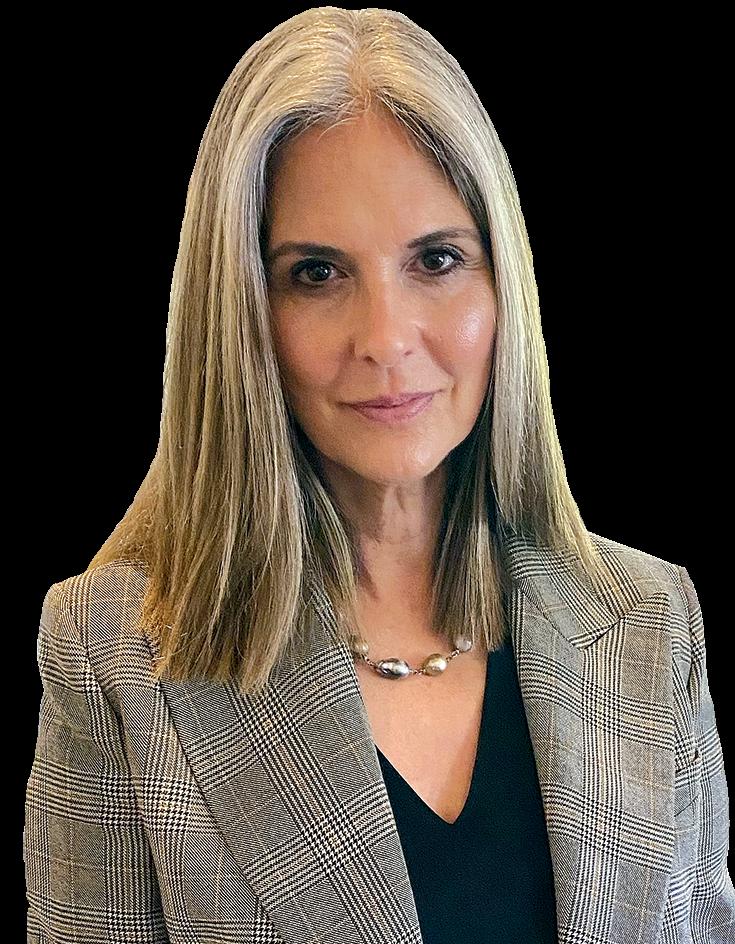
Igrew up in Los Angeles, went to college here, and even spent a good portion of my adult life in this city.
But the past four years of publishing this Los Angeles Giving List book has given me a new and fuller appreciation for the surprising sense of place and community that exists in a city with such vast and diverse neighborhoods and micro-cultures. But more than anything else, it is the passion and unrelenting commitment on the part of L.A.’s vital nonprofit and philanthropic ecosystems that is nothing short of extraordinary. The privilege of having a front-row seat to the work being done on the ground, and the unrelenting dedication on the part of your foundations and donor community to make that work possible, has been a world-class lesson in caring, compassion, and community.
Like so many places, Los Angeles is facing some of the biggest challenges in its history – challenges that pose a disproportionate threat to the city’s most vulnerable populations. I was grateful to be able to talk with Los Angeles Mayor Karen Bass, reflected in an interview in this book, about how addressing some of these core challenges – environmental, housing, mental health, addiction, poverty, women’s reproductive rights, etc. – depends so strongly on the safety nets being provided by your local nonprofits. It is the women and men in these organizations that for so many, stand between a healthy and safe path forward and an abyss that none of us want to consider. It is also the partnerships between your local government and L.A.’s vital philanthropic and nonprofit communities that are allowing for some of the most innovative solutions to these extraordinary challenges.
We hope you will take the time to read this book and to understand more deeply the vital work being done on the ground that desperately needs your support.
The Giving List was created to help nonprofits tell their powerful stories in a way that would allow donors to better understand and appreciate the critical services they provide. It was also intended to expose donors to nonprofits that may otherwise not make it onto their radar. We hope that this publication will help you break through some of the noise created by so many pressing needs.
Additionally, this Giving List would not be possible without the continued support of one of Los Angeles’s premier higher education institutions – California State University, Northridge (CSUN). As one of the nation’s top universities fostering social and economic mobility, CSUN transforms lives not only by delivering academic excellence, but by pioneering programs that open doors for a large first-generation student body.
Just a few words about the physical Giving List book itself. We think it’s important you know that all of our Giving List books are printed with pulp from responsibly managed forests (they have the FSC-certified label), which means they are made from partially recycled material, verified responsible sources, and committed to reversing deforestation. Also, we use U.S.-made soy ink. Soy ink, which compared to traditional petroleum-based ink, is more environmentally friendly. Soy ink also helps make The Giving List easier to recycle… when you’re done using it to give, of course.
And, finally, in an effort to make giving as easy as possible for everyone who picks up our book, we have enclosed an easy-to-tear-out envelope because every donation, no matter how big or how small, makes a difference to the diligent, hardworking nonprofits that are featured in these pages.
Please use and enjoy this lovingly produced book.
With Gratitude,
Gwyn Lurie CEO, The Montecito Journal Media Group

Are you interested in having your nonprofit appear in The Giving List? We are, too! We understand that there are thousands and thousands of vital nonprofits doing critical work in the community. While we rely on our years of work in the philanthropic community along with consultation with leaders in the philanthropic sector to select organizations to appear in our program, there are bound to be some very worthy organizations we will invariably miss.
Your nonprofit organization can apply directly to be in The Giving List by scanning the QR code below. It will direct you to an online form to fill out the required information. Once you’ve completed the form, you will immediately land on our radar for consideration in the next available Giving List book. Please note, we do independent vetting before extending invitations to nonprofits to appear in The Giving List.

We launched The Giving List to help the nonprofit organizations featured in this book spend less time fundraising and more time doing the critical work demanded of them.
Confronting the myriad and mounting challenges facing communities, the nation, and globe requires the ingenuity and dedication exhibited by the nonprofits that fill our pages. We have assembled their stories with the hope that you will see their value and invest in them.
A large proportion of the nonprofits we feature are smaller and more grassroots. This means that while they may have the ideas and leadership to forge change, they don’t necessarily have the diversified revenue streams to reach their fullest impact. We are hoping you will change that by donating and helping them secure the predictable, unrestricted revenue they need to focus on what’s most important: the work. With you, we have the chance to invest in organizations with the potential to take on some of our most pressing challenges.
Please join us by supporting your local nonprofits on the front lines of justice, whether that be fighting racism; using the arts to change culture; helping children, youth, and families in need; or striving to preserve our environment.
We will all be better for it.


An increasingly popular and efficient tool to manage your giving is a donoradvised fund, or DAF.
A DAF is like a charitable banking account, managed by a community foundation or by some of the world’s largest investment banking firms, where you can make a donation today and direct grants to worthy nonprofits later.
A key advantage with a DAF is that it allows you, the donor, to take a tax deduction in the year you donate money or complex assets, while not compelling you to distribute the money immediately. This can mean time to make more thoughtful decisions about how you want to direct your charitable contributions.
Many financial institutions and community foundations have low to zero start-up fees, making it possible for donors at any level to DAF.
doing good is living well
The Giving List was created to make it easier for you to navigate the dizzying array of worthwhile causes and nonprofit organizations. To that end, we have distributed The Giving List to people like you: individual donors, staff within the region’s small and large private foundations, and to philanthropic advisors, wealth managers, and estate planners.
As you dive into this book, we want to point out some of its unique features, and of The Giving List program as a whole.
Our partnerships with the nonprofits in these pages do not end with the printing of this book. Each profile will live on TheGivingList.com through 2025, where we will be updating each profile once a month so that you can continue to track the important ongoing work of each and every Giving List organization.
We hope that you will use the website as a guide not only for yourselves, but as an easy way to share the work of our partners – whether they be nonprofits, community foundations, or funder affinity groups – with your friends, family, and colleagues.
We are building a community of people who care deeply about philanthropy and understand the vital role it plays in our world, and we want you to join.
Since launching January of 2022, our bi-weekly newsletter, The Giving List Newsletter, has become a venue for updates from our nonprofit partners and stories from the frontlines of philanthropy.
We would love for you to join The Giving List Newsletter; please visit www.TheGivingList.com and follow the prompts.
You can also join our newsletter...

... by waving your phone’s camera over this QR code.


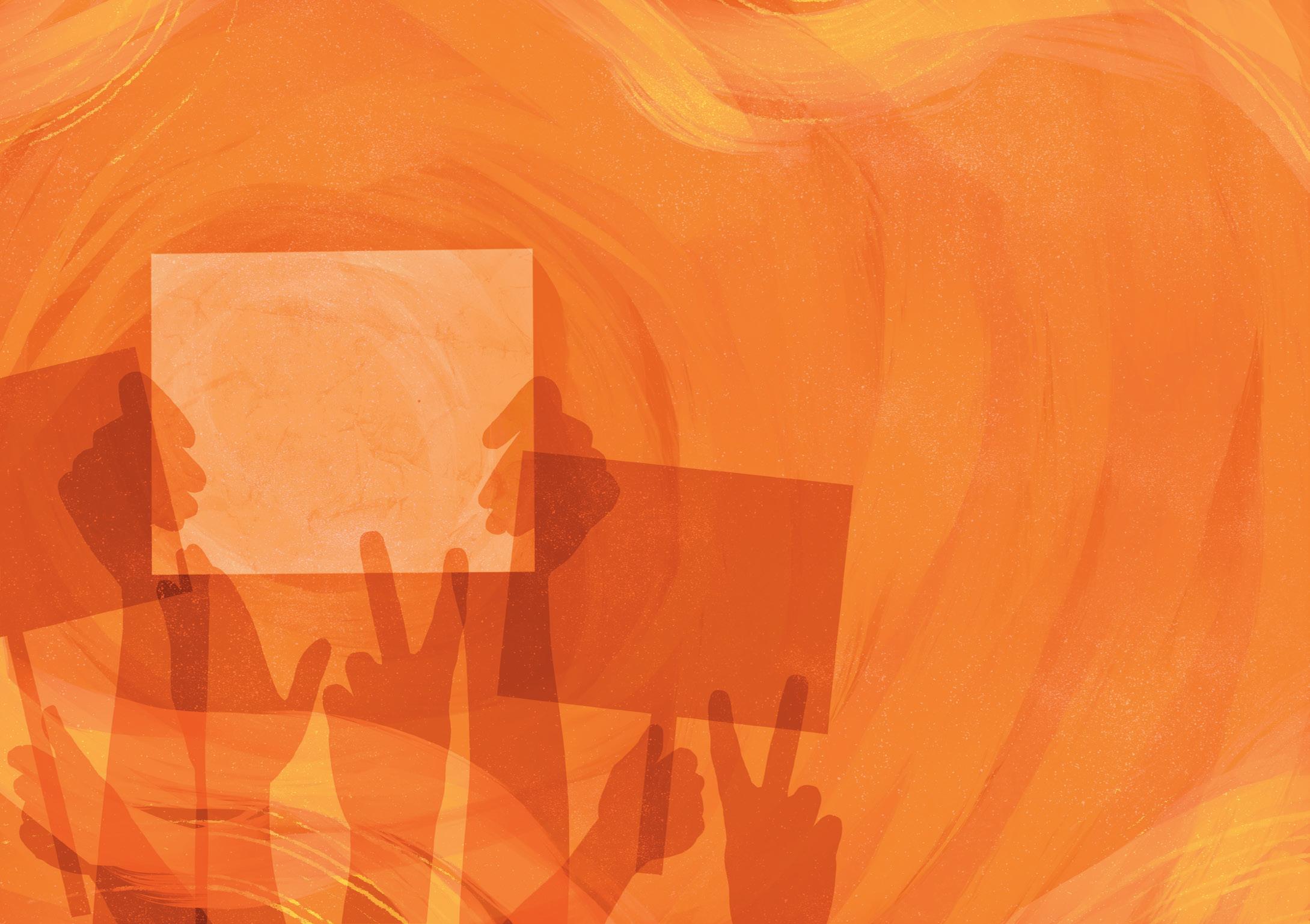
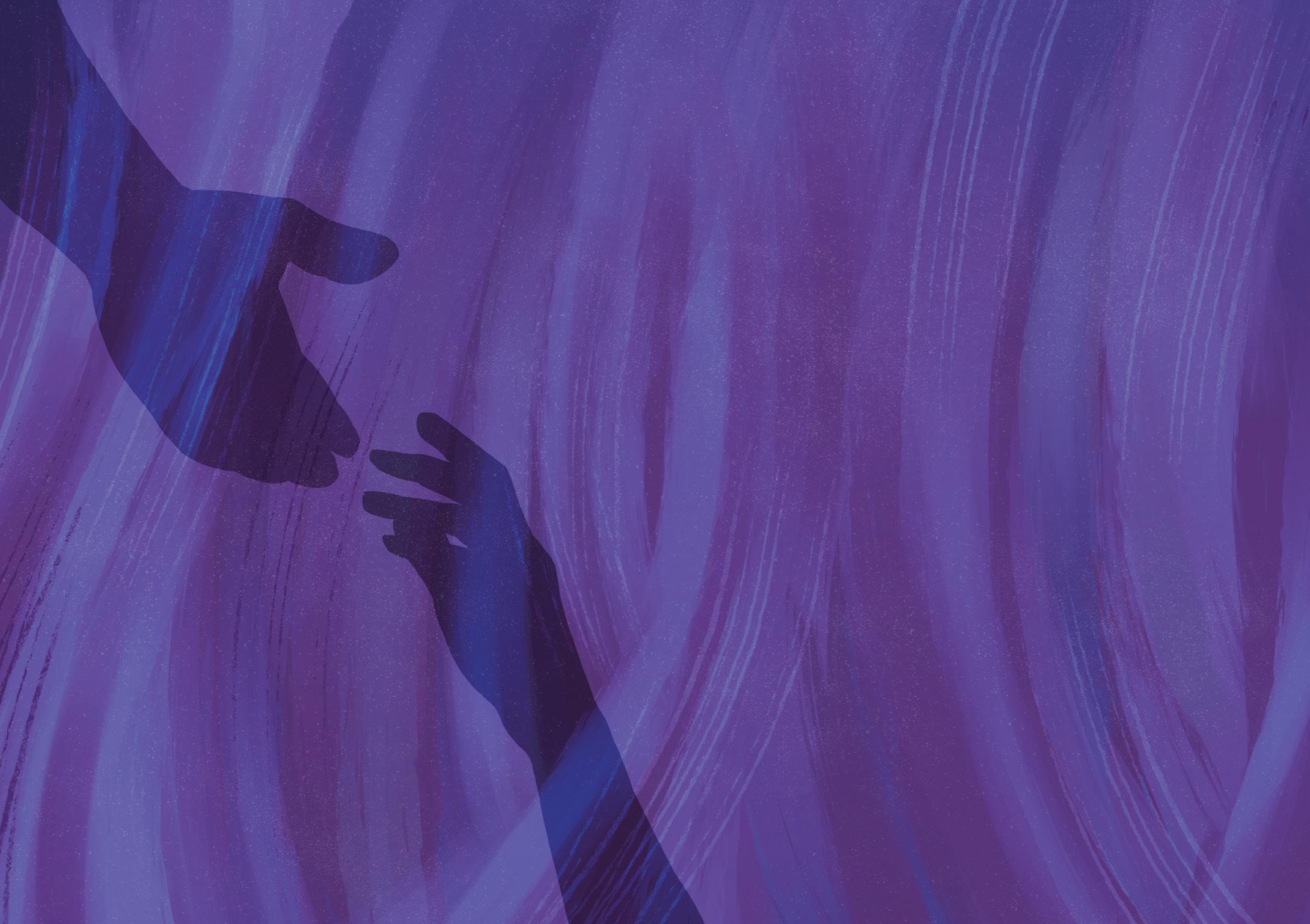

The Shortest Distance to Making a Difference, P. 14
California State University, Northridge (CSUN) – Social Mobility for the Future Leaders of Industry,
Conversations –Mayor Karen Bass: From Community Activist to Mayor, P. 30
ACCESS REPRODUCTIVE JUSTICE removes barriers to sexual and reproductive health care and builds the power of Californians to demand health, justice, and dignity
Griffith Observatory Foundation supports and promotes Griffith Observatory as a home for science literacy, education, and public astronomy through resource development and advocacy in partnership with the community
Housing Works creates housing and service options that model, with respect and dignity, sustainable, environmentally sensitive, affordable communities for people of limited resources
Conversations –Angel Martinez: From the Bronx to the Boardroom, P. 44
Brady: United Against Gun Violence unites people of all identities, races, and ethnicities from coast to coast, young and old, and everything in between, fed up and fired up, to protect our country from what is killing it: guns
Children’s Law Center of California provides legal representation for children and youth impacted by abuse and neglect
Social Justice Partners Los Angeles (SJPLA) connects people creating systems of care for the liberation of all Angelenos
Drug Awareness Foundation prevents addiction and drug-related deaths through education and awareness

58 For the Children
Editorial – From the Page to Impact Investing, P. 60
Karsh Family Social Service Center provides critical and accessible social services through direct service or collaboration with other


providers, while also integrating significant volunteer opportunities to create a uniquely powerful way to help repair the world
P� 64
Para Los Niños brings together education, early intervention, mental health, public health, community engagement, and leadership development to serve the whole child, whole family, and communities in which families reside
P� 66
P� 68
PRESENT NOW provides children living in transitional domestic violence shelters with experiences and gifts that bring them joy, comfort, and relief during a time of crisis
Vision To Learn provides vision screenings, eye exams, and glasses to children in lowincome communities, at no cost to the children or their families
P� 70
J3 Foundation gives kids the foundation they need for a lifetime of reading success
. P� 78
School on Wheels enhances educational opportunities for children who are experiencing homelessness from kindergarten through twelfth grade
Neighborhood Music School Association inspires minds and enriches the community through music education
P� 80
Citizen Schools empowers schools, districts, and communities to work together to create and sustain authentic experience-based learning opportunities
Matriculate connects high-achieving, lowincome juniors and seniors to highly-trained undergraduate advisors – completely virtually – empowering students to attend colleges where they will thrive
PUENTE Learning Center delivers educational programs for children, youth, and adults P� 94
Ready to Succeed empowers foster and first-generation college students to graduate college, launch successful careers, and reach their full potential




Conversations –Bonnie Davidoff and Janet Soffer: Empowering Women Through Collective Giving, P. 100

National Disaster Search Dog Foundation rescues and recruits dogs and partners them with firefighters and other first responders to find people buried alive in the wreckage of disasters . . . . . P� 104
Conversations –Dr. Sharon Nazarian: Bridging Worlds, P. 108
Mongabay improves widespread understanding of the forces undermining the health of Earth’s systems, making science accessible, and amplifying the voices and knowledge of those directly impacted by environmental change . P� 112
Sea Save Foundation generates consciousness and encourages stewardship of natural ecosystems while continuing with other charitable educational activities associated with this purpose .
. . . P� 114
Women’s March Foundation brings together people of all genders, ages, races, cultures, political affiliations, disabilities, and backgrounds to affirm shared humanity and pronounce the bold message of resistance and self-determination P� 116
Cancer Schmancer Movement saves lives by transforming the nation’s current sick care system into one that focuses on genuine health care P� 124
Global Parents for Eczema Research provides help with navigating the ups and downs of eczema and finding resources .
P� 126

UCLA Friends of Semel Institute supports research to advance innovative treatments and sponsor educational programs to raise awareness and erase stigma P� 128

By Dan Schifrin
In 2000, Judy Koch learned something surprising about many of the workers in her sheet metal factory in Fremont, California: They didn’t read books with their kids. As a former junior high English teacher now on a second career as a manufacturing CEO, Koch wanted to instill a love of reading in her employees. Her idea? Give away high-quality storybooks for free.
This simple act created a tidal wave of expanded family literacy among the mostly Latino men who worked on the factory floor.
Sterling Speirn, who was looking for innovative ideas as executive director of the Peninsula Community Foundation (now the Silicon Valley Community Foundation), was alerted to this experiment and quickly adopted it as part of the Foundation’s Center for Venture Philanthropy. A trial program with the San Mateo County library system was very successful, and the program continued to grow.
Twenty-five years later, this project – Raising a Reader – has changed the literacy and reading culture of more than a million families in 33 states. With its low-cost method for preparing children for kindergarten, Raising a Reader demonstrated that “reading time” fostered parent-child bonding as well as critical cognitive development.
“Judy used to tell me that when her employees went home at night, their children would run to the front door and say, ‘What book did you bring me, Daddy?’” Speirn recounts. By equipping them with books and bags, “she had made them heroes in their own homes.”
The success of this program reminded Speirn, who had also been a teacher before entering philanthropy, that the small step of exposing kids to reading early created long-lasting, permanent changes far beyond literacy.

Raising a Reader supports families to build, practice, and grow reading routines at home.
“If you want to do anti-poverty and racial justice work,” he adds, “a program like this is the most costeffective way.”
We live in a moment of radically expanding complexity. The volume of information (and misinformation) comes at us like a firehose from every screen, even as we try to adjust to accelerating social, political, environmental, and technological change. The question then becomes:
To learn more about joining The Giving List Community, please contact: vicki@thegivinglist�com
CEO & Founder Gwyn Lurie gwyn@montecitojournal.net
President & Founder Tim Buckley tim@montecitojournal.net
Executive Editor Vicki Horwits vicki@thegivinglist.com
Director of Partnerships & Operations
Jessikah Fechner jmoran@montecitojournal.net
Art Director Trent Watanabe
Deputy Art Director Stevie Acuña
Copy Editor Lily Buckley Harbin
Administration & Billing: Kassidy Craner frontdesk@montecitojournal.net
Contributors:
Anna Dimond, Stella Pierce, Dipti Vaidya, Jeff Wing, Brenda Gazzar, Kevin Lavelle, Gary Marks, Madeleine Connors, Brian Rinker, Zachary Bernstein, Dan Schifrin, Daniel Heimpel, Bea Tolan
the giving list
is published by: Montecito Journal Media Group, LLC.
Corporate Offices located at: 1206 Coast Village Circle, Suite G, Montecito, CA 93108
For inquiries: phone (805) 565-1860 email tim@thegivinglist.com


Beatrice Tolan’s work for The Giving List reflects her belief that art should invite empathy. “While creating the graphics,” she explains, “I decided to keep the subjects as silhouettes so anyone could identify with them. Instead, I made the backgrounds more detailed to capture the energetic spirit behind each nonprofit category.” This thoughtful approach highlights her ability to evoke emotion through simplicity, allowing the message to resonate universally.
A Los Angeles-based graphic designer and animator, Tolan grew up in Montecito and graduated cum laude from Northeastern University with a degree in Media Arts. Her creative pursuits go beyond digital art, encompassing abstract painting, songwriting, and writing.
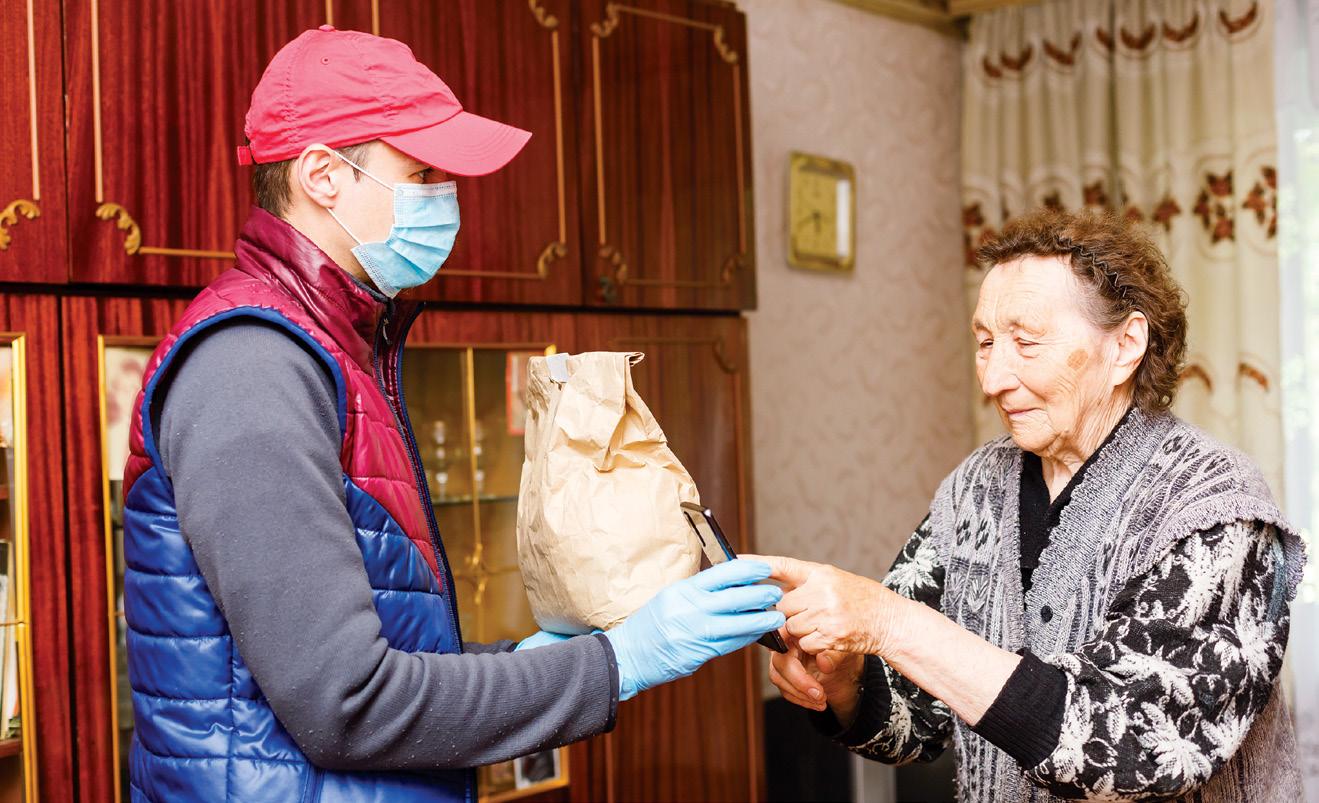
How do we make sense of our philanthropic choices as we seek to make meaningful change?
The success of Raising a Reader offers at least one major insight: No philanthropic step is too small, or too soon. And as Judy Koch demonstrated, starting with what is right in front of you is often the shortest distance to making a difference.
“Philanthropy is so personal. I always want to encourage donors to start where they are at, with the issues they are most passionate about,” says Tammy Sims Johnson, Vice President of Philanthropic Services at the Santa Barbara Foundation. By leaning into one’s passion, curiosity, and professional expertise, continues Johnson, donors “will find the niche where they can make a significant, meaningful difference, whether it’s small-scale or large-scale.”
Johnson points to the work of Carrie Towbes, Ph.D., a licensed clinical psychologist with expertise in children and youth. Her background as a special education teacher and her clinical experience in a wide array of settings including schools, hospitals, community clinics, and private practice, enhanced her awareness that local mental health professionals were burning out at an alarming rate, imperiling the entire system of support.
Trusting her experience, Towbes saw an opportunity for study and innovation that led to the creation of the 4R Fund, in partnership with the Santa Barbara Foundation, dedicated to the long-term, holistic support of mental health professionals. The 4R’s stand for recruit, retain, rest, and recuperation.
Towbes is also president of the Towbes Foundation, a multi-generational family foundation that has
One of Jewish Family & Community Services East Bay’s (JFCS) dedicated volunteers delivering nourishing meals to community members in need. JFCS is a community-based, direct social and human services organization that serves and supports Alameda and Contra Costa County residents of all ages, races, and religions. Their vision is a community where everyone can flourish with dignity.
generously supported many nonprofits in the Santa Barbara area. While the Towbes Foundation has historically funded many nonprofit sectors, they currently target Towbes’ areas of expertise. Towbes emphasizes that it was “my clinical experience that informed the direction of my philanthropy.”
The social and political developments of the last few years might prompt a contradictory response: How might we acknowledge the systemic, large-scale, often multi-generational nature of our problems, without losing sight of the tangible, concrete issues right in front of us?
Extraordinary gifts that can change the game are necessary contributions. Two recent examples, just in the healthcare field, include $1 billion donation donations from Dr. Ruth Gottesman to the Albert Einstein College of Medicine in the Bronx, and from Mike Bloomberg to the Johns Hopkins Medical School. These gifts will make it possible to educate a more economically diverse class of future physicians, which will in turn support more community clinics and improve the healthcare of communities of color.
At the same time, more modest gifts can have an incredible influence on smaller organizations. Sneha Dave is the 26-year-old founder and CEO of Generation Patient, an advocacy and support nonprofit serving young adults with chronic illnesses. In a recent essay in the Chronicle of
“The first step towards a big goal needs to be significant and worthwhile. It had better make a dent in the problem. But physics tells us that we just need to find a really really really small thing that gets us started and gets the chain reaction going.”
– Daniel Stillman, Conversation Factory

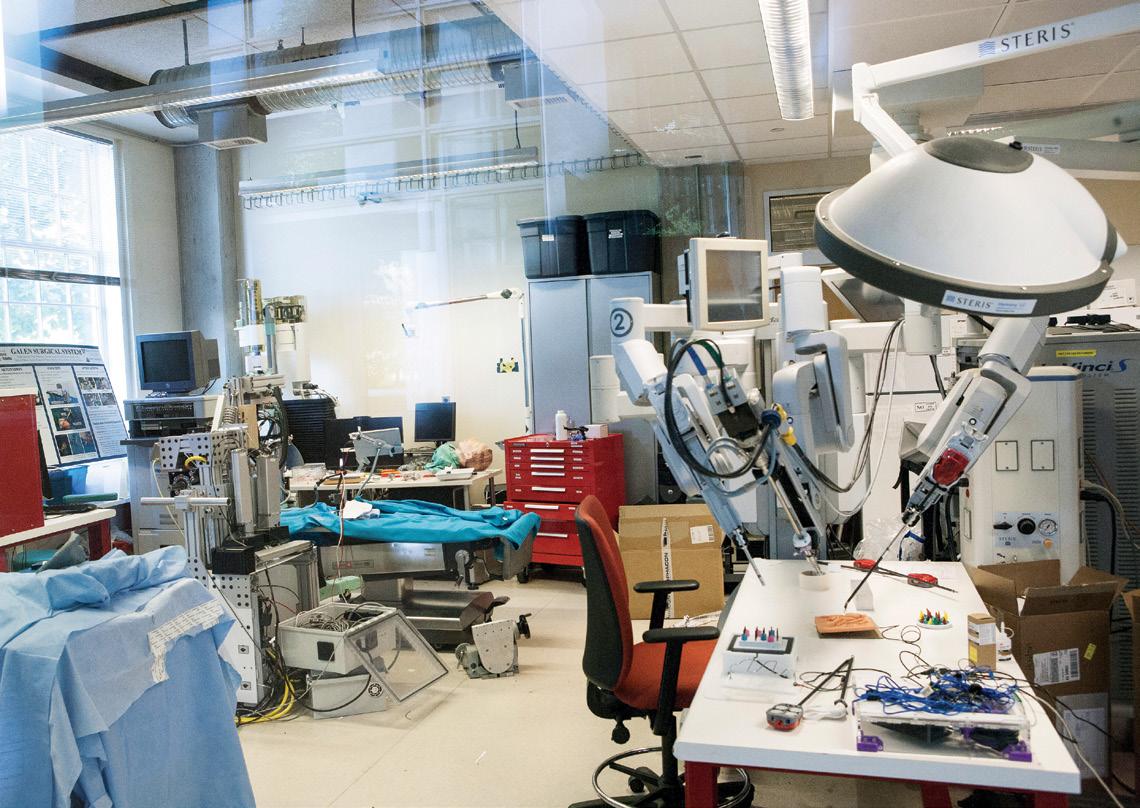

Bloomberg Philanthropies announced a transformative $1 billion gift to Johns Hopkins University, making medical school tuition-free for most students and expanding financial aid for students in nursing, public health, and other graduate programs.
Philanthropy, Dave makes the case that nonprofits with budgets under $1 million are often ineligible for certain kinds of grants. Dave points to MacKenzie Scott’s extremely generous funding of hundreds of nonprofits with grants of up to $2 million, which excluded lean organizations like hers, with a staff of three and an annual budget of $450,000.
In an interview, Dave said that most smaller organizations like hers depended on smaller donations, “which could make a huge impact on our work.” She encouraged donors to consider supporting less well-known organizations by helping with immediate needs that could lead to longer-term impact. In her Chronicle essay, Dave expressed gratitude for a foundation “which paid for a leadership transition consultant and executive coach for me. I’d never managed a staff nor had a manager myself, which made the additional coaching transformational.”
Or as organizational guru Daniel Stillman puts it in a recent blog post on his Conversation Factory website, we often think that “the first step towards
a big goal needs to be significant and worthwhile. It had better make a dent in the problem. But physics tells us that we just need to find a really really really small thing that gets us started and gets the chain reaction going.”
How big a reaction? “It’s hard to imagine, but starting with a domino just five millimeters tall, it would take just 29 progressively larger dominoes to knock over a domino the size of the Empire State Building.”
Robin Mencher, CEO of Jewish Family and Community Services East Bay, is eager to see largescale change that will be more supportive of those in need. That future, she believes, is likelier to take place “not through sudden, radical shifts, but through the accumulation of thousands of micro-changes.”
The reason? “Stability is a building block for bold change,” says Mencher, who notes that stability can

seem counterintuitive in nearby Silicon Valley, where “there is a culture of disrupting things and seeing what happens… But for charities and nonprofits to take ‘good’ risks, there needs to be stability. And nonprofits get stability by not having to worry about making payroll.”
In other parts of the charity ecosystem, huge impacts are being made by the accumulation of thousands of micro-donations. A recent NPR story highlights the incredible gains for nonprofits when customers “round up” a purchase as a gift. The Taco Bell Foundation, which funds nonprofits like
the Boys & Girls Clubs, noticed huge increases in donations when people had the opportunity to give less than a dollar. In 2019, the first year they tried this approach with the 7,500 U.S. restaurants, they doubled their contributions.
Bart Burstein and Leslie White created the Pace Able Foundation in Palo Alto to focus their support of nonprofits (and a few for-profits) in health, education, and capacity-building, mostly in the developing world. Burstein had a successful career in tech, and White worked in both education and tech before they retired to focus on philanthropy.
In other parts of the charity ecosystem, huge impacts are being made by the accumulation of thousands of micro-donations. A recent NPR story highlights the incredible gains for nonprofits when customers “round up” a purchase as a gift.

One of their advisors at the time was Judi Powell, founder and principal of Seven Hills Philanthropy, and previously a senior leader at Silicon Valley Community Foundation and Pacific Foundation Services. When they asked her for strategic advice, “Judi told us to give unrestrictedly. Try not to put too many impediments in the way of grantees.”
As they learned more about the organizations they wanted to support, they took this advice to heart, funding a targeted group of nonprofits, and creating an ongoing partnership based on trust.
“With all the problems we saw, we asked ourselves, ‘How can you bear to focus on just one thing, when there are 100 problems confronting you,’” Burstein says. An answer, he adds, came from philanthropist (and former President) Bill Clinton: “Do what you care about.”
In a recent essay in eJewish Philanthropy, Barry Finestone, president and CEO of the San Francisco-
based Jim Joseph Foundation, acknowledges these hundreds of problems at a moment of VUCA –volatility, uncertainty, complexity, and ambiguity. This term, originally used in the military, was introduced into leadership studies 40 years ago by University of Southern California professors William Bennis and Burt Nanus. Their argument was that effective leaders needed to avoid coveting simplicity at the expense of patience and self-reflection.
In his article, Finestone encourages philanthropy’s critical work of engaging complexity, which includes “strategic planning, and remaining focused on longterm goals and outcomes.” But he cautions that the perfect can be the enemy of the good, and that simply acting was sometimes the higher calling. “We need to train ourselves,” he writes, “to strengthen our adaptive ‘muscles’ so we are ready to quickly and effectively react to issues and unanticipated developments in as close to real-time as possible.”


Across town from where Bennis and Nanus taught, on the Great Lawn of the West Los Angeles VA Medical Center at San Vicente and Wilshire, hundreds of struggling veterans have been waiting, sometimes for many years, for adequate housing within which they can heal and receive the care they need. Their experiences are the epitome of VUCA.
The visual overwhelm of so many unhoused neighbors evokes a hopelessness with the scope and scale of America’s social problems, and radical uncertainty as to what we can do, even as we motor to work in our air-conditioned cars.
In 2021, as part of a movement toward quickly offering “tiny homes,” the agency decided to replace tents with small but functional home-lets, moving past the immense complications and delays of wellmeaning environmental and financial requirements.
The results were striking, if still small-scale, leading to improved physical and mental health, and more positive social engagement. John Kuhn, Deputy Medical Center Director for the VA Greater Los Angeles Healthcare System (VAGLAHS), acknowledges that “while this resource by itself does not solve homelessness… it is a critical tool to ensure safety.” By moving the process forward in a simple, meaningful way toward permanent housing, the VA “will offer Veterans a path to that destination.”
Many of our social problems, research shows, are a result of a simple lack of connection. COVID made clear, and in many cases accelerated, an epidemic of American loneliness that directly correlates with mental illness, frayed social bonds, and even obesity. Social media, despite including the word “social,” has compounded that effect.
Funders, especially new ones, often see positive results when they simply get together to talk about giving – and then go ahead and give. Among the most effective social vehicles for funders, philanthropic advisor Judi Powell says, is the giving circle.
“For funders, especially first-time funders who might still be anxious about doing this ‘right,’ these relationships are really important,” she says. Among other things, these relationships “help
build confidence and are an invaluable source of information about how to give and where to give. And of course they amplify the impact of a single funder by pooling the funds of many.”
The San Francisco based Jewish Community Federation and Endowment Fund (JCF), which raises and distributes funds for a variety of Bay Area and Israel-connected organizations, has leaned into the value of “social giving,” especially among younger donors.
“Our giving circles, which empower people of all ages, backgrounds, and incomes to actively participate in philanthropy, support individuals in coming together to pool their charitable funds, discuss shared values, learn about inspirational organizations, and make collective decisions about which organizations to fund,” said Rebecca Randall, Chief Philanthropy Officer of the Jewish Community Federation and Endowment Fund.
A young adult giving circle called The Bay Area Tribe, co-chaired by Moriah Jacobs, found that the simplest way to move from anxiety and uncertainty to productive action was coming together. The giving circle, she says, was “a safe and open space for people to be vulnerable and honest, which contributed to a really productive and engaged group.”
There is no one-size-fits-all philanthropy. Some people and institutions like to spread their bets, while others prefer to go deeply into one issue or community. Some look to explicitly change the game, while their peers seek to amplify what’s already working. In the end, the best and simplest solution is just to get to work.
By Zachary Bernstein

Nichole Ipach, Vice President of University Relations & Advancement at California State University, Northridge (CSUN), has a favorite fact she likes to point out about the grand numerical reach of the CSUN alumni. “The number of alumni we have out in the world
is close to the size of the population of Miami,” says Ipach. “And in the Los Angeles area, there’s virtually nowhere our alumni are not. We do a lot and we do it in our own way.”
Ipach holds another title as President of the CSUN Foundation. In service to CSUN’s student body and its Miami-sized diaspora, the CSUN Foundation operates as the charitable arm of the robust educational institution and acts as the philanthropic leadership for the university. The foundation is devoted to empowering its students and their families by supporting them as they pursue a higher education.
As an institution, CSUN is home to a widely diverse student body, many of which are first-generation college attendees within their families. CSUN students also come from varied financial backgrounds, and some arrive to the classroom amid non-traditional student circumstances. What attracts many of these students to CSUN are the opportunities, access, and support that CSUN and the CSUN Foundation provide. “They have the ability,” says Ipach. “They have the academic aptitude, they’re talented, they have all the qualities you want in a college student, but they’re also dealing with some inequities.”
Despite those inequities, CSUN knows the needs of its students and has a reputation for helping their students level up. Indeed, the Wall Street Journal ranked CSUN as 9th in the country for social mobility, a reflection of the university’s commitment to its mission.
“We’re taking this population of sometimes limited means, putting them through exceptional academic programs, and then when they graduate, they go out, get careers, and become leaders of industry,” Ipach says. “One of the purposes of bringing in philanthropy is to support that effort.”
The CSUN Foundation measures its success by the impact it makes on the university community at large. Sometimes that can mean the kind of large donor gifts that make new buildings happen, but just as important are the smaller donations that sustain the school’s ongoing programs.
“Often, impact correlates to big transformational gifts,” says Ipach. “Those without a doubt propel us forward in major ways, but it doesn’t always have to be those giant gifts that help us make a big leap forward.”
Scholarships are among the more prominent major beneficiaries of small donations and individual scholarships can usually range anywhere from as low as $1,000 to upwards of $10,000. And while it’s absolutely true that scholarships substantially reduce a student’s debt, that shouldn’t overshadow the less-obvious benefits: Scholarships can be the linchpin for maintaining a student’s enrollment; allowing students less dependency on part-time and full-time jobs, time to take more classes and possibly graduate sooner, and the peace of mind afforded to focus more on academic studies than on financial burden. Scholarships also foster success. To put it bluntly, students receiving scholarships overall
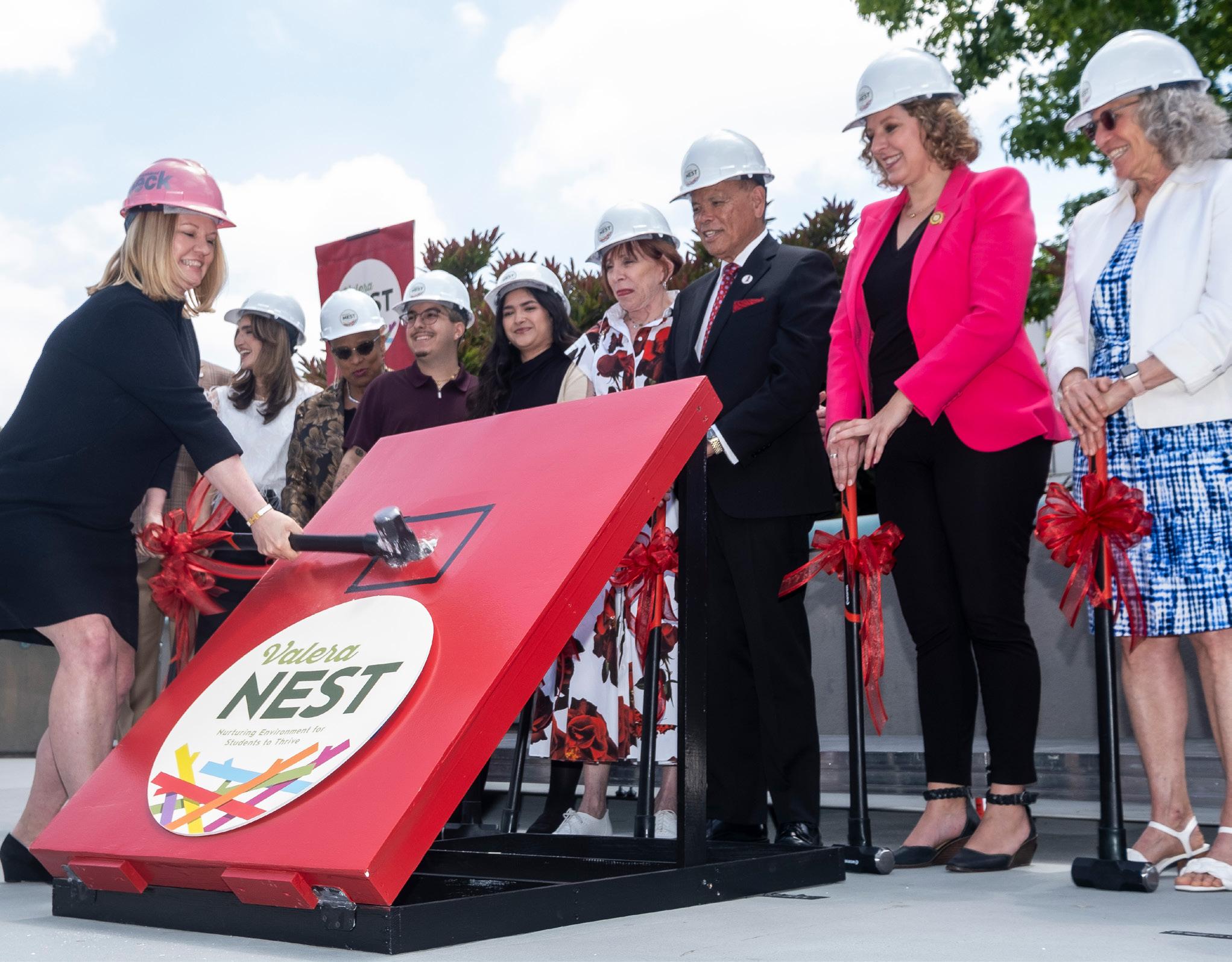
Dupre Orr always wanted to study biology, and at CSUN he was able to make that happen. At CSUN, says Orr, “They really want to see you succeed.”
His biggest challenge was balancing school while working as a security guard at a Kaiser Permanente urgent care facility. In that position, Orr was able to see how patients were managed by different doctors. Eventually, he saw himself taking on that role.
Helping to subsidize his education, Orr was supported by the James R. Simpson scholarship and also received funding from LSAMP (Louis Stokes Alliances for Minority Participation). This funding was pivotal to Orr’s research, his ability to attend conferences, and for making presentations.
“Philanthropy removes the burden that people might experience not being able to have the resources necessary for them to reach their end goal,” says Orr.
Now a student at UCLA’s David Geffen School of Medicine, Orr aspires to work with underserved communities in populations hindered by different healthcare disparities. Says Orr, “I want to break those barriers to help them solve those issues.”
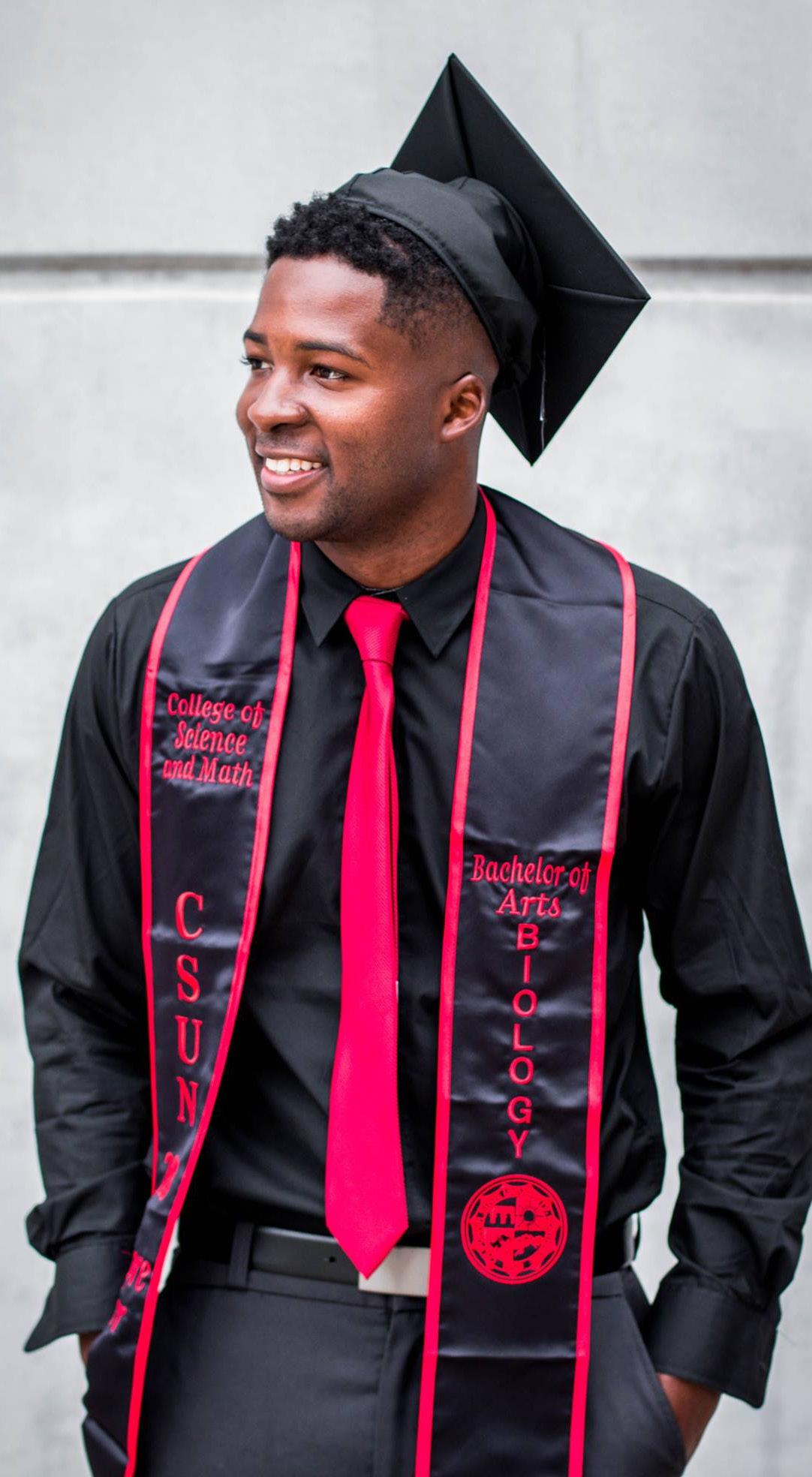
have better GPA scores than those getting by without. Consider the case of Danny Bustos (‘20), a recipient of the school’s top award for graduating seniors, the Wolfson Scholar Award. As a student of CSUN’s David Nazarian School of Business and Economics, Bustos excelled as a triple major in finance, accountancy, and business administration. According to Bustos, achieving the hat trick of graduating as a triple major could not have been possible without his academic career being subsidized by small donation-funded scholarships. Today, the 26-year-old Bustos works in the private equity industry and has created his own scholarship, the Bustos Family Scholarship, paying it forward to the next generation of students so they can have the same opportunities as he did.
When more students can benefit, small donations rise to the occasion. On a slightly grander scale, one could turn to the success of CSUN’s math tutoring centers, which have been integral for maintaining a robust culture of STEM learning and achievement, assisting students preparing for their math placement tests. These programs are powered by the Dale and Sheila Blommendahl Peer Mentoring Endowment, which helps to fund both the student tutors and the


tutoring center’s computing power.
“It’s an example of the kind of small gift somebody could make that could change the course of someone’s life for the better,” Ipach says. “We believe our students deserve a certain margin of excellence, and small donor philanthropy can make that happen.”
It’s worth pointing out that CSUN, being a California state institution, is a recipient of state funding, but that money is highly regulated and not always so dependable. “We appreciate the state of California and what they can do,” says Ipach, “But state dollars fluctuate. They’re here one day, and they’re talking about cuts the next day. They don’t provide us with the flexibility that we need to adequately fund initiatives like paid internships and undergraduate research. Private donations don’t have the same restrictions or limitations.”
If the state of California can sometimes experience

Omoné O. Livingston always had a huge passion for building and creating things, so she came to study at CSUN to follow her dream of becoming an engineer, eventually earning a bachelor’s of science degree in civil and structural engineering.
She knew that at the right point in her career, she would establish a scholarship for future CSUN students, particularly to help women of color and underprivileged students succeed in their academic pursuits. As founder, president, and CEO of O2 Engineering, Projects, and Construction Management, she has followed through with that promise.
“I’d rather not go on vacation for [students] to graduate and have food on their table,” says Livingston. “When you talk about philanthropy, it’s important. If everybody gives a dollar or two to those that are in need, do you know how much impact that would make in the world? A lot!”
Every year, CSUN invites engineering industry folks like Livingston to judge senior design projects by students in the College of Engineering and Computer Science. There, she gets to see the future of engineering and meet the kinds of students she herself has helped support.

financial uncertainty, so too can the average college student. Demonstrating an institutional awareness about the needs of some of their students, the CSUN Foundation developed what’s to be called the Valera NEST (Nurturing Environment for Students to Thrive), a centralized resource center devoted to assisting students in the non-academic, but equally important, realms of food, clothing, and wellness. Set to open in the fall of 2025, the Valera NEST is the perfect example of private and state funding coming together to help CSUN students succeed. Alumni champions Milt Valera (‘68) and Rick and Barbara
Levy (‘74 and ‘74) pulled together their donations in tandem with secured government funding courtesy of Assemblywoman Pilar Schiavo to create a resource facility that will be vital to those in need.
Looking towards the future, CSUN wants to refine their philanthropic ventures to cater even more to the needs of their students, but that doesn’t necessarily mean relying only upon the most generous of large donors. “Small donors are not small!” says Ipach. “Donors who give at any amount are incredibly meaningful to us. We don’t take it for granted; they are propelling us forward.”

Nichole Ipach President
Nichole.Ipach@csun.edu www.csun.edu/foundation (818) 677-4400 18111 Nordhoff Street, Northridge, CA 91330 Tax ID# 95-6196006


There is no greater gift than reaching out one’s hand to another in need and saying, “Here, let me help you.” The simplest of statements with the greatest of impacts.

Los Angeles Mayor Karen Bass’s approach to leading the country’s second largest city is deeply informed by her professional journey that spans a wide spectrum of public service. From health worker to community activist to holding multiple high level elected offices, including serving in California’s State Assembly, ultimately as its Speaker, six terms in the U.S. Congress, and now as L.A.’s first female and only second Black mayor, Bass has long had a front-row seat to L.A.’s most pressing issues.
Born and raised in Los Angeles, Mayor Bass’s formative years were shaped by significant social and political upheaval, including the civil rights movement and the
Vietnam War. These watershed historical periods profoundly framed her worldview and set the stage for her long-standing activism and leadership in Los Angeles. Bass’s public service journey is marked by a consistent focus on addressing systemic issues, beginning with her career in healthcare as a nurse and physician assistant before founding the Community Coalition in response to the crack cocaine epidemic of the 1980s. Her work in community organizing led her to politics, through which she has championed causes such as foster care reform, substance abuse prevention, and community-based solutions to a plethora of social problems she prioritizes, like homelessness and mental health.
“But one thing that is so important about the philanthropic world is that you are able to experiment through philanthropy and then you can fight for adoption on the policy level.”
Because of Mayor Bass’s emphasis on collaboration, intersectionality, and addressing root causes of
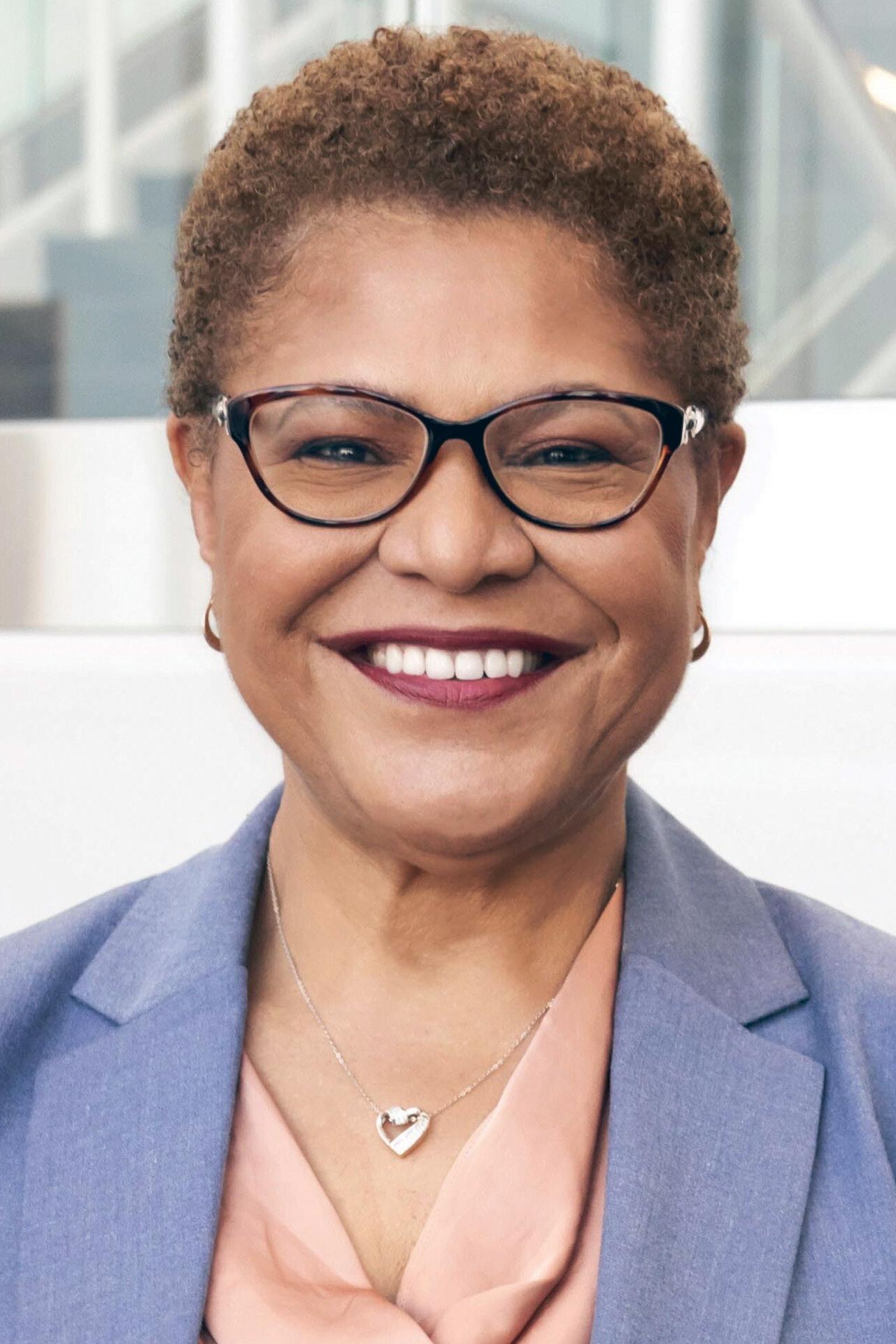

“I think sometimes donors shy away from certain issues because they seem unsolvable. And I think homelessness is one, for example. And I would just ask donors to look carefully at the issue of homelessness because there are pieces, sectors of homelessness that when support is asked for, it’s not ‘come to the table to solve the overall problem,’ but ‘please make a contribution right here.’”
The catch was no one told me that was how you could make a living. And so it never dawned on me to work to fight for justice for a living. So I was driven to the healthcare field. One, because I was always interested in science, especially anatomy and physiology. So I went into nursing. My goal actually was to be a physician assistant. So I spent several years as a nurse, then went back to school, became a PA [physician assistant], and then started teaching in the PA profession and also working at County USC hospital with students.
And then when the ‘80s hit, in the late 80’s the crack cocaine epidemic destroyed communities. I became obsessed. It was two epidemics that were happening at the same time, the epidemic of addiction and the epidemic of AIDS. And those together, to me, spelled a catastrophe, especially for inner-city Los Angeles. So I started the Community Coalition, wanting to shift the agenda away from what would later be called mass incarceration. With a health background, I saw crack and gang violence and AIDS as public health issues that were being addressed through a law enforcement lens only.
And so ironically, that was what drove me. And through my life’s journey, I’ve always been driven by issues. I’ve never been driven by titles or positions. I never thought I would run for office. But my goal at Community Coalition was to start an organization, to build it, to create the next generation of leaders, and then to lead the organization to demonstrate that the organization could live without me and
could develop a life of its own. And I ran for the State Assembly to deal with the same issues I was dealing with in the community.
Q: How did your career evolve from there to becoming mayor?
A: I’ve always worked on the same issues, and ironically, my life has come full circle right now because serving as mayor, I’m now in the catbird seat to address the issues I was trying to address 34 years ago. Homelessness didn’t start yesterday. It started with crack cocaine and we were trying to address it then. We were trying to move people out of the street into motels. Everybody thought that was a silly idea. COVID comes along and I’m doing that exact thing right now. It’s moving people off the street into motels. But I’m in a position of authority now, so I can actually carry out some of the things I was attempting to do as an activist.
Q: Can you talk about partnerships between nonprofit efforts, philanthropic efforts, and government? Are there opportunities for more public-private partnerships?
A: Well, one of the things that I really hope to do as mayor is be a champion for nonprofits because I understand [them] having run more than one, having started several. I think that the nonprofit world plays a tremendous role and so does philanthropy. And the two are obviously connected.



we want to blame them, or we want to blame the social service organizations when the person walks away from their housing and goes back on the street.
Q: Can you talk about the mental health crisis and its interconnectedness with other issues?
A: Yeah, let me say philosophically, in the United States, we do not have a coherent mental health system. So surprise, surprise, people are walking around with mental illness. We dismantled the system and then we privatized the system, and then we monetized the system and then we go, “Gee, we don’t have a mental health system.” What we do have is a jail system. And that’s what we as a society have, not consciously, but that’s been the effect of what we’ve done, is that people cycle in and out of jail and their mental illness is never really treated in any kind of sustainable way.
So that’s philosophically what I say to people who assume that everybody on the street is mentally ill. One is, it’s a chicken and egg thing. So go out and pitch a tent for two weeks and tell me if your mental health is the same as it was. Anybody’s mental health is compromised living like that, and some people to greater degrees than others. There’s a lot of different categories of homeless people. Some people, their mental health is okay, they just need first and last month’s rent or better credit, and they would be off the street. But my overall statement is that we do not
have a coherent mental health system in the United States in the 21st century.
Q: Do you think that governments and nonprofits take an intersectional enough approach to problem-solving?
A: I think they do somewhat, but I don’t think it’s necessarily a very deep look, meaning that it’s easy to see the connections, but the question is, where do the connections come from? What were the policies that led to this? So maybe people think interconnection, but I don’t think people think historical context.
I always think it’s important to draw connections, absolutely – equally as important to understand are the origins of what you are connecting. We can talk homelessness if we want. And we all know we were just talking about the interconnection between homelessness and mental health. We can throw in substance abuse if you want, but what are the origins of these problems? When did the mental health system get dismantled and why? When did the substance abuse system get essentially dismantled and shrunk?
I remember when welfare reform was being posed, being discussed as a national policy, and we were at Community Coalition when Congress and the Clinton administration were looking at it. We were very much opposed to it. Why? Because we believed that if welfare reform went through, then the economy
“Let me say
philosophically,
in the United States, we do not have a coherent mental health system.
So surprise, surprise, people are walking around with mental illness. We dismantled the system and then we privatized the system, and then we monetized the


“Iam honored to support ACCESS RJ because they do the critical work of making abortion available to those who have the hardest time accessing it, and they continually advocate to make abortion a ordable and accessible for everyone who needs one, no matter their reason. ACCESS RJ has long been a model for the rest of the country in how to incorporate the principles of reproductive justice into practical support and abortion care. I have the deepest trust and confidence that ACCESS RJ will continue to serve as a model as we navigate the current chaotic and heartbreaking reality of unequal abortion access in our country.”
– Zoe Mercer-Golden Women’s Donor Network
By Check:
ACCESS REPRODUCTIVE JUSTICE
P.O. BOX 3609 Oakland, CA 94609
*Donation Memo: The Giving List
By DAF or Stock Transfer: Tax ID# EIN: 51-0163201
By Credit Card: accessrj.org/take-action/donate/
Contact: Jessica Pinckney Gil Executive Director Phone: (510) 456-0947 jessica.pinckney@accessrj.org
ACCESS REPRODUCTIVE JUSTICE accessrj.org
P.O. BOX 3609
Oakland, CA 94609
Phone: (510) 923-0739

Last year, the nonprofit ACCESS REPRODUCTIVE JUSTICE
(ACCESS RJ) helped more than 1,865 people access abortion care and other reproductive health care services in California. That was a 160% increase year-over-year since Dobbs, the Supreme Court’s 2022 decision to overturn constitutional protection of abortion rights. ACCESS RJ is California’s statewide 30-yearold abortion fund, and it expects the number of people supported to only increase – not just from people crossing state lines, but also within the state.
ACCESS RJ not only funds abortion, but also helps people with the logistics and finances required to find and receive abortion care. They support everything from transportation and lodging to finding a clinic to accessing childcare during procedures and covering payment gaps for medication.
At ACCESS RJ, the first step for those seeking support is the organization’s Healthline, a multilingual intake line (as well as an online form and text service) that establishes what each person might need.
“Abortion funding is an art, not a science,” says Jessica Pinckney Gil, executive director of the organization. Each case is unique, and each case is emotional and crucial to those going through it.
“So much depends on the individual’s experience,” Pinckney Gil says. “How old they are, whether they live in the state or not, their accessibility to resources –both tangible and financial – where they are emotionally. Because of the abortion access landscape, within California and throughout the country, you’re going to have a lot more options if you’re six weeks pregnant than if you’re 26 weeks pregnant. There are a lot of variables at play – that’s important context to understand about our work.”
In terms of financial support, ACCESS RJ can cover the gap (sometimes only partially) in what a person can pay for their abortion, from a clinic visit to a discount code for pills. It also provides practical and logistical support, coordinating and paying for airfare, ground transport, lodging, childcare, and food not only for the person seeking support but also for
(ACCESS RJ) has been in operation for three decades, demand for its services has only increased since the Supreme Court Dobbs decision.
One of the organization’s challenges is that it can’t fulfill all of the procedural funding requests it receives.
“The resources that ACCESS has at our disposal,” says Pinckney Gil, “are going directly to helping people get the care they need.”
An additional $1M would allow ACCESS RJ to fully fund all its callers’ procedural funding gaps. Procedures (within California and outside of the state) range in cost from a few hundred dollars to upwards of $20,000. Currently, ACCESS RJ can only partially support many clients with covering the gap in procedural costs.
their support person – a spouse, friend, or family member.
Travel arrangements and costs aren’t just for people coming from out of state. Within California, sometimes the nearest abortion clinic is a twoor three-hour drive away. Fuel costs, accommodations, and logistics all come into play.
“Even in California, there are still barriers to accessing abortion,” says Pinckney Gil.
These logistical details, however functional, add up to healthier, happier life outcomes. According to the Turnaway Study, a 2020 report from the University of California San Francisco, people who are denied abortions tend to experience more poverty, more evictions, more
We supported more than 1,800 individuals across the state and country to access abortion care and other reproductive healthcare services — an increase of over 160% since the overturning of Roe v. Wade.

domestic violence, and more health issues during and after pregnancy.
Yet that’s only a hint at what may be ahead. Pinckney Gil notes that the report studied the experiences of people under Roe v. Wade, under which abortion was protected. Now that it’s been overturned, outcomes for those who can’t access abortions – and their children – may get worse.
“Reproductive Justice is everything,” says Pinckney Gil. “It is intersectional. You don’t have the ability to choose how you raise your family if you don’t have access to clean drinking water. You don’t have access to safe communities to raise your family in if your community is riddled with gun violence… So it’s holistic and really looking at people’s whole lives and whole experiences.”
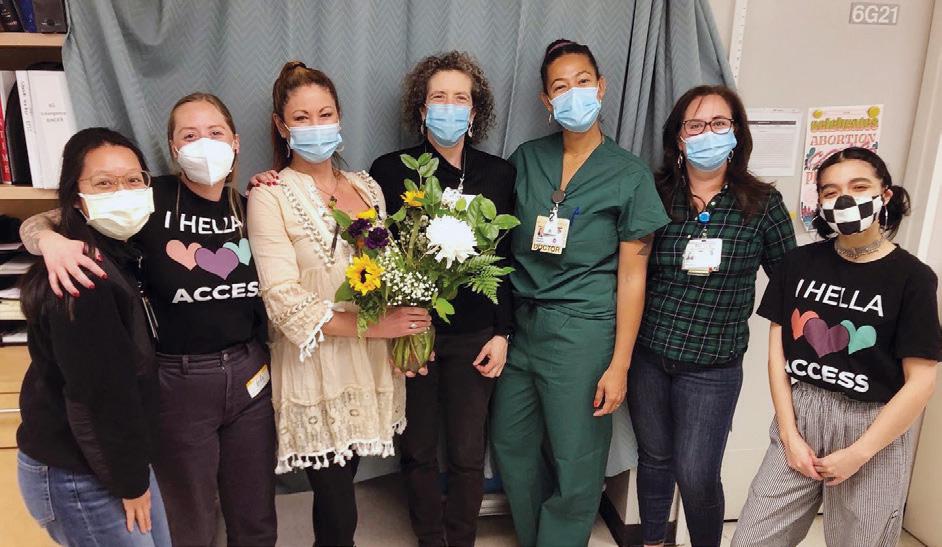
This is a critical time to protect access to abortion and reproductive health care; to fully cover the cost of reproductive health care for our callers ACCESS REPRODUCTIVE JUSTICE would need $500,000 to $1 million.

KEY SUPPORTERS
Women's Donor Network
The Women's Foundation of California
Argosy Foundation
Levi Strauss Foundation
National Institute for Reproductive Health
Planned Parenthood Federation of America

In-Person School Program participants walk the orbit lines on Gri th Observatory’s lawn with a Museum Guide.

By Check:
Gri th Observatory Foundation
2800 East Observatory Road Los Angeles, CA 90027
*Donation Memo: The Giving List
By DAF or Stock Transfer: Tax ID# 95-3374645
By Credit Card: www.Gri thObservatoryFoundation.org
Contact: Melanie Flavin Director of Development (213) 473-0878
mflavin@gri thobservatory foundation.org
Gri th Observatory Foundation
Gri thObservatoryFoundation.org
2800 East Observatory Road Los Angeles, CA 90027 (213) 473-0879

Griffith Observatory is an iconic feature of the local landscape and a beacon that reminds us we are all connected to the cosmos and to each other. Over 1.6 million people visit each year, but few are familiar with the Observatory’s founding vision and the community support needed to realize that vision and keep it shining brightly for the world.
In the early 1900s, Griffith J. Griffith had a life-changing experience when he looked through a research telescope at Mount Wilson Observatory in the nearby San Gabriel Mountains. When he saw the rings of Saturn with his own eye, he said, “If all mankind could look through this telescope, it would change the world.”
It became Griffith’s dream to make this profound experience available to the public. He envisioned an observatory where instruments of observation were free and everyone had the opportunity to observe the sky. Since opening its doors in 1935, that is exactly what Griffith Observatory has done.
Perched on the southern slope of Mount Hollywood in Griffith Park, the Observatory welcomes visitors from near and far to see awe-inspiring shows in
the historic Samuel Oschin Planetarium, interact with exhibits of various scientific subjects, and come together to ask questions about the Universe and our place in it.
Gri th Observatory is owned and operated by the City of Los Angeles, Department of Recreation and Parks and, as such, subject to competition for limited public resources. In order to flourish, the Observatory relies on essential support from its exclusive nonprofit partner, Gri th Observatory Foundation.
Since 1978, the Foundation has provided the support necessary to promote, advance, and preserve this gift to our great city. The Foundation is a network of individual donors and funders dedicated to ensuring the future of public astronomy for all.
“We are a community unified under the stars,” explains the Foundation’s Director of Development Melanie Flavin. “Our supporters are dedicated to the greater good, passionate about science literacy, and share a hopeful vision for the future.”
When asked about the Foundation’s mission to promote science literacy, Flavin describes astronomy as a “gateway” science that captivates and propels curiosity.

Grith Observatory is unrivaled in its position as the most visited public observatory in the world. It operates six days a week, steadfast in its mission of inspiring everyone to observe, ponder, and understand the sky. Maintaining this historic building, its instruments, theaters, and its programs, requires robust community support.
Foundation donors ensure that this iconic institution has the support it needs. There are many pathways to contribute:
• Vanguard Society donors pledge $5,000 annually, ensuring the Observatory can continually deliver high-impact programming.
• Infinity Society members make planned gifts, helping to sustain Gri th Observatory for generations to come.
• Direct donations are investments in the future of this institution and its mission.
Join the mission at www.Gri thObservatoryFoundation.org.
“You see these lightbulb moments in visitors of all ages, but especially with children. There’s this instant where something clicks and they start to wonder what else there is to discover. That spark of inquiry and curiosity is what we’re after, and it is so satisfying to witness,” says Flavin.
Visitors of all ages flock to the Observatory from all over Southern California and from around the world to enjoy this space together and be in awe of the wonders of the cosmos and the sky. Everyone who visits has access to live talks and demonstrations presented
by Griffith Observatory Museum Guides and Telescope Demonstrators as well as opportunities for live observing with the building’s public instruments, just as Griffith J. Griffith envisioned it over a century ago.
“Investing in science literacy and free access to accurate scientific content is an investment in our collective future,” says Flavin. “I think that motivates many of our supporters. Griffith Observatory delivers impact that is both far-reaching and deeply personal. Foundation donors ensure that will continue for the next generation.”


“W ith heartfelt gratitude, I thank Gri th Observatory Foundation for helping continue my husband’s legacy. Sam wanted to motivate the next generation to follow their innate curiosity and seek knowledge. He had a great passion for discovery, math, science, and astronomy.”
Benefactor and Chair of the Mr. and Mrs. Samuel Oschin Family Foundation
The Ahmanson Foundation
The Rose Hills Foundation
The Ralph M. Parsons Foundation
W.M. Keck Foundation
Getty Foundation
The Otis Booth Foundation
Boeing
Lockheed Martin

Gri th Observatory Foundation supports and promotes the Observatory as a home for science literacy, education, and public astronomy through resource development and partnership with the community.
The historic Zeiss telescope at Gri th Observatory is the most-looked-through telescope in the world.
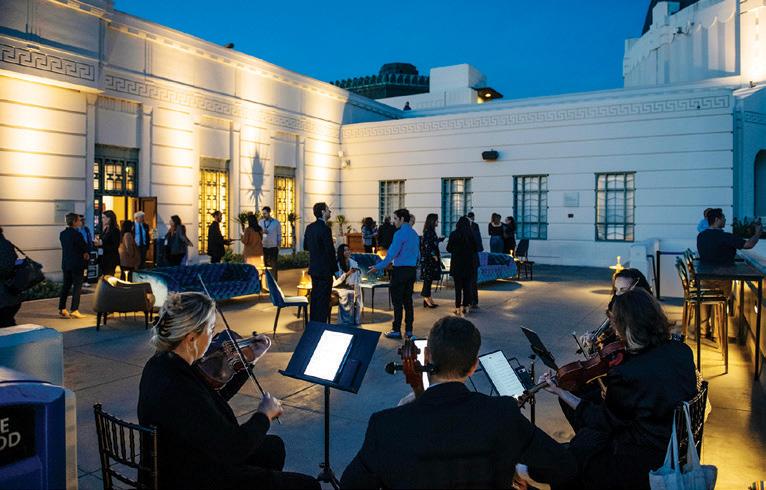


By Check: Housing Works 121 N. Avenue 59
Los Angeles, CA 90042
*Donation Memo: The Giving List
By DAF or Stock Transfer:
Tax ID# 03-0522656
By Credit Card: housingworksca.org/donatenow
Contact: Celina Alvarez Executive Director calvarez@housingworksca.org
Housing Works www.housingworksca.org 121 N. Avenue 59
Los Angeles, CA 90042
(323) 466-0042
Deborah Leigh Stevens, 68, was living on the streets of West Hollywood in 2014, within blocks of her former apartment. She had lived most of her life in the area, much of it with her elderly mother, and worked as a paralegal. But then her mother died, their apartment building was sold, rents soared, and she found herself a senior citizen with nowhere to go.
Celina Alvarez, now executive director of the nonprofit Housing Works, met her on a park bench and they forged a bond. Housing Works found Stevens housing, and while she hated to leave her beloved West Hollywood, she gratefully moved to Azusa to live safely inside. Two years later, she was diagnosed with cancer and after a five-year battle, Housing Works ensured she had hospice care. Alvarez sat by Stevens’ bed in her final days, letting her know how much she was loved and appreciated. It was Housing Works’ loving staff who attended her burial.
“One life, one relationship, one person at a time” is Housing Works’ motto. And it is the only way Alvarez knows how to do this work.
And the work Alvarez and her dedicated team at Housing Works do is nothing short of visionary and life-changing. Believing that “housing

At Housing Works, they believe that housing is only the first step. They strive to not only provide services that help members of our community find and retain supportive housing, but also to reignite their passions and goals. Through the arts, music, spoken word etc.; people can begin to heal.
is a right not a privilege,” they aim to end homelessness through housing, health, and community. For people experiencing homelessness, housing is just the first step. Housing Works and their programs go far beyond that – with employment and educational enrichment and support to enhance food security. With the idea being to keep that housing permanent and support the ability of those they work with to thrive in the community.
“You don’t show up to the people we are serving on a limited-time basis,”
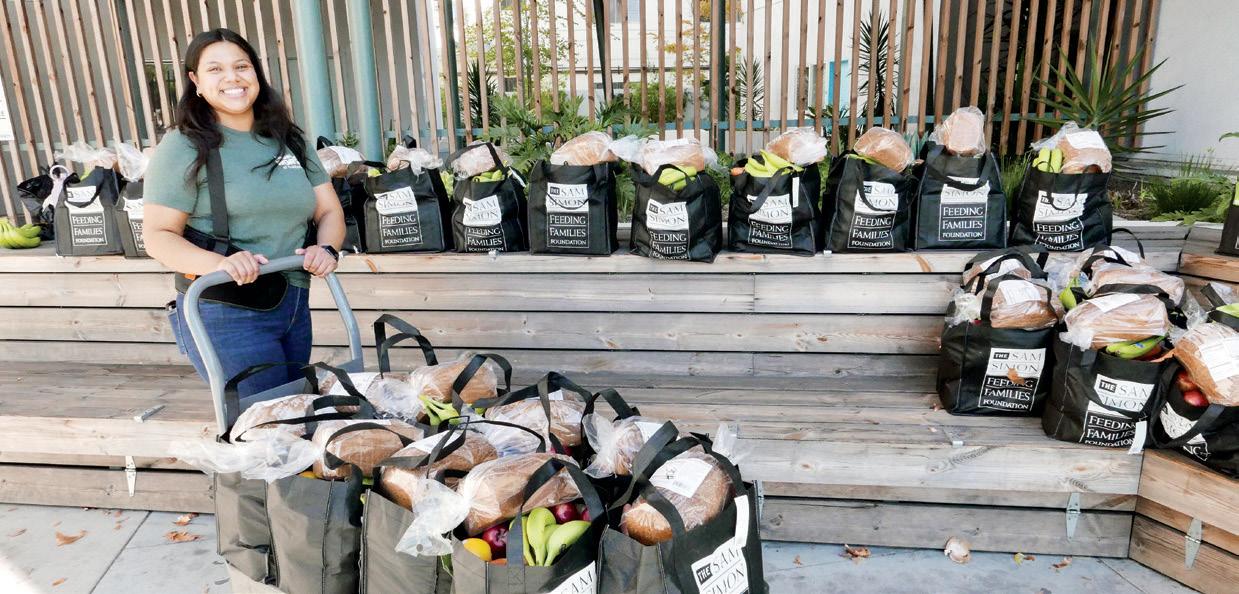
Housing Works has a nationally recognized approach to guiding people off the streets and into permanent housing. They use hope, empowerment, and encouragement plus a resourceful base of proven programs that go beyond housing to include enrichment services that help those they work with maintain that housing.
With lack of housing at dire levels, Housing Works’ goal this coming year is to provide on-site services for 400 more clients and to add two building sites. They also plan to expand their reach by creating a framework to pass on their institutional knowledge and train a new generation of advocates.
All of this requires the support and generosity of the community. Housing Works’ goal is to raise $7 million to increase their reach as they tackle the humanitarian crisis of homelessness in California. Every dollar helps them reach this goal.
Alvarez says. “It’s got to be a lifetime commitment, in order to ensure that we can keep people off the streets.”
California accounts for 28% of the unhoused in the nation, with more than 181,000 people living without permanent shelter – 75,300 people in L.A. County alone. In Santa Barbara County the most recent Point in Time Count showed an 11% increase in homelessness.

This is Kelley. Kelley was homeless and resided in a sober living facility when she was referred to Housing Works. After assessing Kelley’s situation and considering some of her requests related to her housing needs, HW Housing Navigator Catrice found a duplex for her in Los Angeles.
“We really push to understand what’s happening in the person’s life and figure out: what do we need to do to overcome the barriers that are creating challenges for people to get inside,” says Alvarez. “It is very, very rare that we have to turn someone away.”
Founded in 2003, by co-founder Mary Kirchen, a member of the Immaculate Heart Community of Montecito, Housing Works has grown and now gives on-site support for more than 800 people in 11 housing sites and in individual housing. And it has a 93% success rate of housing retention. Through its mobile team (MIST), Housing Works helps locate the chronically homeless and retain housing and other critical services for them.
Housing Works believes that this dire humanitarian crisis can be solved by a one-on-one commitment of care based on empowerment, forgiveness, love, and compassion that fuels living environments that allow people to flourish and become thriving members of the community.
There are 75,500
people in
who are currently experiencing homelessness.
Immaculate Heart Community
The Ralph M. Parsons Foundation
Santa Monica College: Dr. Nancy Greenstein (Board Trustee)
SoCal Gas: Neil Navin (Senior Vice President of SoCal Gas) Corporation for Supportive Housing L.A. Care
The Guibord Center
Remi Kessler (Film Producer)
The Sprague Foundation
Mary Kirchen, Founder of Housing Works
Saba Mwine-Chang (HW board member and Deputy Chief of DEI LAHSA)
Gary Blasi (Professor of Law Emeritus, UCLA School of Law)
Mollie Kaiser
– Private Wealth Advisor
Dr. James Thing (Professor of Sociology)
Zella Knight (Homeless Advocate serving multiple L.A. agencies)
Linda Peacore (HW Board Chair and instructor, Westridge School)
Dulce Acosta (Senior Principal Director of USC Community and Local Government Partnerships)
Roland Palencia (former Community Benefits
Director - L.A. Care Health Plan and Founder and President of BreakSpell Consulting)
Heather Sanchez (Head of Business Banking - Farmers & Merchants)
Val Zavala (retired - 30 yearsbroadcast journalist KCET)
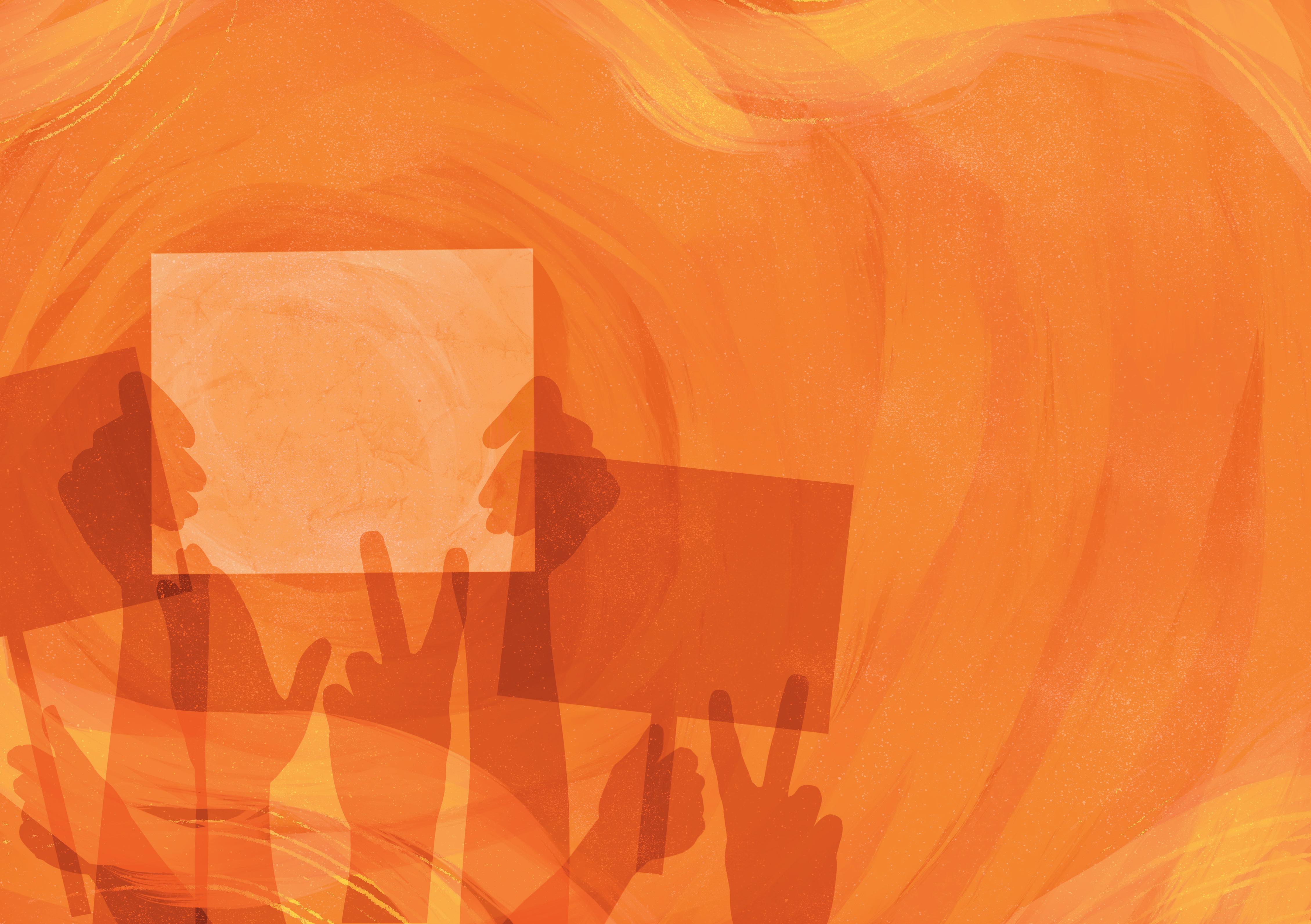

Advocacy is about standing up for people in need and speaking up for those without a voice. Whether global or local, we are thankful for the brave advocates you will read about in the following pages.
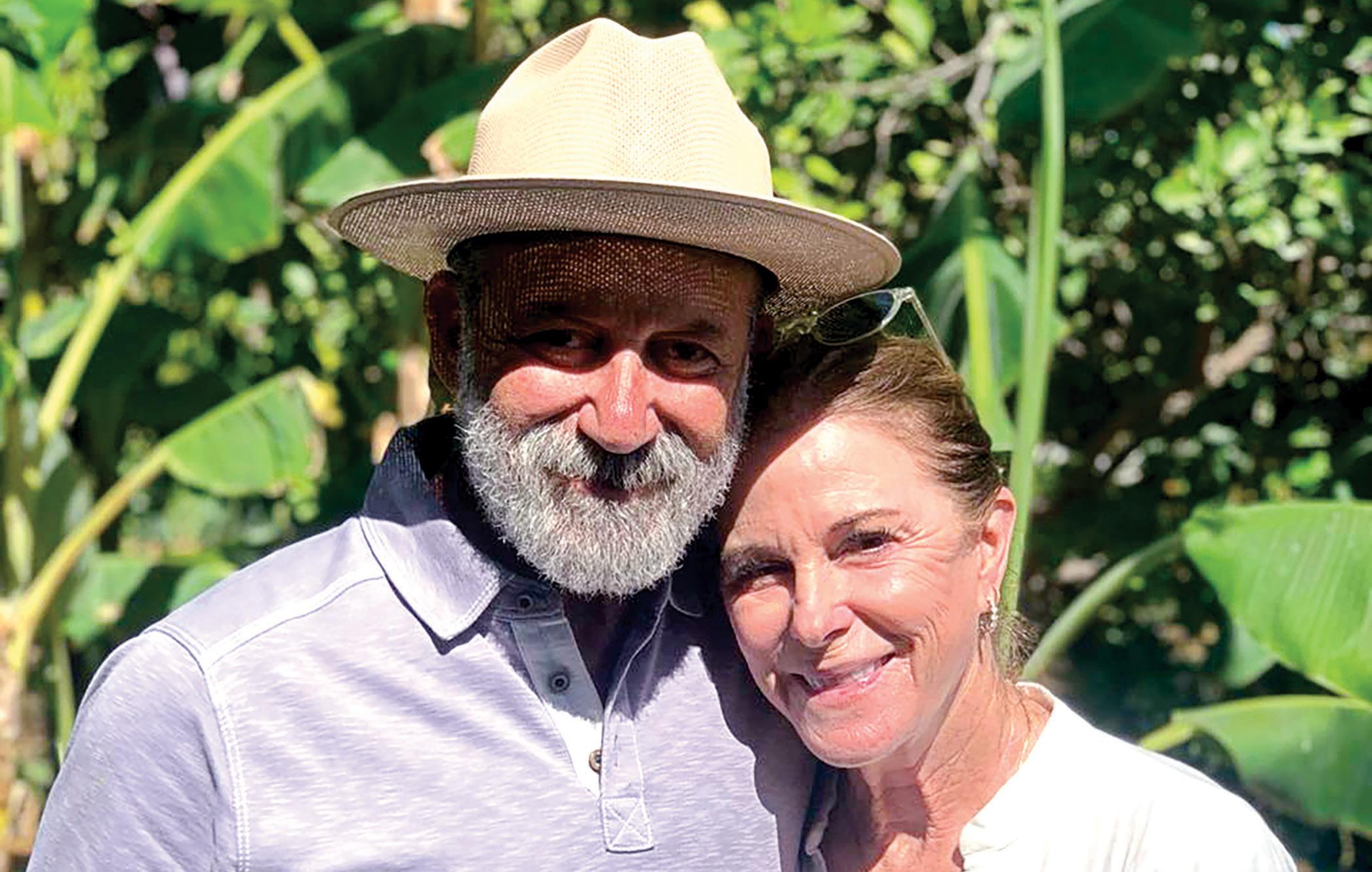
Born in Cuba and adopted at three months old, Angel Martinez immigrated at the age of three to the United States. His journey, from working-class immigrant to successful business leader is described by Angel as something of a Horatio Alger story; one that exemplifies the power of opportunity and belief.
A talented runner in high school, Martinez’s passion for athletics led him to the footwear industry where he played key roles in building iconic brands such as Reebok, where he spent 21 years, and Keen, a company he later founded. As CEO of Deckers Brands from 2005 until his retirement in 2016, Martinez grew the company from $200 million in revenue with 140 employees
to $1.8 billion with 4,000 employees worldwide.
I was eager to speak with Martinez as a shining example of a successful leader who combined his corporate leadership with a passionate advocacy for corporate philanthropy, human rights, and creating opportunities for others. Among other things, Martinez was an executive producer of the Human Rights Now! World Tour in 1988 and has engaged with organizations like the Boys and Girls Club. Even in his limited (by choice) service on corporate boards like that of Korn Ferry, he continues to champion diversity, equity, and inclusion in the corporate world. His story is one of resilience, hard work, and a deep-seated belief in the power of collective genius and giving back to the community.
Q: Can you tell us a little about your journey to where you are today?
Angel Martinez: I was born in Cuba and I was adopted when I was three months old by my grandmother’s sister and her husband. My mother just split. My father worked for the railroad and was traveling five days, six days a week on trains. When I was three, my guardians immigrated to the United States because their kids had been immigrating since 1952. And so, we went to the Bronx in New York. I grew up in the Bronx until I was 13.
In 1967, we moved to Alameda, California … which was like moving to another planet. I actually thought the sidewalks would be made of wood and that people wore cowboy boots. I had a heavy Bronx accent at the time, and I was a little shit. I got in a few fights because kids wanted to pick on that weird kid from the Bronx who wore the pointy shoes.
One day I got called into the vice principal’s office, a guy named Renzo Quilici. He took me to a store called White Front and bought me a wardrobe. He bought
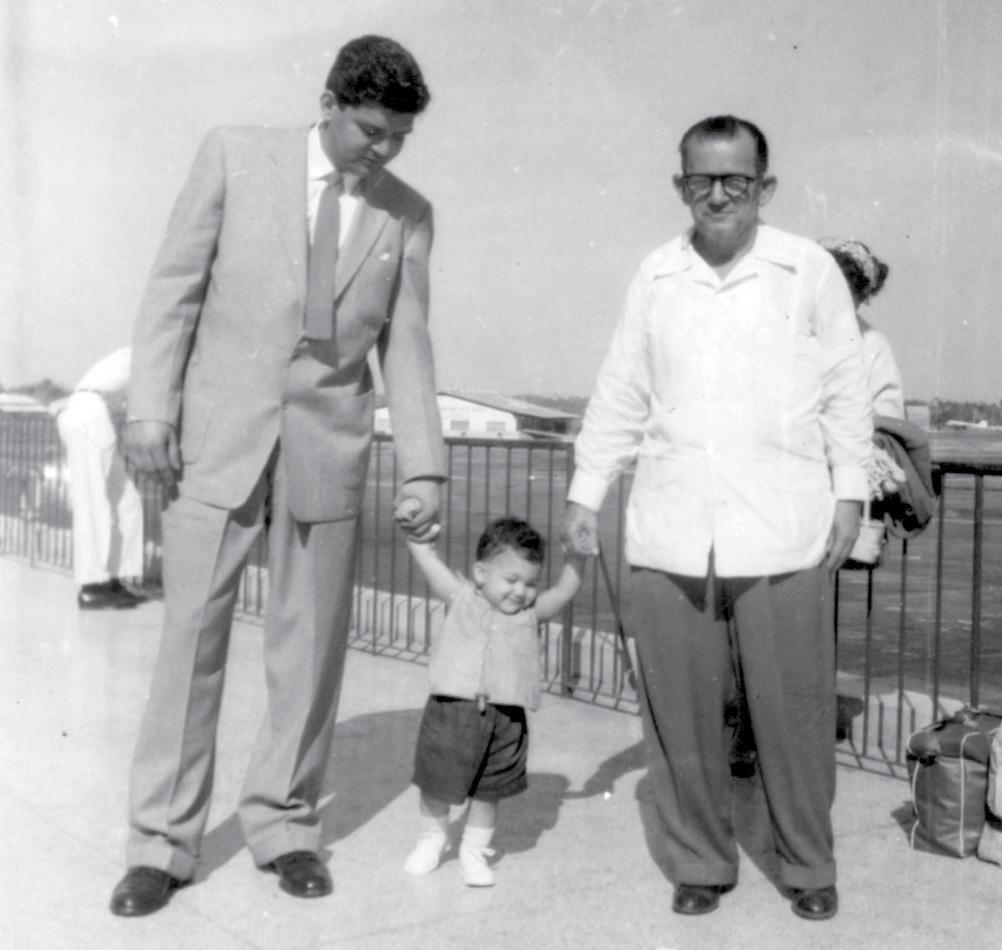
With my guardian, Alberto O’Neill, and his son, Arnoldo. Havana, 1956. Age 1.
He was committed to the idea that America was a place of opportunity and that there was nothing you couldn’t do if you just got here. So, that was deeply em-




“And if you create opportunity, and if you’re successful, part of your contribution is to spread that, to seed that, to create


“What is perceived about philanthropy is that you’ve got to be able to write the big checks in order for it to really be philanthropy, which is nonsense, actually. Look at what’s happening in the elections with people writing $50 checks times 20 million. If we want to solve a problem, let’s understand that it’s a collective issue and that the small checks matter as much as the big checks.”
So, in my opinion, Deckers needed to be an important part of the community because it needed to demonstrate to other companies that it’s good for business to give back. The right kind of employees want to work for a company that wants to give back. Selfishness has no place there.
A company succeeds because people pull together. They pull together on one idea, they commit to it and they make it happen. And then, you create what I call a collective genius. And you actually learn to throttle that and encourage that. And suddenly unbelievable ideas start popping up all over the place.
Q: What causes are the closest to your heart?
A: Kids, opportunities for kids. What my teacher did for me in buying me a wardrobe, a couple pairs of jeans, a few shirts, and some sneakers. That’s why I’m involved with the Boys and Girls Club. When I was at Deckers, we made sure we were focused on that. When I was at Reebok, we were focused on human rights. That was a big issue. I was executive producer of the Human Rights Now! World Tour in 1988 with Amnesty International. That was Sting, Peter Gabriel, Bruce Springsteen, Tracy Chapman. Seventeen concerts on five continents over a month and a half period. Crazy, crazy thing. But we did it in conjunction with Amnesty International to celebrate the 40th anniversary of the Universal Declaration of Human Rights. And that’s when I discovered that most countries violate everything they signed up for when they signed the Declaration of Human Rights, including the United States.
Human rights violations exist everywhere in the world. And until we all learn that we’re all in the same boat here, we’re going to keep confronting these problems. The selfishness at the core of the political argument is incredibly destructive. And people don’t seem to understand that it’s just a path to failure. Everything is a zero-sum game. I can’t see you have something because it takes something away from me, instead of, why don’t we all just create something we can all benefit from? That’s the only way we’ve ever moved forward as humans.
Q: Can you elaborate on what inclusion looks like to you?
A: Well, first of all, if you close your eyes, say you were blind and you couldn’t see what the biases are out there, you couldn’t see a person’s skin color, you couldn’t see whether they had a handicap, you couldn’t see anything. All you could do was hear them. Your worldview would be totally different, wouldn’t it? The core of inclusion is this idea that you judge a person by who they are, the things that are important to them, what they value, that’s the important thing.
Inclusion is also the understanding that collective genius is a very powerful thing. Why would I, as a CEO of a company, restrict the quality of ideas that can come into this company? Why would I ever do that? I don’t care where the ideas come from. Best idea wins. And the people who want to work hard to make it happen.
Inclusion is, beyond inclusion of race, it’s inclusion of ethical standards. It’s inclusion of world views grounded on sets of ethical principles. As long as we’re all focused on the greater good, we succeed. I think
in the end, when companies or societies do that, they win, and when they don’t, they struggle.
Q: Can you talk about the importance of small contributions in philanthropy?
A: It’s funny because when I was a kid, and I mentioned my teacher, Mr. Quilici. But in the Bronx, there was an organization that came into the neighborhood and they were recruiting kids to go to a camp, a camp called Camp Brookhaven. The cost was $2.50 for a week of camp. It was to pay for the gasoline to get the kids to and from the camp.
And I’d never been in an environment where there was a lake or there were trees or any of that stuff. I’d never eaten pancakes. I’d never done any of that stuff. Never really seen fireflies like that. The Bronx has trees, but they’re sequestered. And that was this organization, and we had Bible study every day for half an hour and learned all the gospel songs. But that really wasn’t what it was about. It was actual, true Christian charity. So, I was able to go twice to that camp. And that was a huge thing for me.
In the end, I guess a very small amount of money



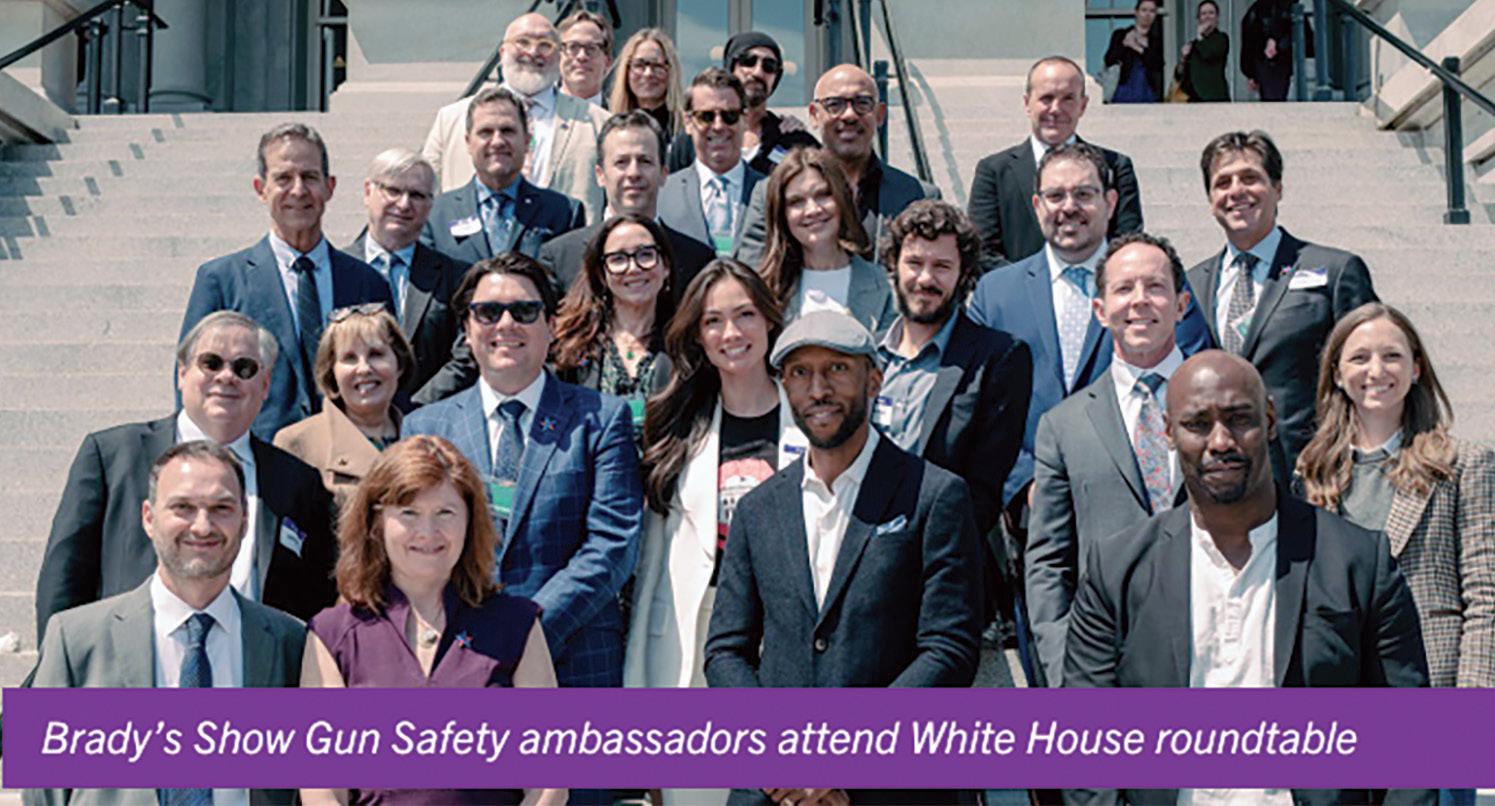
By Check:
Brady Center to Prevent Gun Violence
840 First Street N.E., Ste. 400 Washington, D.C. 20002
*Donation Memo: The Giving List
By DAF or Stock Transfer: Tax ID# 52-1285097
By Credit Card: bradyunited.org/donate
Contact: Liz Dunning (she/her/hers) Gun Violence Survivor & Chief Development and Engagement Officer (202) 370-8149 ldunning@bradyunited.org
Brady Center to Prevent Gun Violence
840 First Street N.E., Ste. 400 Washington, D.C. 20002 (202) 370-8149
here is only one thing Brady: United Against Gun Violence (Brady) Chief Development and Engagement Officer Liz Dunning wants you to know: The leading cause of death for children is preventable.
Four years ago, Dunning sat across the table from her seven-year-old son, Max. They were having dinner when Max said he was concerned about doing his first shooter drill tomorrow at school. The classmate he had been

"We're
paired with was talkative, and Max worried that they wouldn’t be quiet enough.
“You can’t have those conversations with your child and not know that something is wrong in our country,” says Dunning. “Yet the biggest challenge I face in my role at Brady is speaking with folks who think gun violence is an issue that is too big to do anything about. But when you think about getting into a car and putting on a seatbelt or understand intuitively that you’re not allowed to smoke in a restaurant, you can see that we have the power to make permanent change in gun violence as a public health issue.”
Responding to the terrible tragedy in Uvalde, Texas, Brady helped pass the first federal gun legislation in 30 years. Rates of gun death and injury have lowered meaningfully, but gun violence still remains higher in the USA than in any other developed country. To live in a world where our children don’t have to attend school shooter drills, we need a cultural shift.
Brady is partnering with Hollywood producers, actors, screenwriters, and showrunners to depict more realistic gun use on TV and in movies. For example, Brady helped the team working on S.W.A.T., a TV show featuring law enforcement, portray safe storage of
Gunsare the #1 killer of children in this country, an unacceptable reality. As they have done for over 40 years, Brady: United Against Gun Violence works to change the laws, change the industry, and change the culture around guns in the United States. Brady’s “Show Gun Safety” campaign and award-winning “End Family Fire” program save lives each and every day, but the scale of the impact depends on you.
With an additional $3 million dollars, Brady could increase their impact exponentially. For example, Brady could conduct a marketing campaign aimed at new gun owners to increase safe gun storage to reduce suicide, school shootings, and domestic violence. Eight children a day are killed or injured due to an unsecured gun in the home. You can help end this. Donate today and free America from gun violence.
a service weapon in the home, a legal requirement in most states. Then, earlier this year, Brady joined forces with creative agency McCann New York to launch a national campaign to shift perspectives around guns and gun ownership in America. This strategic partnership comes at a critical time in our nation with guns now the number one cause of death for children, surpassing automobile accidents and cancer as of 2020.
Brady has also partnered with the Ad Council on their End Family Fire campaign to circulate public service announcements on safe gun storage within the home.
“We know that access to a gun increases the risk of suicide by 300%. In
fact, two thirds of gun deaths are accidental gun injury and suicide. It is realistic to say that 70% of those deaths would be prevented through safe gun storage,” explains Dunning. “By tomorrow we could cut gun violence in half by storing guns safely.”
As for impact, viewers of the End Family Fire public service campaigns were 310% more likely to research safe gun storage, and 48% took action to store their guns more safely.
“We know that when people see the ads and they think about the issue, they take action,” says Dunning. “We don’t have to wait for political action to make progress on the number one killer of our kids.”

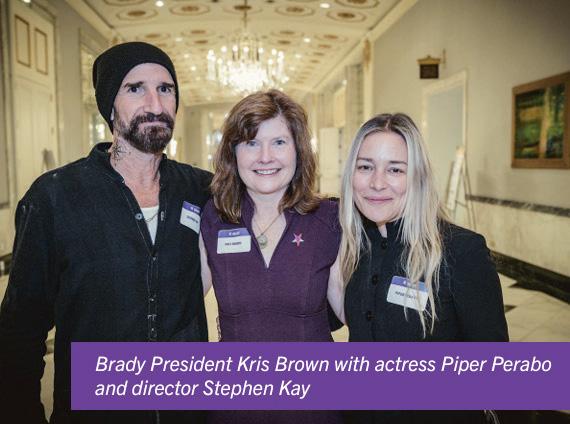
“I’m
proud to support Brady’s groundbreaking Show Gun Safety campaign to be more intentional about how guns are portrayed on screen. We in the creative community must do our part to create a safer America free of gun violence — and that change can start in the characters we create and the stories we tell.”
Now in its second year, Show Gun Safety has created a network of over 300 screenwriters, show runners, producers, actors, and executives dedicated to furthering gun safety principles.
Gun violence is the #1 cause of death for children in the U.S.
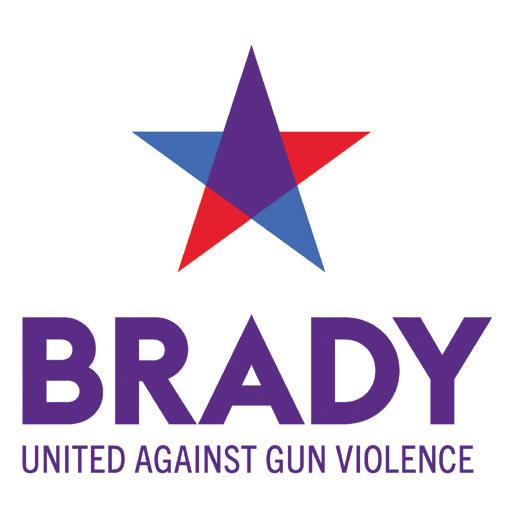
BRADY CENTER 501(C)(3)
Dr. Joseph Sakran (Board Chair)
Kristin Brown (President)
Tony Porter (Treasurer)
Roberto Gonzalez (Secretary)
Gene Bernstein
Thomas Dixon
Roberto Gonzalez
Ricki Tigert Helfer
Lynn McMahon
Martina Leinz
Joshua Solomon
Helen Torelli
Joe Trippi
Kath Tsakalakis
David Wah
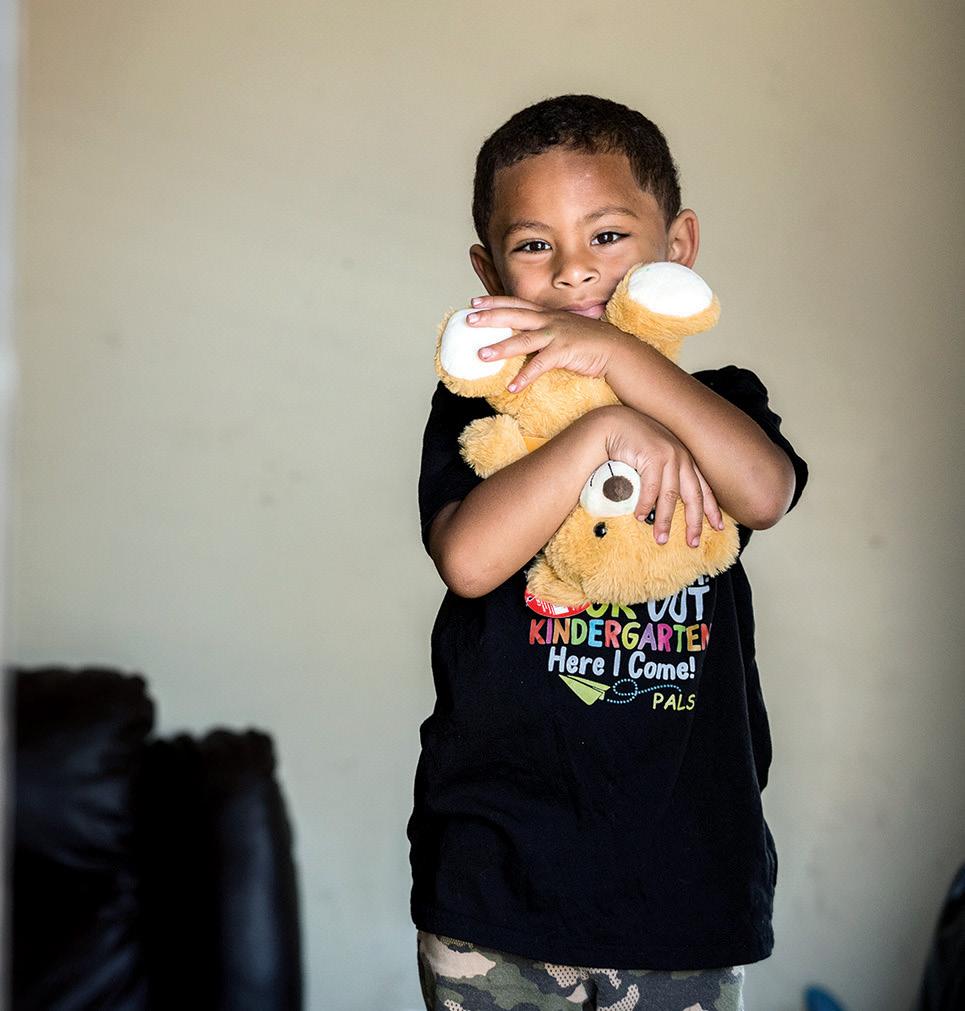
CLC strives to keep families together. They believe every child deserves loving and permanent relationships. Every child deserves to feel safe, wanted, loved, heard, and they accept each child for who they are and honor their individuality.
By Check:
Children’s Law Center of California 101 Centre Plaza Drive Monterey Park, CA 91754
*Donation Memo: The Giving List
By DAF or Stock Transfer:
Tax ID# 95-4252143
By Credit Card: clccal.org/donate
Contact: Stephanie Talavera Development Manager (323) 980-1538 talaveras@clcla.org
Children’s Law Center of California clccal.org 101 Centre Plaza Drive
Monterey Park, CA 91754 (323) 980-1700

Children’s Law Center of California (CLC) provides legal representation for abused, neglected, or abandoned children under the jurisdiction of the dependency court. CLC is the largest children’s legal services organization in the nation, advocating for over 20,000 children and youth each year.
Esmeralda Barajas entered the foster system at age 8 and exited just when she needed help the most. She had a toddler and health issues that left her unable to work. With debt piling up from the loss of income, she was facing homelessness.
“I was out of funds, and I owed money to people who had helped me out before,” says Barajas. “I was scared. I was worried I may lose my child due to not being housed.”
She reached out to Children’s Law Center of California (CLC), who quickly helped Barajas find funds for one month’s rent and a peer advocate who supported her as her health improved. With CLC’s assistance, she was able to regain employment and find permanent stable housing. CLC also identified a financial literacy program.
Young adults leaving foster care are at high risk for homelessness. To ensure that more young adults who exit the foster system like Barajas stay housed, the Mayor’s Fund for Los Angeles has partnered with CLC as part of the We are LA Children and Youth Program. Launched in July 2024, it helps young adults find resources and housing with the help of steadfast case workers.
CLC is the legal advocate for over 20,000 foster youth in Los Angeles, Sacramento, and Placer counties. Outside the courthouse, their multidisciplinary support ensures that kids and families have the tools they need to thrive.
“Kids can’t thrive unless they have a healthy family to be a part of. And ideally, it’s their family of origin,” says Leslie Heimov, executive director. “It is our role to look at the child’s whole situation, and that includes where they live, who cares for them, their relationships with their families, and their education and mental health needs. Our function is to help families be safe and strong.”
CLC, the largest children’s legal services organization in the nation, has more than 550 dedicated, compassionate legal, social, and work professionals who advocate for children and prioritize keeping families together when possible. Their Expectant and Parenting Youth (EPY) program helps support young soon-to-be parents and ensures that family instability is not a repeating cycle. Other services include mental health care casework, peer support for foster youth, advocacy for those with developmental disabilities, and intensive casework for the most vulnerable youths.
“It’s hard to do well in school if
Aslegal counsel for more than 20,000 children in the foster system in three counties, Children’s Law Center of California’s advocacy and multidisciplinary support model protects children and supports families. They provide housing assistance, mental health care case work, support for new parents, advocacy for those with developmental disabilities, and intensive casework for the most vulnerable.
In 2024, they lost nearly $5 million of state and federal funding and are in need of donor support to continue critical programs.
• $300,000: Continues their mental health program and their advocacy for those with developmental disabilities.
• $300,000: Protects their program (raised over the next two years) ensuring young people aging out of foster care have stable housing.
• $3,000: Provides a security deposit and move-in funds for one young adult and baby.
• $1,500: Helps a new mom with baby essentials and a stable start.
• $1,000: Buys birthday gifts for 50 children
• $500: Buys new clothing or school uniforms for 5 children
you’re having a mental health crisis. It’s hard to maintain employment if you’re clinically depressed. It’s hard to be a good parent if you’re struggling with anxiety or depression or substance use. It’s hard to maintain housing if you have an addiction,” says Heimov. “It’s all interwoven. Nothing we do is this one thing.”
Now with a second child, Barajas credits CLC’s support with her family’s comfort and stability.
“I am so thankful that there are good people in this world looking to help those in need and I am thankful for CLC for always supporting me,” Barajas says. “CLC won’t abandon you.”


“Acouple of years ago, I was on the verge of being homeless. I was unable to work for health reasons and my lack of income was really hard on my family. That’s when I reached out to CLC. The CLC housing team went above and beyond. My housing peer advocate was a breath of fresh air. She helped me get $1,800 to cover one month of rent, and it allowed me to ease back into employment. I’ve aged out of care, but my peer advocate is still helpful and provides resources and support whenever I need help. CLC won’t abandon you.”
– Esmeralda Barajas Client
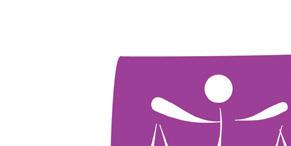



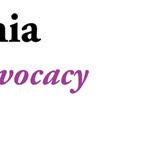

Children’s Law Center of California (CLC) has an amazing team of change-makers advocating inside the courtroom for children and youth, strengthening families and communities, and striving to break the intergenerational cycle of foster care.

"I
love being a part of SJPLA. I’ve heard others describe it as the place we go to have our emotional buckets refilled with joy, love, and kindness, and I can’t think of any better description."
– Margaret Hardin
Global Products CEO, SJPLA Partner & Board Member
By Check:
Social Justice Partners Los Angeles 360 E 2nd St, Suite 200 Los Angeles, CA 90012
*Donation Memo: The Giving List
By DAF or Stock Transfer: Tax ID# 51-0563566
By Credit Card: sjpla.org
Contact: Sharon Stratton Partnerships Manager (917) 460-6857 sstratton@sjpla.org
Social Justice Partners Los Angeles sjpla.org
360 E 2nd St, Suite 200 Los Angeles, CA 90012 (917) 460-6857

Social Justice Partners Los Angeles (SJPLA) was established to repair the root causes of systemic economic, racial, and social injustices in Los Angeles. They envision every Angeleno feeling connected, supported, and responsible for co-creating a community where everyone thrives by meaningfully redistributing our abundant resources. Rather than invest in a single issue, what sets SJPLA apart is they invest in nonprofit leadership and strategies that address the underlying root causes of our interconnected challenges.
“We invest our care, time, and energy into surrounding a community of leaders with the resources and support they need to make lasting social change in Los Angeles,” says Executive Director Christine Margiotta.

As an intermediary organization they resource and uplift efforts by connecting donors with their community-vetted nonprofits led by individuals with direct experience with the problem they’re tackling. Donations have maximum impact because they cross multiple critical issue areas.
To succeed in this far reach and invest in leadership, well-being, and fundamentally transform the way individuals and systems care for each other, SJPLA supports its nonprofit partners with several core programs: the Systems Change Fellowship, the Racial Equity in Homelessness Initiative, and the Partners program.
Since 2017, the Systems Change Fellowship has supported more than 50 nonprofits through yearly ninemonth-long programs that host a cohort of 7-10 leaders to strengthen their organizational culture, communications, and network. They receive a $10k seed grant and have tackled such deep-rooted issues as homelessness, gender-based violence, food insecurity, and much more.
SJPLA knows how valuable donors’ time, skills, and networks are, along with their donations. That’s why they see their community of donors as partners, equal agents in the work of social transformation. Aside from donors making financial contributions
our most pressing challenges requires deep, sustained investment and the participation of all of our devoted community. Social Justice Partners Los Angeles (SJPLA) tackles the underlying causes of Los Angeles’ most critical challenges, such as homelessness, mass incarceration, and economic inequity. SJPLA is raising $4 million to provide multi-year grants for 25-30 nonprofits over three years, complemented by trainings, peer-learning, and relationship-building.
As a donor, you become a member of SJPLA’s thriving Partner community. Your single gift joins SJPLA’s pooled fund of resources from individuals, foundations, and corporations, and supports a portfolio of communityselected nonprofits. Partners further their donation by contributing their time, skills, and networks to support grantees’ development.
Sharon Stratton, Partnerships Manager, says her dream is for SJPLA to serve as a “home” and living laboratory for those seeking to practice new ways of showing up as partners in social transformation. Join SJPLA to create a new world and invest in bringing it to life.
to a collective pool of funds, SJPLA offers donors opportunities, via their Partners program, to contribute their valuable and unique skills and networks to bolster the work of their nonprofit grantees.
Their model is working. Seven million dollars in funding has been redistributed to L.A.’s frontline changemakers and community initiatives fueling e orts addressing root causes of injustice in L.A. (like racial inequality in homelessness and educational inequity to name just a few). More than 2,500 people have been trained in their programs in anti-racist practices and healing justice.
Overcoming the deeply ingrained inequities of our hulking social systems can at times seem overwhelming, says Margiotta. “When we seek to create a different world, the most important tool we each have is our small sphere
of influence. We have to start with the people that we’re in direct contact with each day.”
Social Justice Partners Los Angeles has undeniably demonstrated that if we start small, unify our vision, and understand that we’re all in this together, we can a ect deep and lasting change, one partnership at a time.
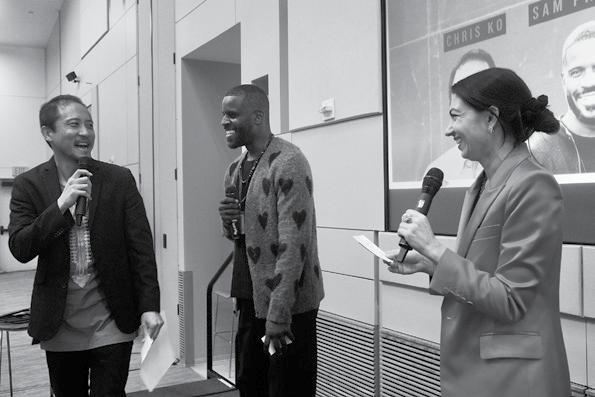

“I
’ve been an SJPLA Partner since 2012, and for the last five years I’m proud to have also served as a Board Member. One of the reasons why I come back every year and dedicate time and resources to SJPLA is that I truly believe that if we create more spaces like this – everything will be better. SJPLA’s community is magic, and their leaders have ideas that will change the world.”
– Amber Sheikh
Owner & Chief Impact O cer, Sheikh Impact; SJPLA Partner and Board Member

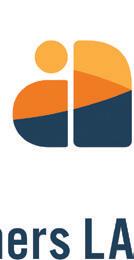
Amber Sheikh (she/her)
Chris Ko (he/him) Co-Chair
Eric Ares (he/him)
Helen Leung (she/her)
Margaret Hardin (she/her)
Michelle Rhone-Collins (she/her)
Paul Hernandez (he/him)
Sam Prater (he/him) Co-Chair
Vera deVera (she/her) Treasurer
Angell Foundation
California Community Foundation
Cedars-Sinai
Conrad N. Hilton Foundation
First 5 LA Goldhirsh Foundation
Kaiser Permanente
Ralph M Parsons Foundation
United Way of Greater Los Angeles
WHH Foundation
Weingart Foundation

Lori Lahman and Juli Shamash at the Drug Awareness info table for a student presentation at a high school in Inglewood.
By Check:
Drug Awareness Foundation 9701 Wilshire Blvd. Ste. 1000 Beverly Hills, CA 90212
*Donation Memo: The Giving List
By DAF or Stock Transfer: Tax ID# 88-2017507
By Credit Card: drugawarenessfoundation.org
Contact: Charles Shamash Director of Outreach and Fundraising (310) 560-4000 DrugAwarenessFoundation @gmail.com
Drug Awareness Foundation drugawarenessfoundation.org 9701 Wilshire Blvd. Ste 1000 Beverly Hills, CA 90212 (310) 387-7500
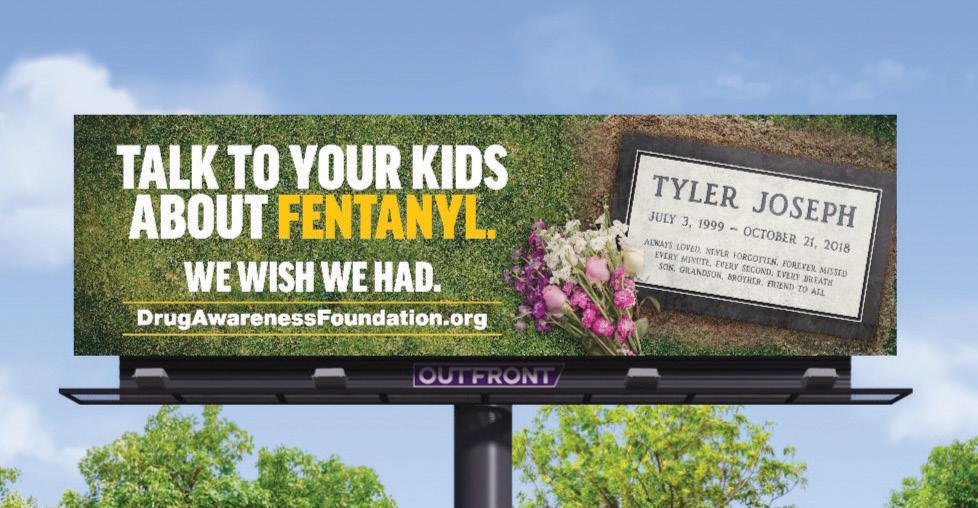
“We always say, ‘not my child’ are the three most dangerous words a parent can say,” says Juli Shamash, founder of the Drug Awareness Foundation. Shamash knows firsthand the result of having a child die from fentanyl poisoning.
Her son, Tyler Shamash, died at age 19 after overdosing on the deadly drug. An intelligent child, Tyler adored his two siblings, was generous to a fault, was a whiz

at fixing things, computer programming, and hacking. He began self-medicating to ease anxiety as a teenager and was soon in a battle with addiction. He was working towards sobriety, when he relapsed, consumed drugs that contained fentanyl, and died of an overdose in a sober living facility in 2018.
Fentanyl is among the most potent opioids available. Roughly 100 times more potent than morphine. Opioids are behind the vast majority of adolescent overdose deaths in the U.S., according to the CDC. Many adolescents accidentally ingest fentanyl when they consume counterfeit pills or other illicit drugs poisoned with the drug. An amount the size of a head of a pin can be fatal. The unintentional use makes an overdose more likely.
“People may have heard of fentanyl because it’s on the news, but they don’t understand that if they’re buying what they think is a Xanax from social media, it’s not a real Xanax,” says Shamash. “It is counterfeit, made of filler and fentanyl – it just depends if it’s got enough in it to kill you or not.”
The Drug Awareness Foundation’s goal is that every person in the United States is empowered with the tools and knowledge to save lives – their own or
The Drug Awareness Foundation knows that knowledge is power and when it comes to fentanyl overdoses, knowledge saves lives.
In the upcoming year, your donations will help the Foundation reach their goal of raising $100,000, which will ensure that they can:
• Push for greater access to Naloxone and testing strips in schools and institutions.
• Expand their current public ad campaign and create a second ad campaign specifically for students.
• Meet the cost of their speaking engagements, which are at no cost to their hosts, and pay for their communications.
• Continue to work with community members and lawmakers to pass a federal law, similar to California’s recently instituted Tyler’s Law.
All of which can save countless lives.
someone else’s. The Foundation gives presentations to students at colleges, fraternities and sororities, high schools, medical schools, businesses, and community events about fentanyl and overdoses. Their bus ad and billboard campaign, “One Line, One Pill. Fentanyl Kills,” informs the local public about the dangers of the drug. They have a standing order from the state to distribute Naloxone, which can rapidly reverse an opioid overdose and save lives, and they educate and provide fentanyl testing strips to those who might need them.
Shamash also advocates for more e ective drug legislation. She helped pass Tyler’s Law (CA SB864), which went into e ect in January 2023, and requires hospitals to add a fentanyl screening to the standard five-panel urine drug tests in California. The law was introduced with bipartisan support in the U.S. House and Senate in December 2023.
According to the DEA, fentanyl is the nation’s greatest and most urgent drug threat, so there is still critical work for the
Drug Awareness Foundation to do.
Shamash is dedicated to the task. She made a promise to herself after her son’s death shattered their family.
“If you do nothing else, you need to get up, take a shower, and get dressed, because I knew if I didn’t do it for even one day…. There are moms who haven’t gotten out of pajamas in a year,” says Shamash, “So all of this is a reason for me to get out of bed, to think that his death isn’t in vain, and try to prevent other families from going through this.”

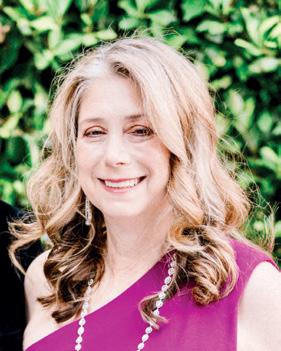
“F entanyl is a raging danger to our society and many are unaware of the danger it presents in their lives and the lives of those they love. Drug Awareness Foundation’s mission to educate and raise awareness of these dangers is so important to allow people to make choices with full knowledge and ultimately, to save lives. I am proud to support Drug Awareness Foundation’s work.”
– Allison Rosenthal Donor

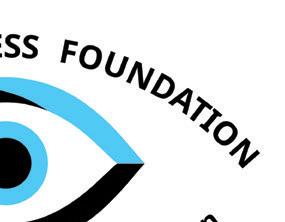

Overdose is the leading cause of death of Americans 18 to 45. Of teen drug deaths, 79% are from fentanyl. Many are among first-time users who aren't aware that most drugs are being poisoned with fentanyl.
Cecilia Barajas and Mitch Lasky
Fisch Properties
Jack in the Box Foundation
Kaiser Permanente
Tim Olzer
Allison and Bennett Rosenthal
Aliza Shaby
Sun Shine on You Foundation


Children are precious, sensitive, and impressionable. And they are the future. What they need more than anything are adults that will fight for them no matter how hard that fight may be.
By Daniel Heimpel
Iam driving through Silverlake to drop my son Teddy off on his first day of first grade. Along Sunset Boulevard we see homeless encampments, signs of Los Angeles’ struggle to contain an expanding crisis.
From the backseat Teddy asks, Dad, what’s going on?
That innocent question, which I frustratingly couldn’t answer, led me to ask myself the same. The year was 2021.
My colleagues at The Giving List were 10 weeks away from delivering the copy for the 2022 books, in Los Angeles, San Francisco, and Santa Barbara. And I knew I had the idea for my feature in The Giving List L.A.: I would examine how philanthropy was trying to and could help tackle homelessness. What I didn’t know was that Teddy’s simple question, and my journalistic response, would thrust me into a new career.
The headline, penned by Giving List associate Les Firestein – once head writer for the ‘90s wildly successful TV show In Living Color – was “Can Homelessness Be Solved by Making it Profitable?” Characteristically punchy and accurate.
You need to understand what working at The Giving List was like. As executive editor, my days were spent in deep conversation with some of the nation’s most sophisticated charitable foundation leaders, individual donors, and nonprofit executives. People on the forefront of bending philanthropy’s varied financial instruments towards strategies that went far beyond grants.
In the context of these influences, I broke down the issue of homelessness into the core sectors trying to solve it: government, nonprofits, and philanthropy. My underlying contention was that government, through investments in housing, rental subsidies and
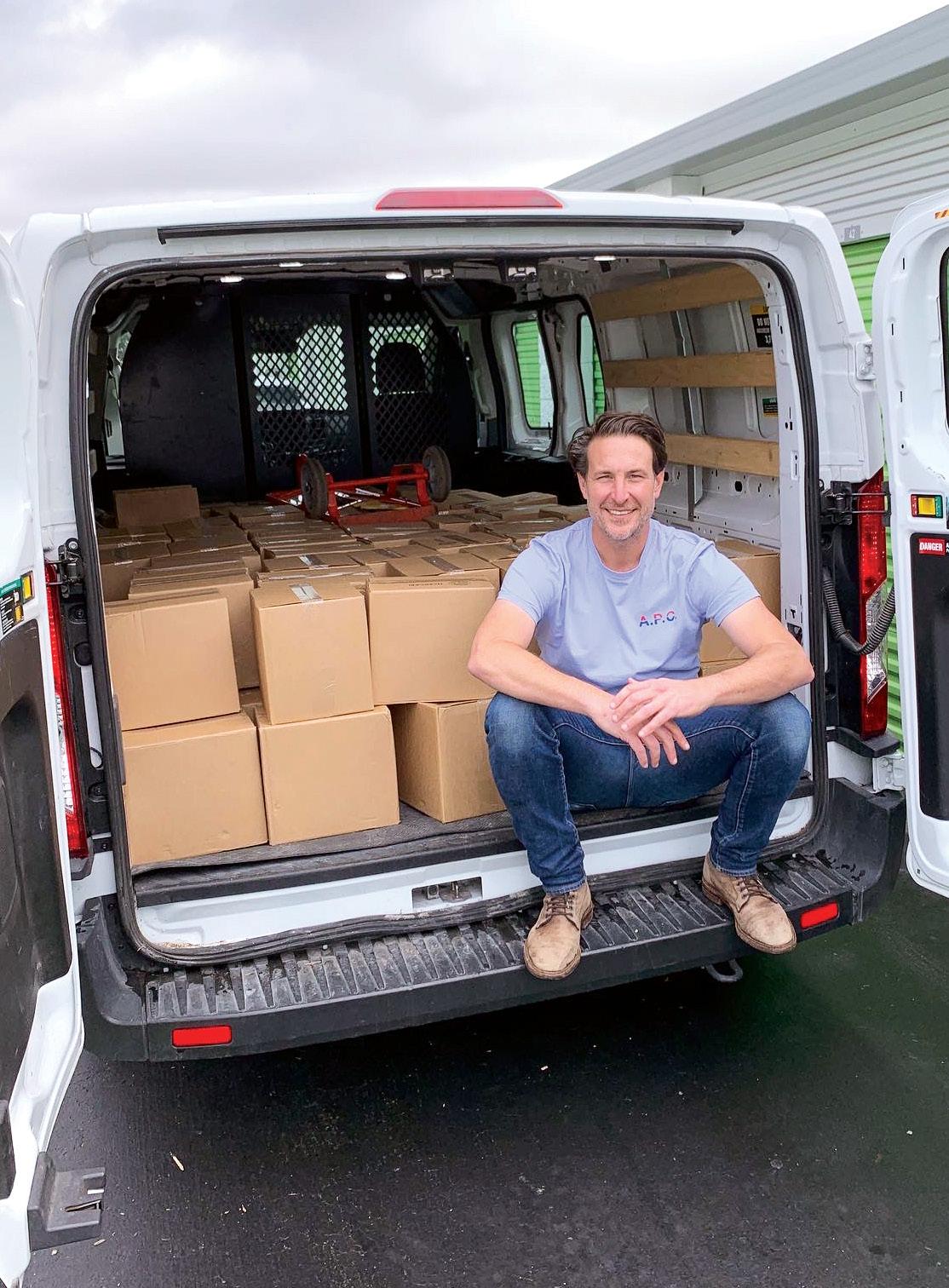
In November 2021, part of my job included physically delivering Giving List books to our partner nonprofits - giving me an interesting tour of Los Angeles and touch points with folks leading efforts to combat homelessness.
service dollars, and nonprofits, often operating with little financial cushion, were doing the heavy lifting. And that philanthropy, which by dint of an IRS rule that they spend 5% of their endowment value in grants annually, was leaving 95% of its wealth off the table. The trick was how to mobilize that 95%, in excess of $100 billion in L.A. County alone, towards ending homelessness.

L.A. County is home to the largest locally administered foster care system in the world, serving nearly 22,000 children and youth. Roughly 1,000 youth will “age out” of the system in L.A. every year without having been adopted or reunified with their birth families. More than 85% of the foster youth ages 18-21 in the county are Black or Latino – pointing to outsized racial disproportionality.
To get there would require giving foundations and other institutional investors the risk-adjusted, market-rate returns they sought. And there were examples. A growing number of impact-focused real estate investment funds have been able to privately finance affordable and supportive housing by relying on government rental subsidies.
But my thesis went a step further, arguing that by synchronizing philanthropy’s financial instruments – grants, Program Related Investments, Mission Related Investments, and loan guarantees – one could make investments in combating homelessness a no-brainer. That philanthropy can and should lead to a re-orientation of the energy of money. Beyond that first Giving List feature, I strengthened that thesis in articles in The Chronicle of Philanthropy, The Stanford Social Innovation Review, and ImpactAlpha. Somehow in that process of interrogation, I decided to move from writing to doing.
Before my days at The Giving List, I was a journalist with a hyper-focus on one issue above all else: foster care.
It started back in the late 2000s, while I was still a graduate student of journalism at USC. I had heard about a lacrosse team in South L.A. that lost all its games. I went to check out the team and decided to volunteer as assistant coach.
On that bare football field, behind obscenely high school fences, I met a young man named Chris. I remember he was getting into trouble at school and, stupidly, asked him what his parents thought.
I don’t have any parents, I remember him saying. I live in a group home.
I didn’t even know what that meant. But I visited Chris’ home in South L.A. There I met six boys who told me stories of how they were separated from their parents.
From there I started informally mentoring Chris and another teenage boy, John, who had also lived at the same group home. They would come to my apartment in Hollywood. We would play video games and go hiking in Runyon Canyon. Through their eyes I had a window into the foster care system, and it got me writing about it.
As they neared their 18th birthdays, I couldn’t get over the fact that they would be going out into this world, alone, “Left to Themselves,” as one of my L.A. Weekly cover stories blared at the time.
Then something big happened. In 2008, President George W. Bush signed the Fostering Connections to Success and Increasing Adoptions Act, which offered states matching federal funds to extend foster care to age 21. While Chris and John would be too old to access the program, it was my experiences with them that led me to found a nonprofit journalism organization, Fostering Media Connections, with a strong focus on seeing that states extend foster care.

In 2010, California became the first to do so. And years later those additional three years have shown better outcomes for foster youth.
When I last talked to John, he told me how he had become estranged from his three children, and that he had spent his twenties and into his thirties in and out of homelessness.
I just don’t feel like the same John anymore, he told me.
It was heartbreaking. And like it had been more than a decade earlier, I saw the aftermath of foster care through John’s eyes – confirming my next steps.
Like I had tried with nonprofit journalism, I planned on applying a new tool to give foster youth a fair shot: impact investing.
By the summer of 2022, I had melded my new knowledge of private equity and philanthropy’s odd mix of financial instruments with my deeper, older foster care expertise. The result, a bold strategy to end the foster care to homelessness pipeline in L.A. County.
The potential impact in combating the broader homelessness crisis was dishearteningly clear.
L.A. County is home to the largest locally administered foster care system in the world, serving nearly 22,000 children and youth. Roughly 1,000 youth will “age out” of the system in L.A. every year without having been adopted or reunified with their birth families. More than 85% of the foster youth ages 18-21 in the county are Black or Latino – pointing to outsized racial disproportionality.
A seminal study found that between ages 21 and 23, 25% of California foster youth surveyed experienced homelessness, with an additional 28% reporting that they had “couch surfed.” Unsurprisingly more than one third of the county’s unsheltered population has experienced the foster care or juvenile justice systems.
To stop this pipeline into homelessness would require housing – more than 1,000 beds – and in my model the private financing to do it. The problem was that I was a journalist with no financial training. My thesis seemed to make sense, but I needed proof.
So, with the help of friends at the Ralph M. Par-
sons Foundation and the Reissa Foundation, we enlisted five other funders – the Conrad N. Hilton Foundation, the Weingart Foundation, the Specialty Family Foundation, Cedars-Sinai Community Benefit Giving Office, and the WHH Foundation – to fund a financial analysis of the model I proposed. That analysis, conducted by the well-regarded Genesis L.A., a local Community Development Financial Institution, was released in May of 2023 and found that privately financing foster youth housing at scale was possible.
The next step was to launch a private equity real estate investment fund to do just that. Pretty simple, right?
Since the release of Genesis L.A.’s “Scaling Housing to End the Foster Care to Homelessness Pipeline,” I am much closer to realizing that vision than ever before.
In 2023, I launched Good River Partners, a public benefit company, that has garnered support from 13 funders to pursue the development of a financial strategy that can deliver foster youth the safe and stable housing they deserve. For my partner, I brought on Kevin Clark, who before his most recent post with the California Department of Finance, aged out of L.A. County’s foster care system himself.
We, alongside our partners, now have a strategy that will prevent homelessness, while giving thousands of young people in and exiting foster care something John wasn’t afforded – a fair chance at the lives they deserve.
That you are reading this here, in The Giving List, should come as no surprise. Its pages are filled with the stories of people who dream of and execute on big ideas for social impact. Fertile ground for the ideas of tomorrow, a venue where I look forward to reporting on this dream’s realization.

“A bout the Karsh Center, I have a lot to be thankful for. I have learned a lot of things. Starting o with diapers for my baby and attending ESL classes, nutrition class, and received my diploma for the class. I want to say thank you to the Karsh Center for supporting us. If I didn’t know them I would not be here today. “
By Check:
Karsh Family Social Service Center, Inc.
3750 W. 6th St. Los Angeles, CA 90020 *Donation Memo: The Giving List
By DAF or Stock Transfer: Tax ID# 81-297-4850
By Credit Card: karshcenter.org/donate
Contact: Madeleine Dile Director of Development (213) 401-4656 madeleine@karshcenter.org
Karsh Family Social Service Center karshcenter.org
3750 W. 6th St. Los Angeles, CA 90020 (213) 401-4651

The Karsh Center's Food Pantry provides nutritious groceries including fresh produce, protein, dairy, and nonperishables to over 750 people experiencing food insecurity every week.
Since 1929, when Wilshire Boulevard Temple moved into its current and now historical home, in the Koreatown neighborhood of Los Angeles, the congregation has been an active participant in the racially, ethnically, and multi-culturally diverse community surrounding it.
Seeking to support that community through Jewish values, the members of the congregation launched a Sunday Food Pantry in 1988, ensuring that the underserved members of the community had food security. From the success of

that, the congregation began to envision a way to help more of those in their community in need. In 2016, the Karsh Family Social Service Center was launched. The Karsh Center, a robust, comprehensive social service provider, provides low-income clients in Koreatown with a wide range of crucial educational, food, legal, and medical services.
While the Food Pantry is still the backbone of Karsh Center, it is also the gateway to numerous other services local families can take advantage of. Among those services are: The Big Give annual Thanksgiving meal distribution, vision and dental care, wellness checks for the uninsured and underinsured, a case management program that aids families with achieving financial stability and security, grief groups for the bereaved, English as a Second Language and digital literacy classes, a back-to-school resource fair, and even a toy giveaway. Karsh Center also facilitates a Collaborator Network of over 40 other nonprofit organizations that work together to share resources, build relationships, and strategize on how best to serve the Koreatown community.
The Food Pantry is the foundation and backbone of the Karsh Family Social Service Center. It costs approximately $5,000 to run each distribution, which serves between 350 and 400 clients, twice per week.
Participants not only get a nutritionally balanced food program with fresh produce, dairy, protein, and nonperishables, but they also get access to referrals for all of the other crucial services the Karsh Center provides, which include: vision and dental care, wellness checks, grief groups, English as a Second Language and digital literacy classes, and a care coordination program that aids families with achieving financial stability and security.
Your donations go directly to helping the Karsh Center provide a safety net to struggling families and to help build a stronger community where those in need can stand with dignity and create a future where they can thrive.

Last year alone, the Karsh Center served 3,347 clients, including 1,714 new clients, and 818 children. The population of “Koreatown” that Karsh Center serves is incredibly diverse: 52.3% Hispanic, 33.4% Asian, 8.6% White, and 3.7% African American. It is also one of the neediest neighborhoods in the nation, with household incomes in Koreatown ranking 251st out of 265 in Los Angeles.
There is scarcely a community or family need unaccounted for and, since the launch of the Karsh Center, it has become a bedrock and beacon of the community, fulfilling the dreams
The Karsh Center coordinates a network of over 40 collaborator organizations that work together to provide the best care to people living in the Koreatown community.
In Koreatown, one in three households is currently experiencing food insecurity. Among low-income households in Los Angeles, food insecurity is the worst it has been in 10 years.
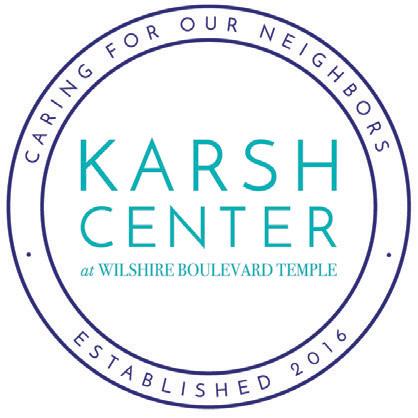
Carol and Rand April
Dena Bloom and Robert Klyman
Alyce and Philip de Toledo
and goals of original founding members so many years ago.
Executive Director Lila Guirguis has seen the program transform many lives for the better. “I’ve never seen a group of people more dedicated to volunteering,” she says of the people who give their time to support programming at the Karsh Center. “They feel it as a calling and a necessary aspect of their lives.”
The Karsh Family Social Service Center creates a safety net for those who need it most by providing an array of life-saving social services while also promoting dignity, compassion, and community.
Carolyn Stone Enenstein and Craig Enenstein
Lori and Simon Furie
Laurie and Steven Gordon
Jennifer and Mitch Haarmann
Martha and Bruce Karsh
Joan and Warren Kessler
Jennifer and Cary Kleinman
Barbara and Tom Leanse
Susan and Stephen Matlo
Nick Melvoin
Ali and Trevor Miller
Dana and Richard Pachulski
Nancy and Je rey Paul
Debbie and Rick Powell & Family
David Ryu
Toni and John Schulman
Ellen and Steve Sugerman

“I volunteer to give back to my community and impact students who share identities similar to mine. The Para Los Niños sta do a wonderful job at crafting volunteer activities that benefit those they serve and give volunteers the opportunities to directly support organizational goals. I am happy to continue supporting PLN wherever I can!”
– Matthew Ramos Volunteer
By Check:
Para Los Niños
5000 Hollywood Blvd. Los Angeles, CA 90027
*Donation Memo: The Giving List
By DAF or Stock Transfer:
Tax ID# 95-3443276
By Credit Card: paralosninos.org/donate
Contact: Christina Mariscal Pasten Managing Director, External A airs (213) 250-4800, ext. 510 cmariscalpasten@paralosninos.org
Para Los Niños www.paralosninos.org
5000 Hollywood Blvd. Los Angeles, CA 90027 (213) 250-4800

The children and families served by PLN face immense challenges – language barriers, poverty, housing and food insecurities, and access to crucial services. PLN’s model is designed to educate children and partner with families to build on their strengths, helping them to thrive.
What if a flat tire meant you couldn’t pay your rent that month? What if an unexpectedly high water bill meant you couldn’t afford childcare? When you live paycheck to paycheck, your mental health comes at the expense of your basic needs. Para Los Niños is on a mission to change that.
“All of us have leaned on somebody at one point. But the families we work with don’t have the safety net that so many other families have,” explains Dan Nieman, vice president of external affairs at Para Los Niños. “Inflation is high and wages aren’t keeping up. These families are working really hard within the obstacles of the system, but the gap between living in Los Angeles versus actually thriving in Los Angeles is big – it can be a huge challenge to get to the other side when no one has your back.”
With 16 locations, Para Los Niños (PLN) partners with 10,000 of Los Angeles’ most vulnerable residents every year. Through a suite of comprehensive support services, PLN starts by
addressing families’ basic needs today and helping them improve their mental health for the future.
“For so many families, it is the difference of $3,000 between having a stable home environment and being homeless. Often it is much less. We worked recently with a family who needed $181 to stay housed. They were waiting on a voucher that didn’t arrive in time. By providing this small amount, we were able to keep them housed so they were not scrambling to find shelter with a young daughter,” says Nieman.
Once Para Los Niños has connected families with resources that can help keep them housed, fed, and stable, they encourage families to seek out the other services that are available both from PLN and within Los Angeles County. After learning about Para Los Niños, Ana sought support from the PLN mental health team.
“My whole life, truthfully, has been challenging. My life has been challenging because my mother died when I was a year old,” says Ana. “[My
• $10,000 – Covers one year of mental health support for a foster youth working on their future career
• $5,000 – Provides 1-2 months of emergency support to cover rent, overdue bills, or other immediate needs for families
• $2,500 – Over a year, covers $50 in weekly groceries for a family
• $1,000 – Provides transportation services for families to access services and enrichment activities

childhood] affected me because, without realizing it, I wasn’t very loving [to my children]. I was one of those moms who didn’t hug her children, the kind that thought it wasn’t necessary because I didn’t have it.”
But after working with a therapist, Ana was able to reflect on her own experiences and forge a closer relationship with her children. She credits Para Los Niños for supporting her while she healed from her past and helping her better connect with her daughters.
“Families living under pressure, whether they have sick or elderly family members or are budgeting from one paycheck to the next, are constantly in crisis. For PLN to be able to meet those immediate needs and then provide a space for families to really address what is going on in their lives and affecting their children – that is how we measure success,” says Nieman. “We want to make sure everyone has the opportunity to focus on what really matters.”


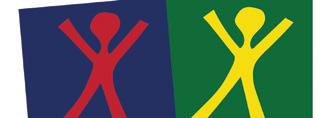
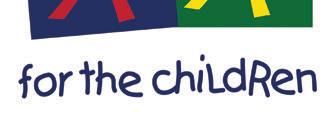

and
Visit our website to learn more about volunteering.
The Atlas Family Foundation
Ballmer Group
The Bank of America
Charitable Foundation
Holly and Albert Baril
Andrea and Blake Brown
California Community Foundation
Caruso Family Foundation
The Carol and James Collins Foundation
The Capital Group Companies
Charitable Foundation
Cedars-Sinai
Ann Daly
The Carl & Roberta Deutsch Foundation
Madeleine Heil and Sean Petersen
The Kaplan Family Fund
Nickelodeon Studios
Walter Parkes and Laurie
MacDonald Charitable Foundation
The Ralph M. Parsons Foundation
Rhino Entertainment
Robert Ronus
The Rose Hills Foundation
S. Mark Taper Foundation

“A
t Mattel, we aim to create positive social impact through purposeful play and by supporting diverse, equitable, and inclusive communities where we live, work, and play. Our support of PRESENT NOW and its Presents Program fills us with joy as we help create normative and healing experiences for sheltered children.”
– Nancy Molenda Vice President, Global Corporate Events and Philanthropy, Mattel
By Check: PRESENT NOW 924 Colorado Avenue
Santa Monica, CA 90401
*Donation Memo: The Giving List
By DAF or Stock Transfer:
Tax ID# 46-1420945
By Credit Card: give.presentnow.org
Contact: Jessica Partida Director of Development 424.330.0002 jpartida@presentnow.org
PRESENT NOW 924 Colorado Avenue
Santa Monica, CA 90401 424-330-0002
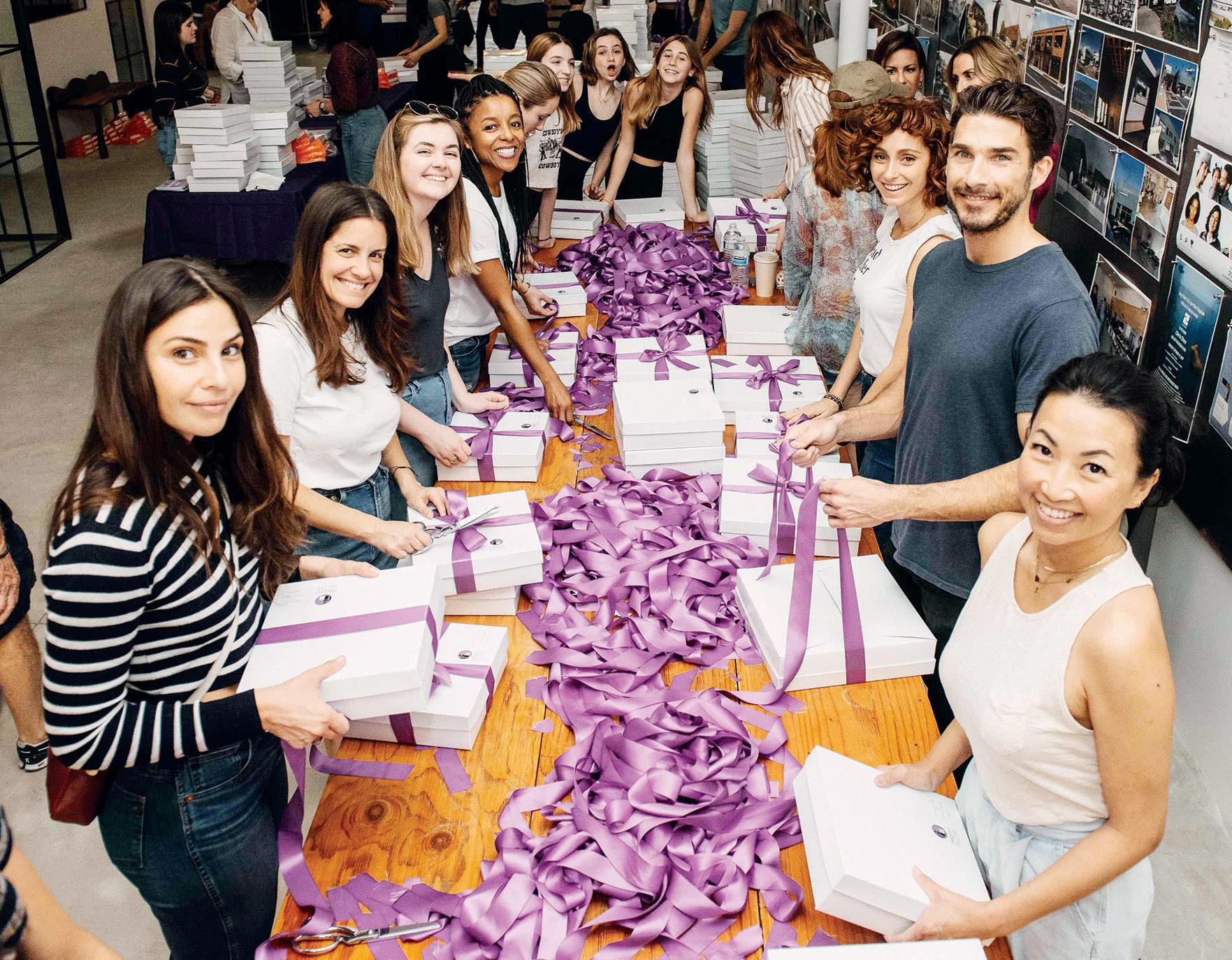
Volunteering at PRESENT NOW provides team-building opportunities guaranteed to make you feel great! Opportunities include packing presents, sorting inventory, and creating outfits.
For children living in domestic violence shelters, a present can be more than just a box with a bow – it can mean the gift of normalcy and joy at a time in their lives when those feelings are in short supply.
“It’s hard to feel happy when you’re scared all the time, but getting a gift and baking a cake on my birthday made me smile and forget about everything else,” says Evan, 12, a PRESENT NOW gift recipient.

Corporate Volunteering event at Mattel, a Game-Changing PRESENT NOW Sponsor
PRESENT NOW is the only nonprofit organization of its kind, serving youth living in temporary domestic violence shelters with new, age-appropriate, curated personalized gifts that help parents rekindle nurturing and positive relationships and environments with their children to help them reach their full health and life potential.
Each gift from the Presents Program helps bring a sense of stability and fosters healing during what is often a tumultuous time while living in temporary housing.
The birthday present includes an outfit, toy, book, a restaurant gift card, and a cake supply bundle so families can bake a birthday cake together. The back-to-school present includes a new backpack filled with supplies for a successful school year, and a STEAM learning gift, sent around Valentine’s Day and Superbowl Sunday, two holidays that coincide with a high prevalence of domestic violence.
Help bring joyful, healing, and meaningful experiences to families rebuilding their lives from domestic violence. While PRESENT NOW serves 147 shelters in over 15 states, 30% of their shelter partners are located in L.A. County, underscoring the significant impact they have in our local community.
• $300 gifts the Presents Program to a child
• $2,500 funds 100 birthday celebration dinners
• $5,000 provides more than 500 backpacks for elementary and middle school students
• $10,000 ships a year’s worth of presents to 42 transitional shelters in California
• $25,000 funds STEAM gifts for youth 10+ for an entire year
The impact of these presents is felt long after children have left the interim housing shelters. Ana, 22, who arrived at a shelter with her family at age 16, remembers not wanting to celebrate her birthday that year. She didn’t want to add pressure on her mom or spend money they didn’t have. But PRESENT NOW’s gift changed that.
“We got to bake my birthday cake together, as a family, and we were able to celebrate my special day at IHOP… I was so surprised to get such a huge box filled with presents that were picked out just for me. It’s a memory that I will always cherish,” remembers Ana. “Their gift gave me hope and brought me and my family much needed happiness and joy during a very di cult time.”
Melanie Neumann and Erica Fisher founded PRESENT NOW in 2012 to help children while visiting a domestic violence shelter. They observed that most families escaping violence had to abandon their entire lives, leaving most everything behind, and shelters can generally only provide bare necessities due to limited resources. This experience inspired the mission of PRESENT NOW. They started by storing gifts in their garages and delivering 118 presents to two L.A.-based shelters.
Twelve years later, from their new warehouse space, PRESENT NOW has delivered more than 18,000 presents to 147 shelters in 15 states. But there are still many more youth and families in need of care and resources to thrive and rebuild.
“When you’re a kid and you’re removed from your home and everything is just up in the air, being able to celebrate normal holidays and milestones really helps them move past all that trauma and look toward the future,” says Jessica Partida, Director of Development.

to R) )
Program and Volunteer Manager, and Erica Fisher and Melanie Neumann, PRESENT NOW Co-founders at the 2023 Galentine's Market Day Event
3.3 million children are exposed to domestic violence in their homes annually, leading to increased anxiety, depression, and academic challenges.
- The U.S. Department of Justice


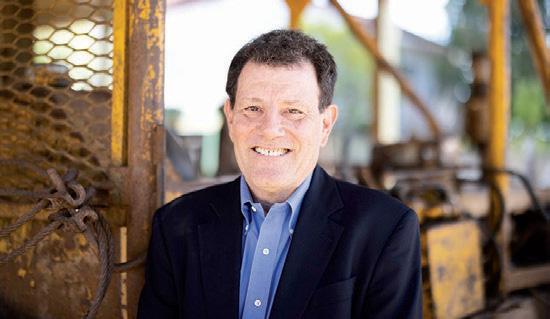
“Vision To Learn is making sure that access to a pair of glasses never stands between children and their ability to see the board, read a book, or participate in class. It is such a cost-e ective yet powerful way to improve a child’s learning experience and make sure they do not fall behind. Vision To Learn helps some of the hardest-to-reach children and your donations will mean more students receiving the eye care and glasses they need to learn and live clearly.”
– Nicholas Kristof
Two-time Pulitzer Prize-winning New York Times columnist
By Check:
Vision To Learn
12100 Wilshire Boulevard, Ste. 1275 Los Angeles, CA 90025
*Donation Memo: The Giving List
By DAF or Stock Transfer:
Tax ID# 45-3457853
By Credit Card: www.visiontolearn.org/donate
Contact: Damian Carroll
National Director and Chief of Sta (818) 383-2335 damian@visiontolearn.org
Vision To Learn www.visiontolearn.org 12100 Wilshire Boulevard, Ste. 1275 Los Angeles, CA 90025 (800) 410-5273
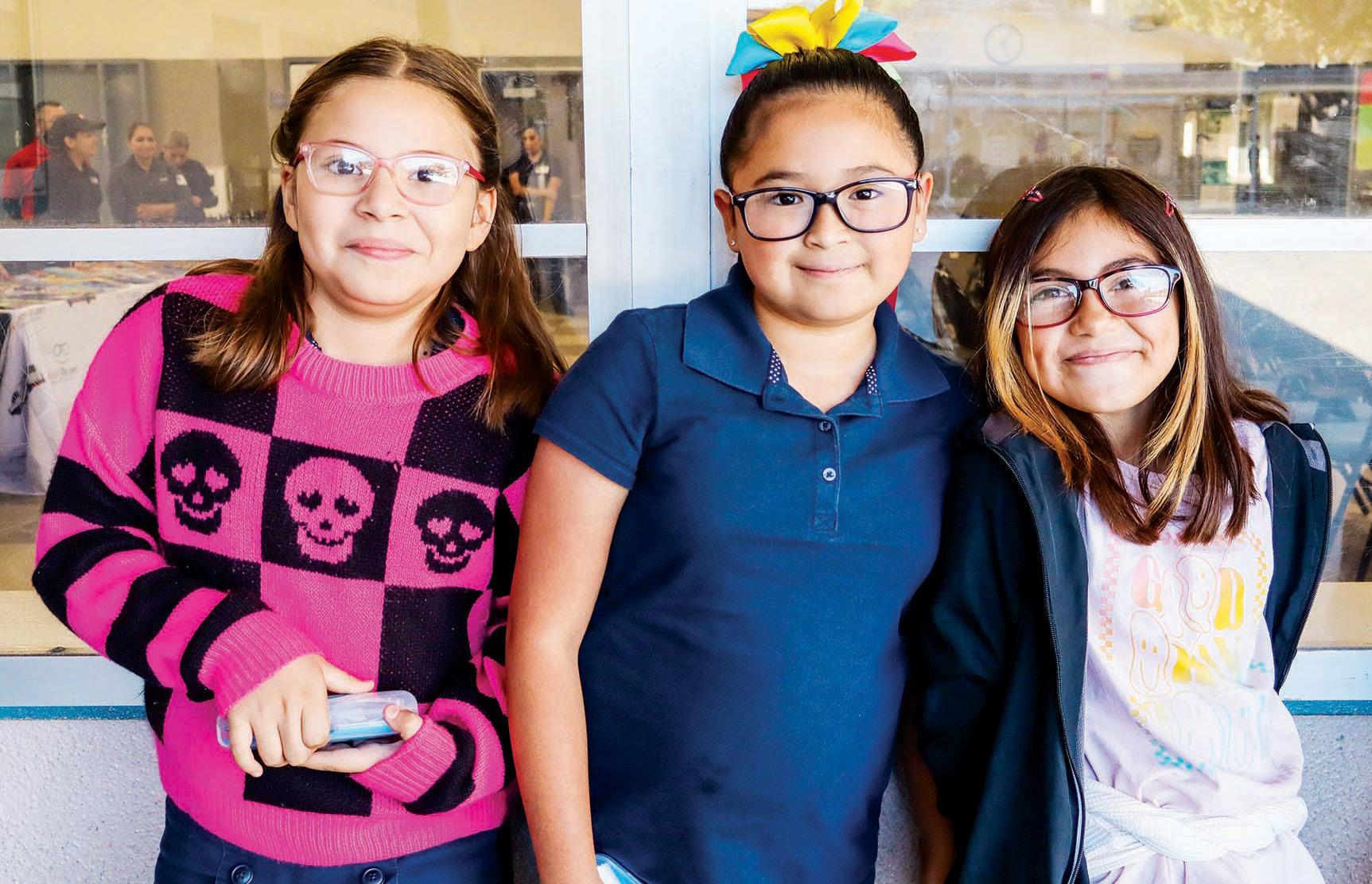
Eyeglasses are such a commonality that most people go through the day assuming that everyone who needs a pair of glasses already has them. Most people, perhaps, but certainly not the team behind Vision To Learn, who knows first-hand how children everywhere are having trouble learning at school solely because they can’t properly see. It’s a problem they’re all too familiar with and work to eradicate.
Since its founding in 2012, Vision To Learn (VTL) has been delivering glasses at no cost to children who need them in Los Angeles, San Francisco, and all over the country.
“Vision To Learn works to solve a widespread problem in American education,” says VTL’s National Director and Chief of Sta , Damian Carroll. “One in four students needs glasses to see the chalkboard, read the book, or otherwise engage in the classroom.”
How can there be so many students without their necessary glasses? Carroll points out that the issue for students isn’t necessarily one of affordability, usually it’s about a lack of access, stemming from the seldom-addressed
effects of institutional poverty. It could be parents working two jobs and not having the time to take their child to an eye doctor’s appointment. Other times, it’s a transportation issue.
These are barriers easily overcome thanks to the services that Vision To Learn provides. Instead of getting the child to the eye doctor’s office, they deliver the doctor’s office straight to the children at their schools in the form of a “mobile vision clinic.” Licensed optometrists roll up to the school grounds in a fully-equipped office within a Sprinter van, providing students with vision screenings, eye exams, and a pair of glasses for each student who needs them – all at no cost to the student or their family.
You can think of Vision To Learn as a sort of Santa Claus for visually impaired children. One might be surprised by the sheer number of students who benefit from these mobile visits: Anywhere from a quarter to a third of each school’s students will get the glasses they need thanks to these programs.
And while clear vision is a wonderful enough benefit in its own right, there
Providing glasses to students with vision issues really is among the low-hanging fruits of educational interventions. The problem is simple to understand, easy to remedy, and Vision To Learn has been very successful executing that remedy.
Heading into 2025, Vision To Learn (VTL) and Children’s Hospital of Los Angeles announced a groundbreaking new initiative to provide all 19,000 children in the Compton Unified School District with comprehensive eye care at no cost to the children or their families.
But more than anything, VTL is seeking funding for their core operation, expanding their fleet of mobile clinics that are the base for their free eye exams and servicing an expanding number of school districts. The program is as strong as ever, and they’ll keep going to ensure that no student is left in the dark.
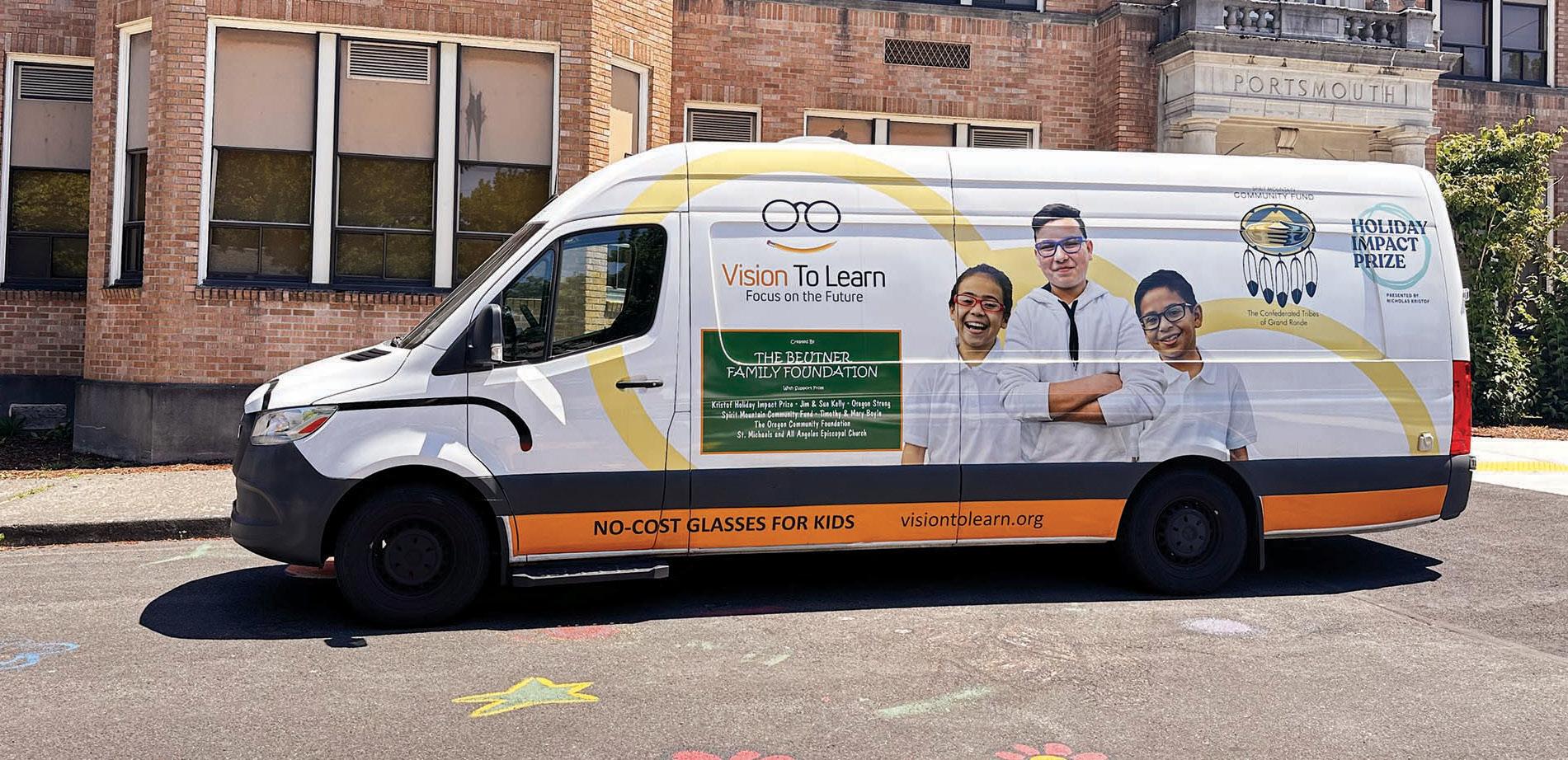
are still several more benefits, namely that students empowered with proper eyesight show remarkable improvement in learning at school. According to a John Hopkins School of Education study on the subject, providing glasses to students in need is the equivalent of adding two to six months of classroom time to their school year. That’s more effective than providing students with an iPad, and for kids with the toughest learning challenges, as effective as providing one-on-one tutoring.
“It’s rewarding to see how tangible and concrete our impact is,” says Carroll. “On any given school day in Los Angeles, there are eight mobile clinics helping hundreds of kids. There were 100,000 eye exams conducted within the 2023-24 school year alone.”
Vision To Learn’s program is a welloiled machine and children across California are all the better for the services they provide. “I would say we are the leader in this field nationally,” says Carroll. “Other cities and states are taking note of our success.”
On average, 1 out of 4 students needs glasses. In underserved communities, up to 95% of students who need glasses, don't have them.




Beutner Family Foundation
Blue Meridian Partners
Boeing Global Engagement Foundation
Deerbrook Charitable Trust
Focusing Philanthropy
Frank McHugh-O’Donovan Foundation, Inc.
L.A. Clippers Foundation
L.A. Dodgers Foundation
MetLife
OneSight Essilor Luxottica Foundation
Panda Cares
Shea Family Charities
Silicon Valley Community Foundation
Sobrato Philanthropies
The Eli and Edythe Broad Foundation
Warby Parker
Warriors Community Foundation


Making sure kids who fall outside traditional safety nets have the support, resources, and love they need to succeed and thrive.
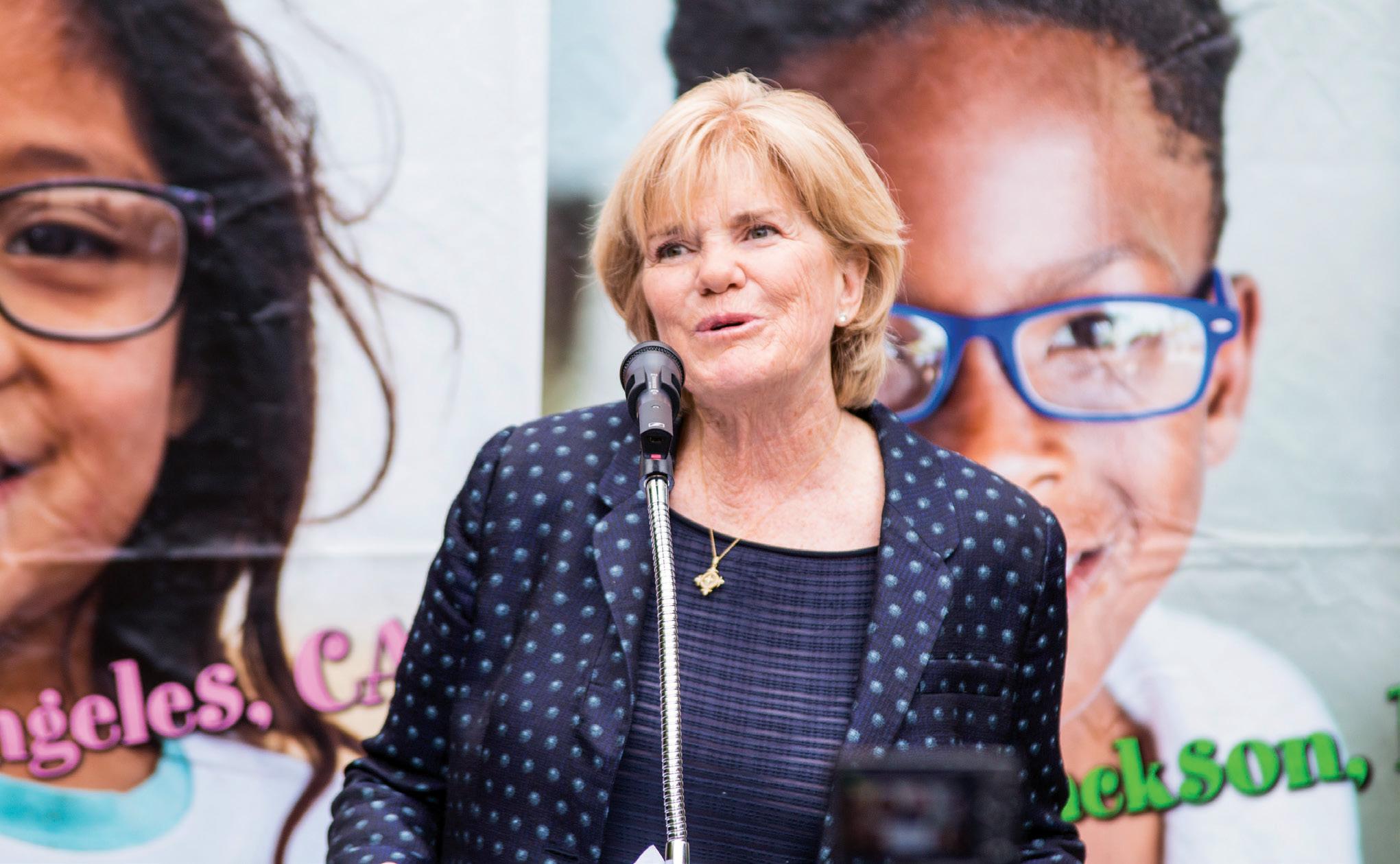
As a D.C. kid, born and raised in the political marinade of her hometown, Ann Hollister saw politics as the obvious path to public service. After years of ascending the political ranks from congressional staffer to Chief of Staff to a freshman Congressman to a veteran political consultant managing California statewide races, Hollister realized that her political experience was uniquely applicable to community service. And her pivot from politics to the nonprofit sector has allowed her to see, more directly, the profound impact a nonprofit is able to have on peoples’ lives.
As the president of Vision To Learn, a nonprofit organization, founded by Austin and Virginia Beutner, that provides vision screenings, free eye exams, and glasses to children in underserved communities,
Hollister has helped scale the organization’s operations to 14 states plus Washington, D.C., making it one of the largest school-based health services operating today. That’s a big deal when you consider that if a child doesn’t read by the 3rd grade, they’re four times more likely to drop out of high school.
Under Hollister’s leadership, Vision To Learn is on the precipice of providing its 500,000th pair of glasses to children, significantly impacting their academic performance and overall well-being. In a sector where impact is often hard to measure, that’s a slam dunk. Working to remove barriers to healthcare access for underserved communities, particularly in education, Vision To Learn’s work to access Medicaid and CHIP reimbursement means the program is not only scalable but sustainable.


Q: Can you tell me about your journey that has brought you to where you are today, focusing on your community work at Vision To Learn?
Q: What about your upbringing taught you about the importance of giving back to the community or making a difference?

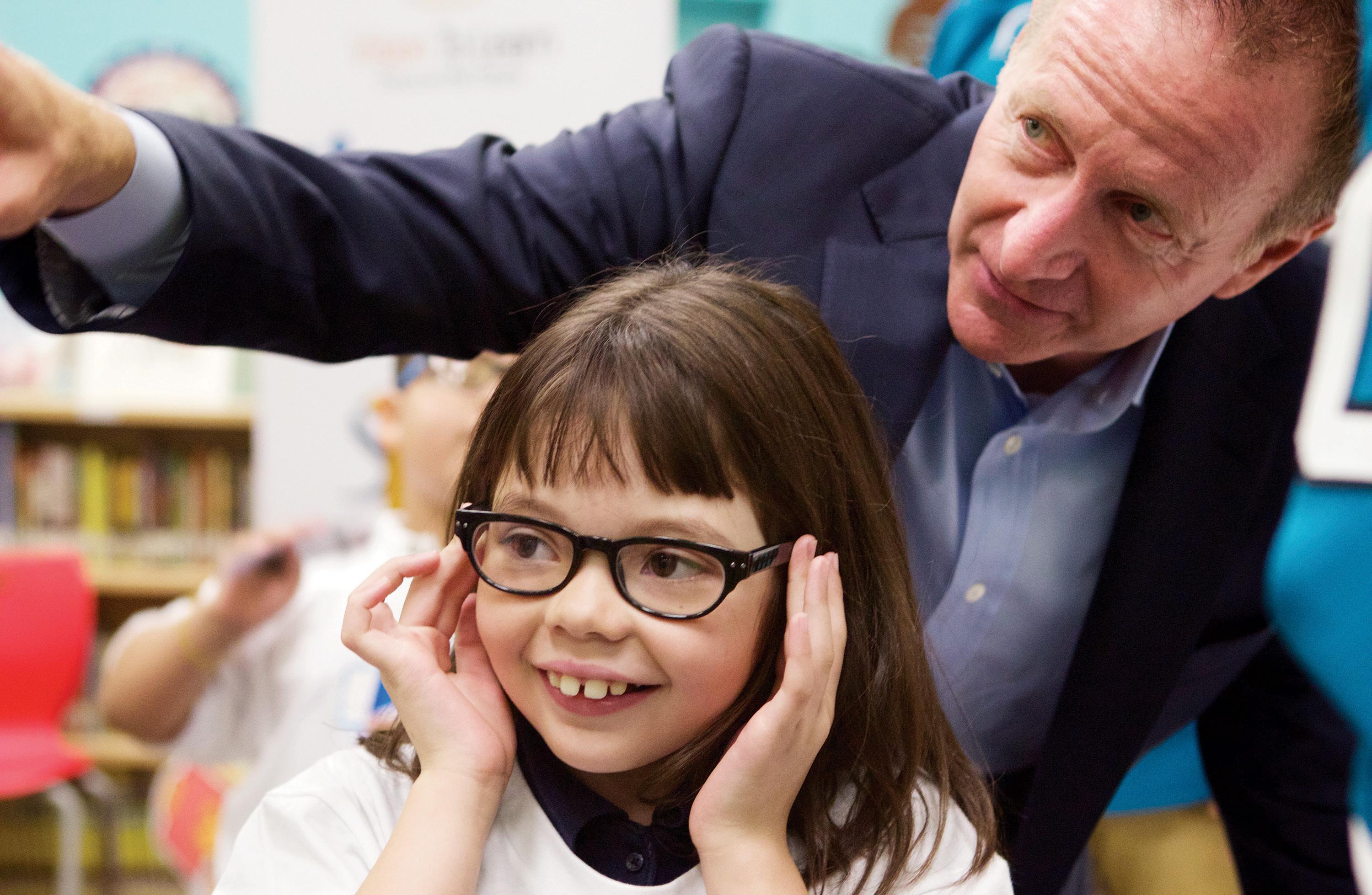
got vaccinations at school. I think school-based health services are on the rise, and we’re a model of how that can work. It removes barriers like having to take time off work or finding an optometrist who accepts Medi-Cal in underserved communities.
Q: Can you talk about the research regarding when a child needs to learn to read to have a good chance of succeeding?
A: If you’re not reading at grade level by third grade, you’re four times more likely to drop out of high school. Not a lot of good happens when that occurs. What we see every day is that “aha” moment when a kid gets their first pair of glasses. They all say the same thing: “I didn’t know the tree had leaves,” or “I didn’t know the world looked like this.” They didn’t know they couldn’t see. Johns Hopkins University, our partner in our Baltimore program, did a three-year control group study of the Vision To Learn program. The study, published in the Journal of the American Medical Association Ophthalmology, found that giving kids glasses is the most impactful academic intervention there is. For kids in the bottom quartile, it’s equivalent to four to
six months of additional learning time. It’s more impactful than everything but one-on-one tutoring.
Q: How does Vision To Learn’s funding break down between government grants and individual fundraising?
A: We’re about one-third public reimbursement or other public monies, and the balance is philanthropy. We’ve worked hard to crack the code as a nonprofit to get reimbursed for kids who are enrolled and eligible for Medicaid reimbursement. It’s not easy because the system was created for brick-and-mortar offices. We go to a school and help every kid, regardless of immigration status or insurance status, and then post-service, we try to get reimbursed for those we can find in the system.
Q: How was Vision To Learn founded?
A: Austin Beutner was deputy mayor at the time under Mayor Villaraigosa in Los Angeles. He was preparing to give a speech to a teachers’ group and asked some teacher friends about the biggest problems they faced. One of them told him that kids didn’t have the glasses they needed to be successful at school.
“The study (a three-year control group study by Johns Hopkins University), published in the Journal of the American Medical Association Ophthalmology, found that giving kids glasses is the most impactful academic intervention there is.”
Austin, an investment banker by trade, did some research and found that this was indeed a significant issue.
Q:
Do you think there are more opportunities for public-private partnerships in serving communities


“J3 Foundation addresses one of society’s most pressing issues – low literacy rates among underserved children
– with a strategic and data-driven approach.
As a founding board member, I’ve seen how every dollar invested in J3 yields measurable outcomes: higher reading scores, improved confidence, and longterm academic success. For those looking to make a meaningful impact, I can think of no better way than supporting J3’s e orts to change the course of a child’s future through literacy.”
at
Weil LLP and J3 Board of Directors Member
By Check:
J3 Foundation
11693 San Vicente Blvd., Ste. 404 Los Angeles, CA 90049
*Donation Memo: J3 Foundation: The Giving List
By DAF or Stock Transfer:
Tax ID# 35-2781785
By Credit Card: j3foundationla.org/donate
Contact: Beth Anderson
Interim Manager of Fundraising & Communications (612) 968-5570 beth@j3foundationla.org
J3 Foundation 11693 San Vicente Blvd., Ste. 404 Los Angeles, CA 90049 (310) 472-0405

“Literacy permeates everything,” says J3 Foundation’s co-founder Joe Blackstone. Imagine staring at these words and not being able to decipher them. Most people, those reading this included, take reading for granted – but 45 million adults in the U.S. are functionally illiterate (Pro Publica). Those who live with the lowest literacy skills live in poverty. J3 Foundation knows the solution lies in providing reading intervention – and fourth grade is where it matters most.
“You get to fourth grade and if you have fallen behind in your reading proficiency, you simply can’t catch up,” says Blackstone. “Two-thirds of students who can’t read proficiently by the end of fourth grade will end up in jail or on welfare.”
That’s why J3’s mission is straightforward but critical: To give kids who might otherwise be left behind the foundation they need for a lifetime of success. And for children in communities that lack resources, that becomes even more crucial.
J3’s unique approach to creating joyful, confident, lifelong readers combines in-school intervention and after-school support, using evidence-based re-
search to achieve the best outcomes. “By partnering with the schools, we can identify who needs help early and provide small group instruction that makes a huge di erence,” says Stacee Longo, J3’s senior program director. The impact is transformative.
When Rosalia first joined J3’s reading program, she looked her reading coach in the eye and said simply, “I can’t read.” Scared and convinced she’d never be able to read, she was exactly the kind of student J3 aims to reach.
J3’s Cozy Reading Club brings together highly qualified teachers, personalized lessons with measurable outcomes, culturally relevant books that hook kids into reading, and community involvement to support reading and beyond.
Rosalia joined the Cozy Club and was hooked. She even started a lunchtime book club with friends in J3. “She went from ‘I can’t read’ to leading her own book club,” her J3 reading coach shares. “The girls in the book club are taking turns reading aloud to one another, helping each other to carefully sound the words out during their lunch

Without support from a donor like you, these fourth graders risk getting left behind. Transform one child’s life for $1,500. Cover the cost of a trained Reading Coach for an entire school year at $10,000. Best of all, you could fund J3 Foundation’s expansion and make their dreams come true. $500,000 opens J3’s reading program at 10 new schools, reaching hundreds more children. Every dollar brings J3 closer to empowering more students to turn the page toward brighter futures. Please consider donating today to support this vital cause.
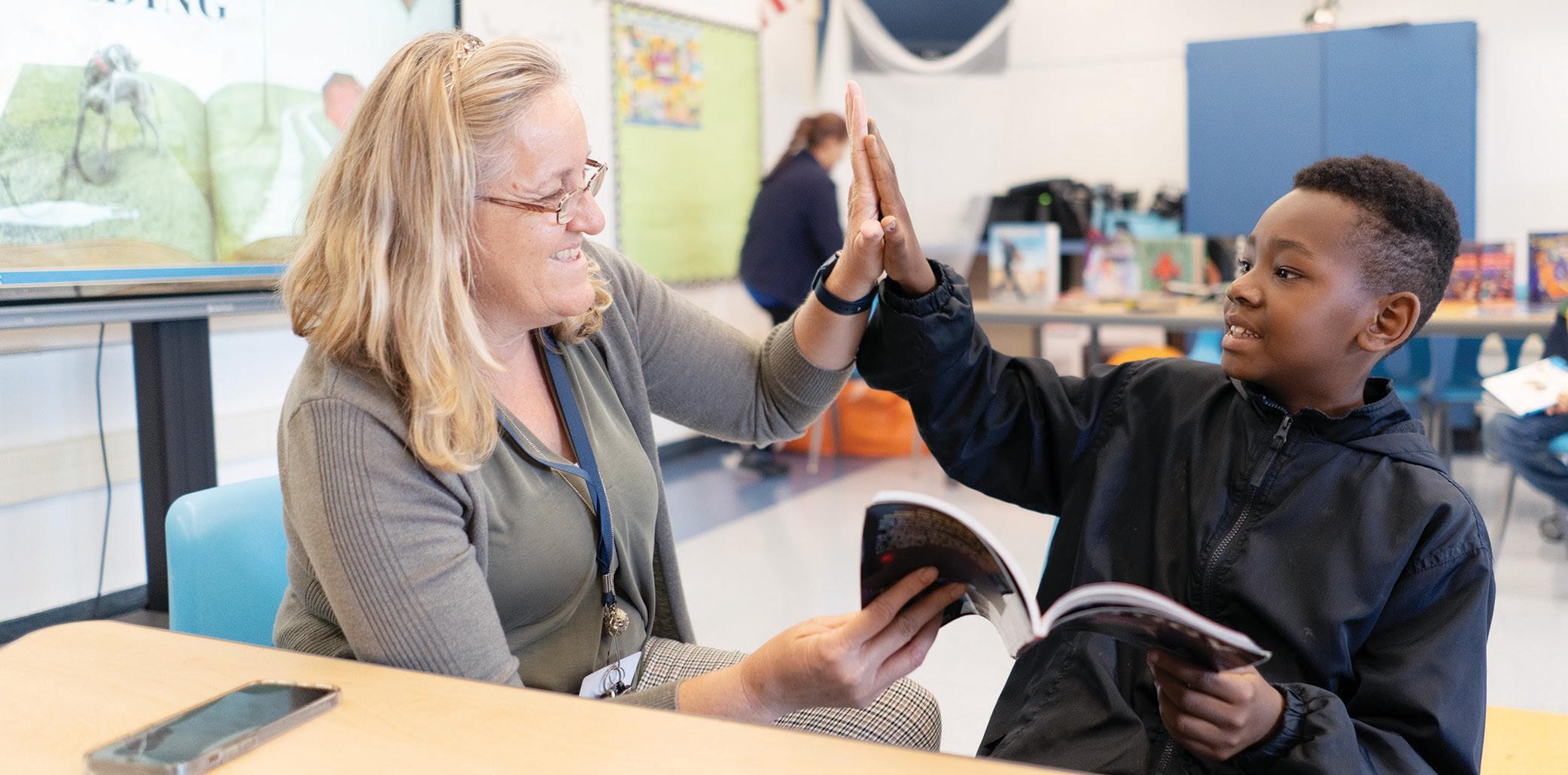
break. That’s the power of reaching kids at the right moment.”
And J3 knows exactly when that pivotal moment is and it’s what sets J3 Foundation’s individually informed reading program apart. “Fourth grade is where futures are decided,” says Blackstone. His co-founder, Jamie Mohn, adds, “We deliver the urgent help they need to stay in school and out of the justice system.”
J3 Foundation grabs kids off that precipice and opens the door to a lifetime of learning, reading, and opportunity. And their model is working.
In just one school year, J3 students saw an average of a 36-point improvement in their reading scores, while in 2022 the national average fourth grade reading score decreased by
three points (compared to 2019).
The proof is in the numbers but, more importantly, the proof is in the successful stories of new and proud readers, like Rosalia, and the hundreds more that J3 helps every year in schools across marginalized neighborhoods in Los Angeles. Readers, who, thanks to J3 Foundation, will have a whole life of opportunity ahead of them.
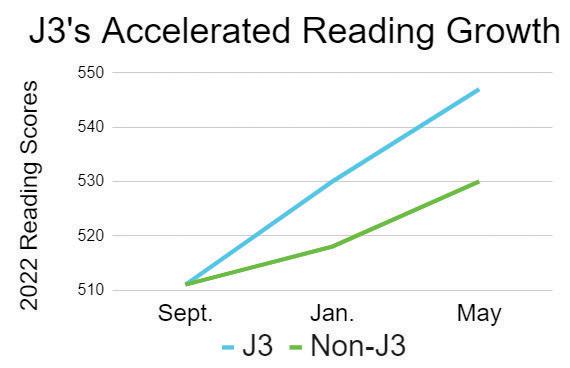
Children who fall behind in reading in fourth grade are more likely to drop out of school – or end up in jail or on welfare. J3 exists to change that.
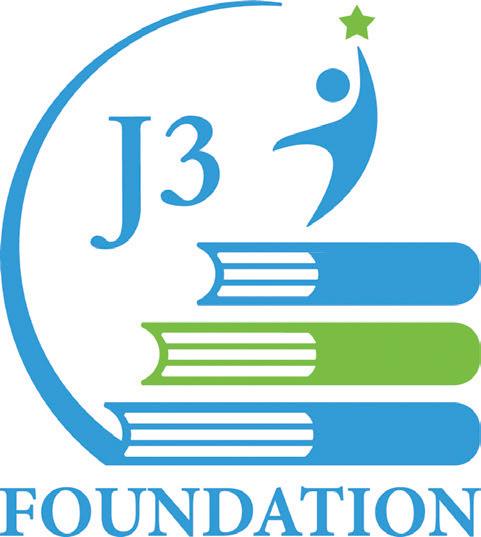
J.P. Morgan Chase
L.A. Lakers Youth Foundation
CTBC Bank Corporation
Warner Bros-Discovery: BOLD
The Book Foundation
Santa Barbara Foundation
Allied Universal
Ocean Direct
TASCHEN Books
IMB Partners
Glaser Weil LLP
Armanino LLP
Greenway Supply Co.
Jewish Community Foundation
Prem & Mary Ann Akkaraju
Philip & Yasmin Harvey
Joel & Sherry McKuin
Humberto & Maria Gray
Je rey & Nicole Westheimer
Bob & Karina Matuszak
Barry Family Charitable Trust
1 in every 20 children in California does not have a home. Homelessness has a devastating impact on children’s educational opportunities: They are 9 times more likely to repeat a grade and 4 times more likely to drop out of school entirely.
By Check:
School on Wheels, Inc.
P.O. BOX 13306
Los Angeles, CA 90013-9998
*Donation Memo: The Giving List
By DAF or Stock Transfer: Tax ID# 954422640
By Credit Card: schoolonwheels.org/donate
Contact: Sinead Chilton Chief Development & Marketing O cer (213) 905-2777 schilton@schoolonwheels.org
School on Wheels www.schoolonwheels.org 600 E. 7th Street Los Angeles, CA 90021 (805) 641-1678
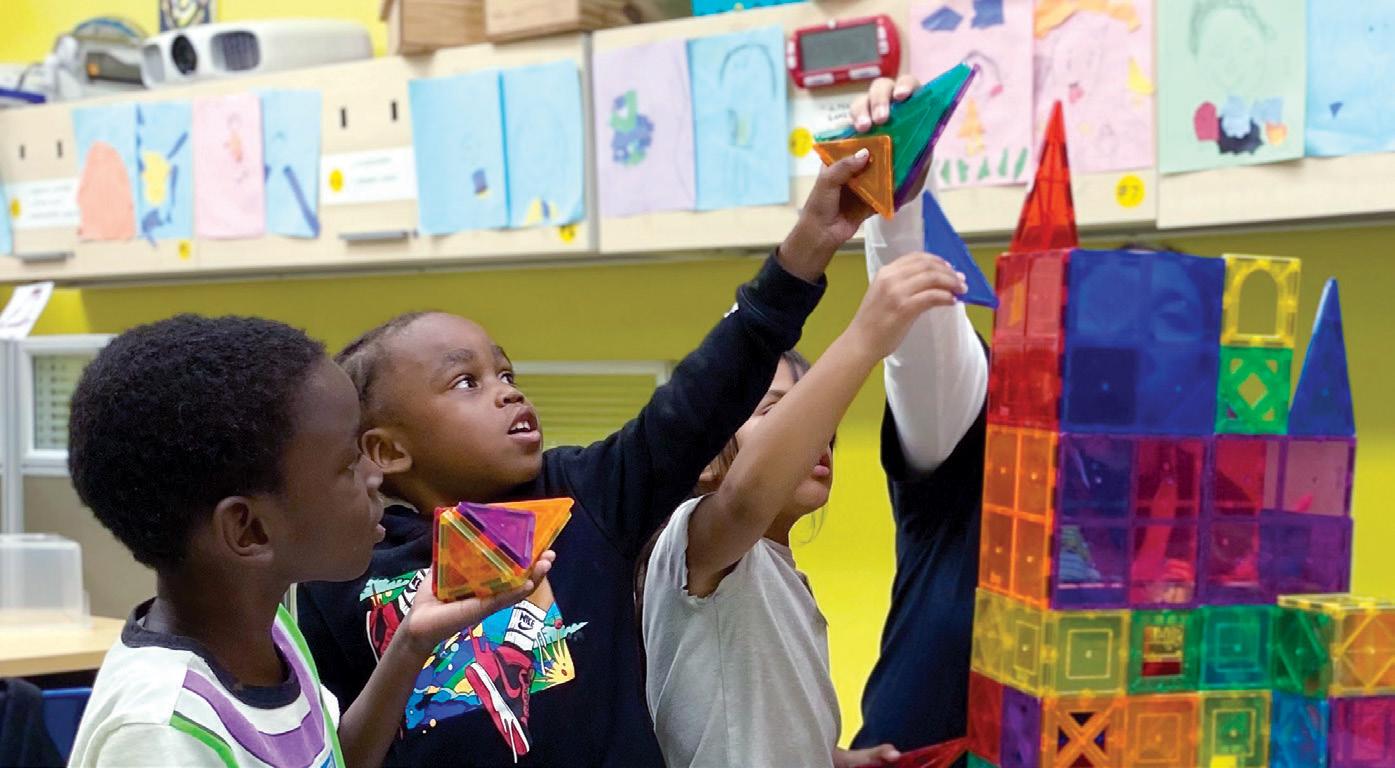
Angela M. Sanchez was a junior in high school when she was evicted from her home in Glendale, California. Her father had lost his job, and a confluence of financial and family challenges led them to months of living in di erent motels, followed by moving around to a series of shelters.
The disruption and stress made it hard for Sanchez to keep up with classes, grades, and the after-school magic club that she loved. By senior year, her once sterling grades had dropped and her dream of going to UCLA was hanging in the balance.
That’s when she found School on Wheels. The Southern California-based nonprofit provides free tutoring for school-age children and teens experiencing homelessness –which includes children living in shelters, vehicles, motels, group homes, or on the streets. School on Wheels matches students with volunteers and o ers weekly one-onone tutoring, school supplies, and assistance entering and navigating school.
In Sanchez’s case, the organization connected her with a tutor who helped with her schoolwork and with finding scholarships to support her education at UCLA where she was, indeed, accepted.
“Making that connection was the best thing that ever happened to me while being homeless,” says Sanchez, in an interview with Upworthy School on Wheels was founded in 1993 by Agnes Stevens, a retired teacher who worked in Venice and saw firsthand how homelessness disrupted her students’ education. In the 30 years since, the organization has worked with more than 50,000 students across more than 400 sites in the region.
The statistics are staggering. According to School on Wheels, in California overall, one in 20 children is experiencing homelessness. In L.A. County there are 65,484 students without homes. These children are nine times more likely to repeat a grade and four times more likely to drop out of school entirely. School on Wheels is the only organization in Southern California exclusively dedicated to the educational needs of this fragile population.
“The statistics highlight a crisis that demands our immediate attention. Every child deserves the stability and support necessary to succeed academically. At School on Wheels, we are committed to providing essential educational support,
“The more money we have, the more volunteers we can recruit, and the more kids we can help,” says Sinéad Chilton, chief development and marketing o cer.
When funding increases, School on Wheels can increase the range and depth of what it can o er, including agespecific programs.
“With elementary students, we focus on reading and literacy,” says Chilton. “For middle school, we focus on academics. For high school, we focus on opportunities for after school.”
Plus, the organization o ers scholarships for all its students, for things like ballet lessons or sports.
Every dollar donated means an unhoused student gets a chance to succeed.
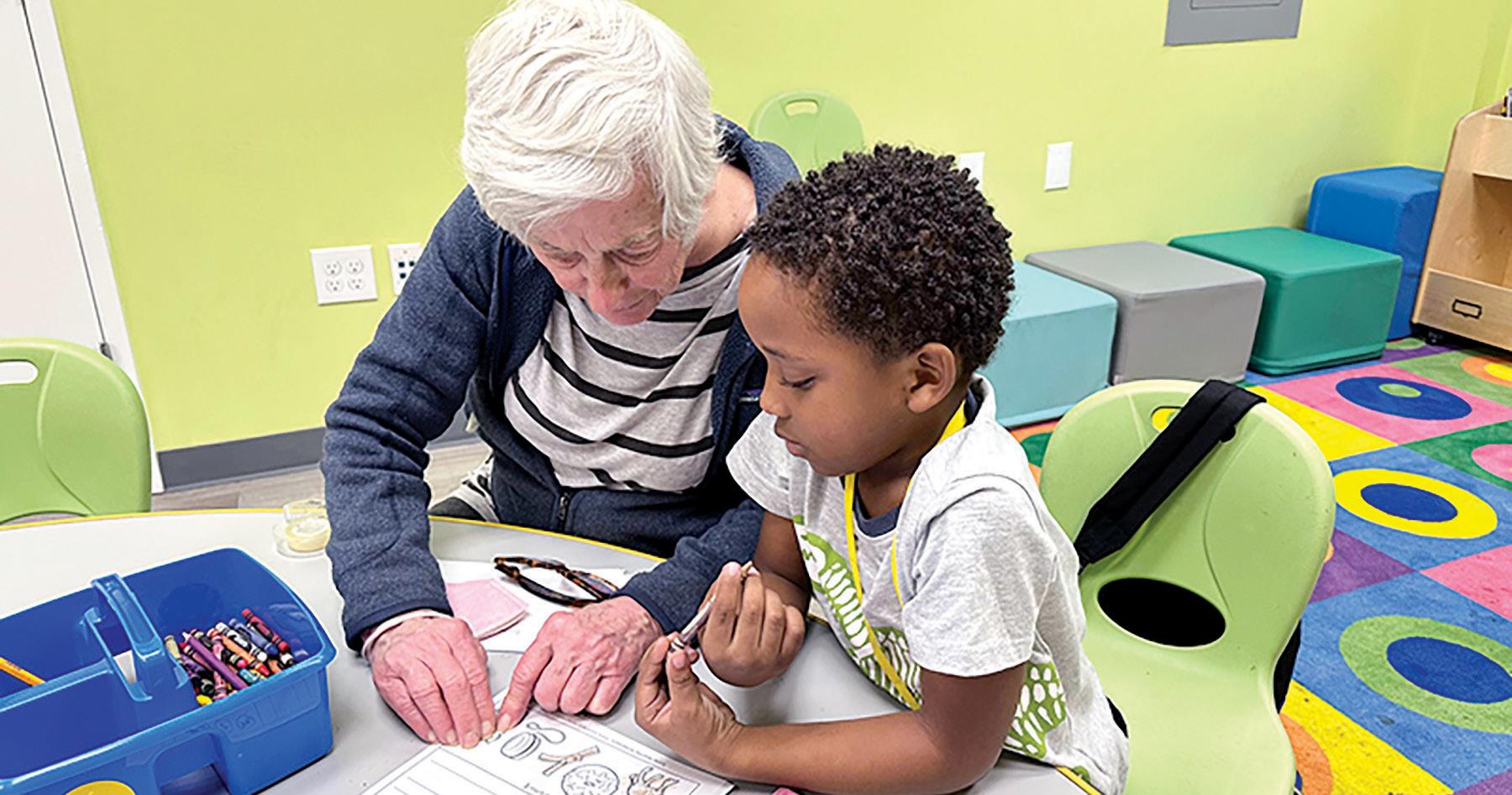
giving hope and opportunity to the most vulnerable members of our community,” says Charles Evans, executive director.
For Sinéad Chilton, chief development and marketing o cer for the organization, the power of its work lies in the connections it creates between students and positive role models.
“We spend a lot of time recruiting and training and retaining volunteers,” says Chilton, who started as a volunteer. The students’ lives, she adds, “are so di cult. They might not know where they’re sleeping tonight. They might not know what they’re eating.”
Chilton adds, “It takes so little to help a child. That’s the basic model of School on Wheels. We can’t end homelessness, but we can put the tools in place so a child doesn’t have to repeat that cycle.”
Evans says including children in the discussion around homeless prevention is a key to breaking that cycle. “It’s crucial that we recognize and address the unique challenges faced by unhoused students to break this cycle and pave the way for a brighter future for all.”
And that’s exactly what School on Wheels is doing.
“M y tutor helped me so much.
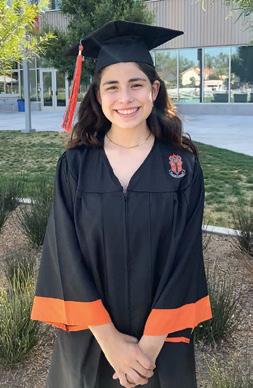
She helped me with Math, Chemistry, getting ready for my SAT, pretty much anything I needed help with. It was always nice to see her. I looked forward to my sessions with her. My dream job is to become a graphic designer and work in the marketing field. I will be attending Orange Coast Community College in the fall and would like to transfer to Redlands University after I complete my general ed.”
– Leilani L. School on Wheels High School Graduate

The Eisner Foundation Inc.
Dora F. Levit Fund for People Windsong Trust
The Green Foundation
Snap Foundation
Universal Studios Hollywood’s Discover A Star Foundation
Annenberg Foundation
USC Good Neighbors Campaign
Los Angeles Lakers
Youth Foundation
The Crail-Johnson Foundation

...AND LEARN MORE ABOUT SCHOOL ON WHEELS
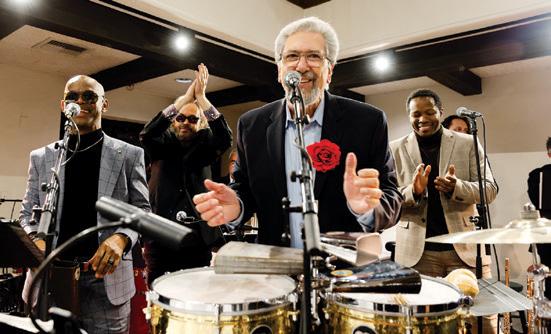
“I’m involved with Neighborhood Music School through (board member) Germaine Franco. It has been around for 110 years- I couldn’t believe it! It’s a wonderful place where kids that love music and might not have the ability -because maybe their parents can’t afford it- to have classes and be involved. This school allows that access. That’s the beautiful thing about Neighborhood Music School. Literally, I cried when we were playing. I got watery eyes because it was so emotional to see these kids. It’s just love, man. Music is love.”
– Luis Conte Percussionist, composer, musician
By
Check: The Neighborhood Music School Association
358 S. Boyle Ave Los Angeles, CA 90033
By
DAF or Stock Transfer: Tax ID# 95 6002180
By Credit Card: neighborhoodmusic.org/supportnms
Contact: Karen Louis Executive Director (323) 268-0762 ext. 7 karen@neighborhoodmusic.org
Neighborhood Music School www.neighborhoodmusic.org
358 S. Boyle Ave Los Angeles, CA, 90033 (323) 268-0762
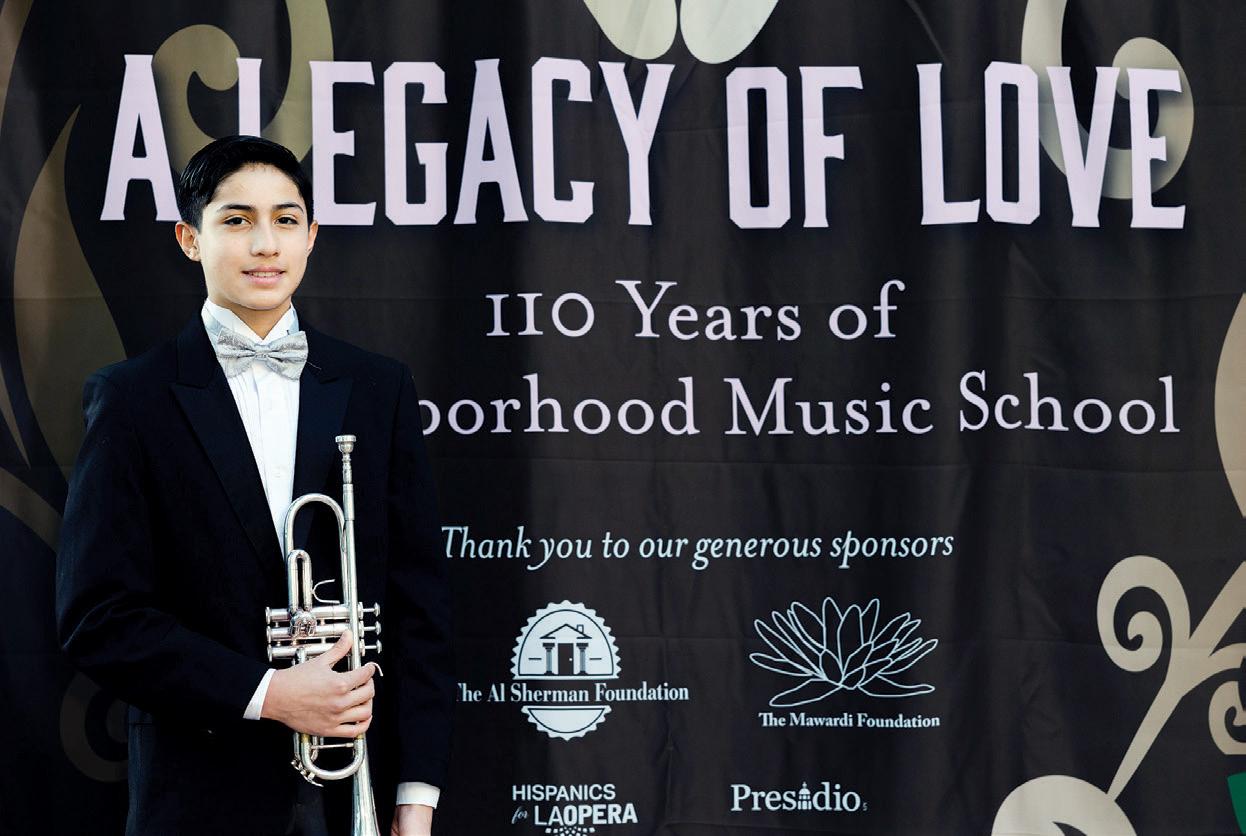
Neighborhood Music School has been a musical home for generations of families going back a century in Boyle Heights.
Located in an old Victorian house since 1933, the school was originally founded in 1914 as a place for newly arrived immigrants to learn English and music.
“Neighborhood Music School is one of those safe spaces. You come here, it’s almost like you’re stepping out of time, into your own unique journey,” says Karen Louis, executive director. “Physically, it feels like you’re going into your grandmother’s house or your auntie’s house, like you are literally stepping back in time. But personally, every student is received by their teacher/mentor at the level they are at with their own goals in mind. Whether it is at age six and they’re seeing a piano for the first time or they’re 66 and they are learning guitar for the first time.”
The school provides low-cost, highquality one-on-one music instruction to those who need it most. Its scholarship program means the low-cost fee can
be as low as $5 per month for many of their families, the instrument rentals are also low-cost, and group lessons are free. No one is turned away for need. For many students and families, music lessons would be unaffordable without the Neighborhood Music School.
Students also have unparalleled opportunities to connect with professional musicians. The school recently hosted a master class with acclaimed pianist Althea Waites in partnership with Piano Spheres. In 2023, students worked with groundbreaking Grammy-winning Latina composer Germaine Franco, an NMS board member, and performed her songs from the Disney film Coco with the L.A. Master Chorale at the Walt Disney Concert Hall.
The school is proud to be a warm and welcoming gathering place for the neighborhood. It opens its doors to the community for movie nights, concerts, and special events throughout the year. And it is a safe, uplifting, artistic home to its community of families, teaching artists, and students.
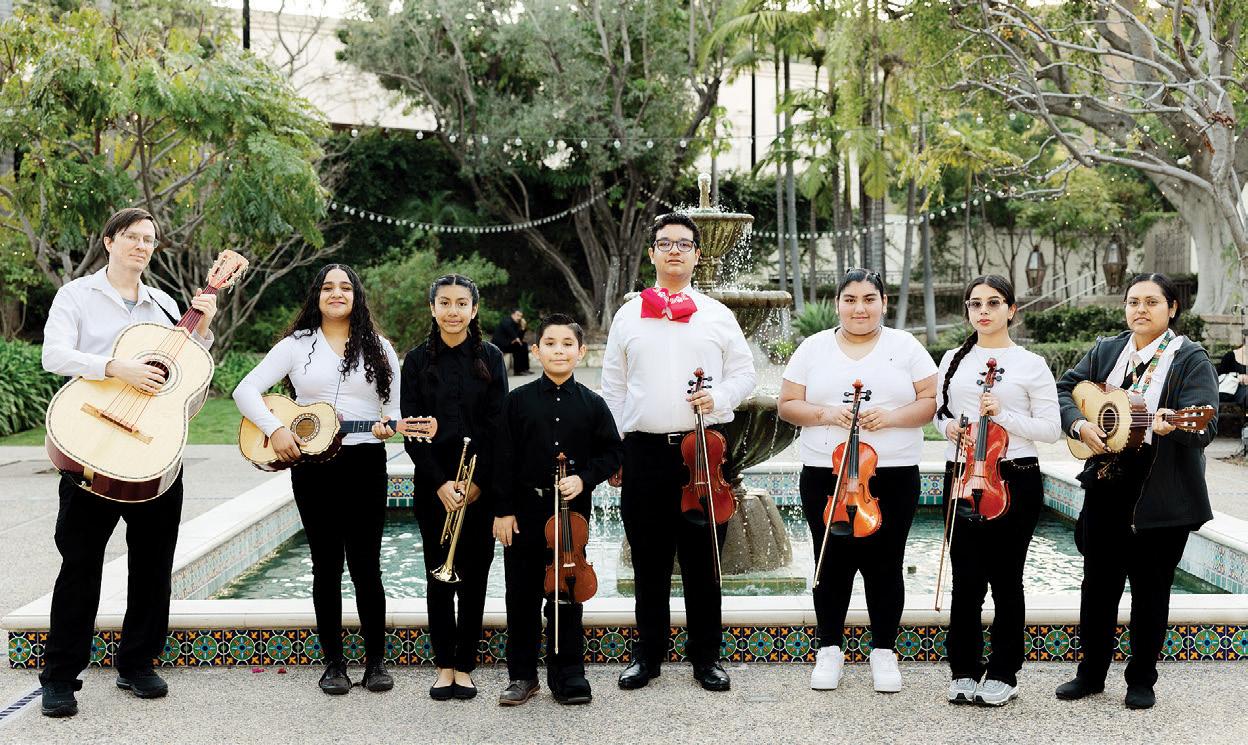

“I have always loved music and I completely fell in love with the clarinet the first time I heard it,” says Victor Eliseo Rivera, 20, who has been taking lessons since he was 16. “It is a way for me to enter into a world where the stress from work and the expectations I have from family and school do not apply. Whenever I stop and play the clarinet, I feel that nothing can go wrong and that I have something to offer the world.”
Neighborhood Music School teaches over 350 students per month at the school, and its outreach program serves an additional 400+ students in partner
schools like PUENTE Learning Center, the John Tracy Center, Long Beach Unified School District, and Little Lake School District. The students learn piano, classical string, brass, and reed instruments, as well as percussion and voice from accomplished teaching artists, some of whom are Neighborhood Music School alumni.
“When you come into Neighborhood Music School,” Louis says, “you have the opportunity to give a literal voice to the music that’s inside you and that’s really important and it’s something that can be shared and something that can heal.”
Neighborhood Music School is deeply rooted in equity and inclusion. It has been lovingly teaching music to the immigrant communities of Boyle Heights for generations.
Every year, the school awards $80,000 in scholarships. This year it has set a goal of raising $200,000 to allow the school to continue its robust scholarship program as well as to expand that program and take on more underserved students from other areas of need in Los Angeles.
The Neighborhood Music School was established by musician Carrie Stone Freeman with $1,000 in 1914. With a donation of $1,000 today, you can join its Founders Circle and enjoy special performances and events at the school. Your donation will enable hundreds of low-income students, from across L.A. County, the opportunity to learn music and change their lives, one note at a time.
Neighborhood Music School provides over $80,000
in tuition scholarships annually to ensure that every student has access to highquality, individual instruction to support their unique musical journey. 1/3rd of our student enrollment participates in the Student Scholarship programs.
The Perenchio Foundation
The Al Sherman Foundation
Colburn Foundation
Ralph M. Parsons Foundation
Mawardi Foundation
Pasadena Showcase House for the Arts
Clarence E. Heller Foundation
City of Los Angeles Department of Cultural Affairs
Los Angeles County Department of Arts & Culture


No great society has existed that didn’t grow its children and youth in the fertile soil of education. For their contributions, we applaud the organizations that put their shoulders to this important task.

Tiffany Miranda is a singer, songwriter, and philanthropist who has dedicated her life to empowering young women in the music industry. At the age of 19, she appeared as a contestant on American Idol and The X Factor, experiences that exposed her to the male-dominated world of music production. Recognizing the lack of female representation in creative control positions, Miranda founded Girls Make Beats, a nonprofit organization that provides young girls with the tools, knowledge, and opportunities to become the next generation of music producers, DJs, and audio engineers.
Over the past 12 years, Girls Make Beats has grown from a grassroots initiative to a nationally recognized program. Under Miranda’s leadership, the organization has partnered with major artists and brands, providing its participants with real-world experiences and industry connections. Miranda’s work has contributed
to a measurable increase in female representation in music production, with recent statistics showing a rise from less than 3% to 6.5% of women in the field.
In addition to her work with Girls Make Beats, Miranda continues to create music and is launching a new online show to highlight underrepresented voices in the music industry. Her commitment to gender equality and economic empowerment in entertainment continues to inspire and change lives.
Q: Can you tell us about your journey from being a young singer to founding Girls Make Beats?
Tiffany Miranda: Absolutely. It all stemmed from my love for music. I grew up in a family that was rich in love but not in resources. My parents always supported my dreams but couldn’t provide the means to achieve them. So, from a young age, I had to work and save for everything I wanted to do in music.

“Not seeing women who looked like me in powerful positions, I knew I had to be that change.”
When I was eventually able to attain the things I needed for my career, I wanted to create a lane to give back to girls who were just like me when I was 11 years old, just wanting to sing and be exposed to music but having no resources.
I faced many challenges, including being in


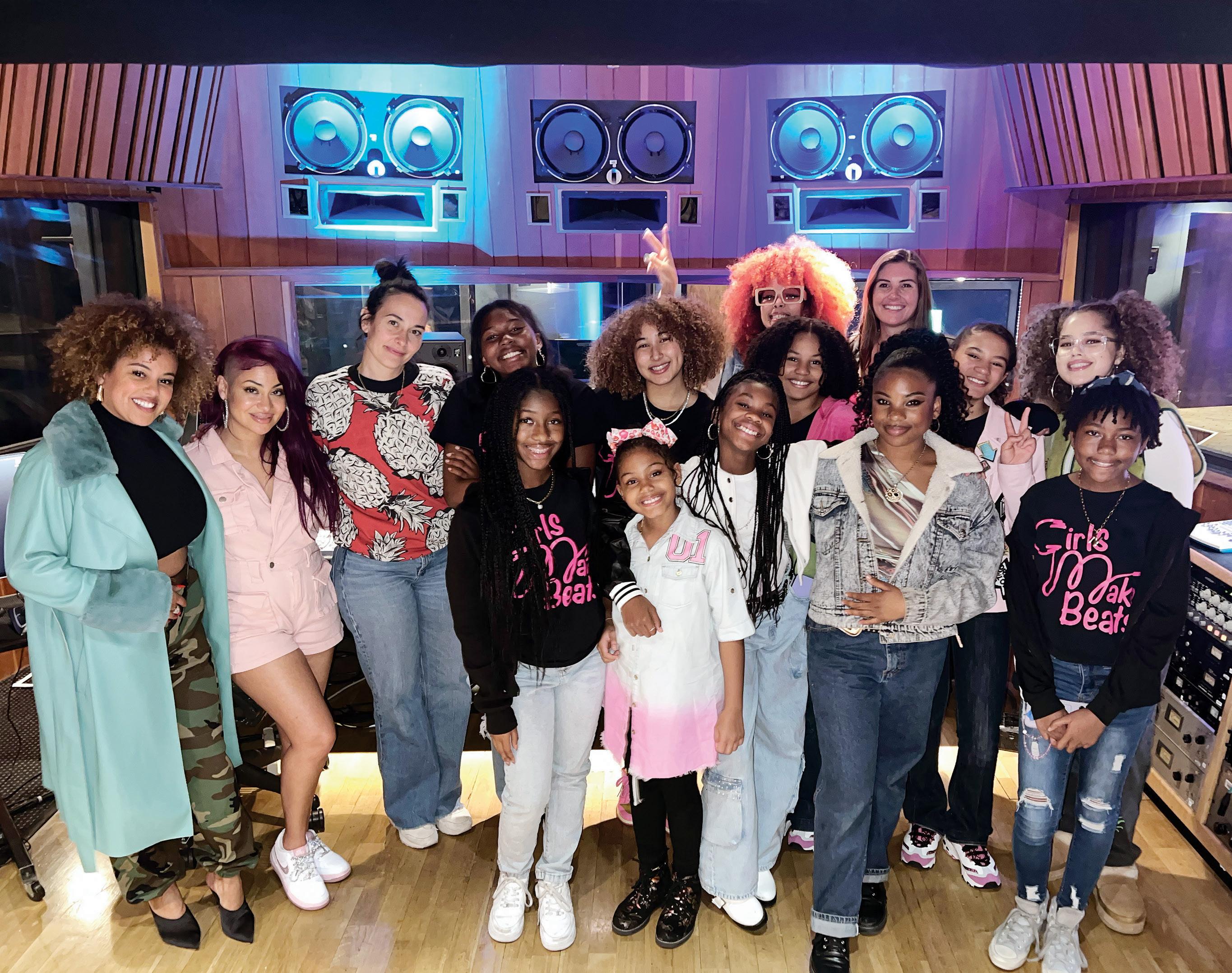
Q: Have you seen a noticeable uptick in women audio engineers and women in positions of creativity and control in the music business since you started?
A: Absolutely. Social media has played a role in this, providing more visibility for women and girls DJing and creating music. Also, easier access to technology means girls can learn without being in intimidating male-dominated spaces. Statistically, we’ve seen progress too. A few years ago, less than 3% of music producers were women. This past year, it went up to 6.5%, more than doubling. The Annenberg Inclusion study credited Girls Make Beats for helping to make this change happen. We’re also seeing impact through our alumni. For example, Kaiya Nyasha, who started with us at 16, graduated from Berklee at the top of her class and now works at a major record label with Billie Eilish. She continues to create opportunities for our young girls and mentor them.
Q: What advice would you give to other passionate philanthropic entrepreneurs about starting a small, grassroots nonprofit?
A: Never underestimate the power of an idea. Sometimes, when I’m at events put together because of Girls Make Beats, like our inaugural gala, I look around the room and think, “Wow, what if I had just let it be an idea and allowed the fact that I had no resources to limit me from this moment?”
It’s important for others to know that as an individual, we have an extreme amount of impact. Sometimes we feel like, “Oh, well I’m just one person” or “I don’t have access to X, Y, Z,” but let me tell you, positivity works 10 times harder and better than negativity. When you think about the effects that one bad person can have, love and positivity are way stronger than that, even with just one person. That would be my advice.


“I think it’s extremely important as philanthropists,

Despite being back in school buildings, students remain disconnected and disengaged from school. Less than 50% of students report being actively engaged in learning, and the number of chronically absent students has doubled post-pandemic.
By Check: Citizen Schools, Inc.
1 Beacon Street Boston, MA 02108
*Donation Memo: The Giving List
By DAF or Stock Transfer:
Tax ID# 04-3259160
By Credit Card: citizenschools.org/donate
Contact: Jessica Davila Managing Director of Philanthropy JessicaDavila@citizenschools.org
Citizen Schools www.CitizenSchools.org
1 Beacon Street Boston, MA 02108

Jose Melo was a middle school student in the Boston area when he was introduced to a resource that would forever change his life: the nonprofit Citizen Schools. “He was attending a school that was underperforming, under-resourced, and didn’t have a lot of opportunities for kids outside of school,” says Nadia K. Selby, the CEO of the organization. Through Citizen Schools, Melo was introduced to a STEM apprenticeship and mentoring program that inspired his love of mathematics and science, which ultimately led him to pursue a career in biotech, where he is flourishing. “Two years ago, he came and did a panel for us and talked about how Citizen Schools really ignited that in him,” says Selby.
Melo is just one example of student success stories empowered by Citizen Schools. Back in 1995, Eric Schwarz, the founder of the organization, strongly believed that professionals were underutilized in public education. He wanted to bring their knowledge, skill sets, and enthusiasm into the classroom through one-on-one mentorship and experiential learning to enhance the school curriculum for the students.

And Citizen Schools was born. The organization specializes in giving middle school students a more well-rounded, energizing approach to learning by creating opportunities where students can thrive, learn new skills, and be set up for success into adulthood.
“If we can make classrooms built with opportunities to learn, grow, and discover moments of joy, then students not only get excited about learning but they can build the skills over time that they need to be successful and pursue higher education,” says Selby.
Citizen Schools partners with public schools and educators to transform classrooms into vibrant spaces of learning and discovery. Teachers receive support and 1:1 coaching to turn their lessons into engaging, hands-on experiences. Volunteers, who are carefully vetted, are personally matched to classrooms and work side by side with students to bring learning to life and serve as ongoing mentors. They engage with students in a variety of ways from completing projects to providing insight into future careers to helping to cultivate strong public speaking skills. Volunteers have come from such widespread professional
Overthe past 28 years, Citizen Schools has engaged over 50,000 middle school students in hands-on, relevant, experiential learning, collaborating with 650 educators nationwide to help transform the traditional classroom model.
Citizen Schools partners with underperforming public schools to transform classrooms into vibrant spaces of learning and discovery. These life-changing opportunities become possible with classroom sponsorship.
A donation of $5,000 supports up to five classrooms, provides five teachers with year-long program enrollment, and trains at least 15 career mentors, ultimately impacting the lives of up to 500 students.
backgrounds such as Dell, Amazon, the U.S. Environmental Protection Agency, and Duke University.
Each individual Citizen Schools site is different based on geography and need. “I’m from New York, and a school in the Bronx is very different from a school in Queens,” explains Selby. “Although they serve the same population of students, their backgrounds, where they’re coming from, all of the components are very different, and what we do is tailor our approach to meet the needs of the community and the school.”

An approach they believe is easily scalable among all middle schools, through key partnerships. “We want to go deep within a community and make sure that we are serving the whole community and the schools within them,” says Selby.
In just one year of its partnership with AmeriCorps, Citizen Schools reached 35,000 students from grades K-12, proving that classrooms, educators, and students are eager to embrace their innovative, experiential learning practices to set students up for success.

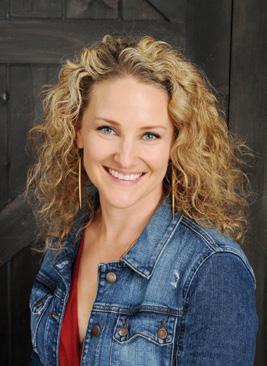
“C itizen Schools’ approach to education aligns with principles of student-centered learning, community engagement, and equity that are essential components of effective teaching. Citizen Schools incorporates project-based learning into its programs, where students work on extended projects that require critical thinking, problem-solving, and collaboration. Additionally, this work is done in partnership with local professionals and resources in our own community, providing opportunities for mentorship, networking, and exposure to diverse career paths. This helps our students extend their education beyond the classroom and connect to the broader community.”
– Annie Ransom Teacher on Special Assignment, Rio School District

Citizen Schools brings together educators, schools, and communities to catalyze collaborative relationships. The result transforms education to prepare students with the mindsets, skills, and authentic relationships they need to succeed and flourish.

MacKenzie Scott
AmeriCorps
Siegel Family Endowment
Microsoft
Dell
Fidelity
Liberty Mutual Foundation
The William H. Donner Foundation
The Baupost Group
All Points North Foundation

Josiah Gouker joined Matriculate as a High School Fellow in 2017 from his hometown in Yucca Valley, California. He ultimately chose to enroll at Princeton, where he then served as an Advising Fellow and Matriculate intern. After graduation, he joined Matriculate as a full-time staff member!
By Check: Matriculate
c/o Teach for America
25 Broadway, 12th Floor New York, NY 10004
*Donation Memo: Matriculate: The Giving List
By DAF or Stock Transfer:
Tax ID# 35-2531989
By Credit Card: matriculate.org/donate
Contact: Shikha Bhatnagar Vice President, External Affairs (646) 408-3561 sbhatnagar@matriculate.org
Matriculate Matriculate.org
c/o Teach for America
25 Broadway, 12th Floor New York, NY 10004

Imagine a high school student in the 90th percentile or higher of their class who is enthusiastic about learning and has a desire to pursue higher education but doesn’t have the resources or information to make their dreams a reality. Studies show that half of high-achieving, low-income students don’t apply to a single college or university that is an academic match. Welcome to the concept of “undermatching.” It can be life-changing for tens of thousands of students.
“Undermatching,” says Bryden Sweeney-Taylor, CEO and co-founder of Matriculate, “is when high school students who are more than qualified to be at top tier universities, are simply not applying or enrolling. They don’t even know where to begin.”
What factors might turn a high-achieving university candidate away from even applying? “A fair amount of students we serve are first-generation college goers,” Sweeney-Taylor says. “So it could be that they’re not in family units or communities where adults who have gone through this can help with the process. So, their resources are just limited. There is also an element of coming from a low-income community and just cul-
turally discounting yourself from certain opportunities for which you’re qualified.”
Matriculate – a national nonprofit – is solving the undermatching problem by connecting high-achieving high school juniors and seniors from marginalized communities to highly-trained undergraduate advisors called Advising Fellows, who are themselves college students at top colleges and universities. These near-peer advisors provide personalized support to up to four high school students about the college selection, application, and enrollment process.
Near-peer advising is done virtually via text, video chat, and document sharing. “Technology is enabling that personal touch because our advisors can talk to these students wherever they are,” says Shikha Bhatnagar, Matriculate’s VP of external affairs. “So we’re blending that human element with that technology element. This is key to our model.”
“Technology also allows us to reach students in ‘recruitment deserts.’ Rural students,” Sweeney-Taylor adds, “are also high-achieving, but have far fewer resources than their urban counterparts.”

Thanks to the generosity of several key donors across California, donations made through The Giving List will be matched up to $100,000!
• $100 recruits one high school student for our Fellow program
• $500 recruits and trains one college student for our Advising program
• $1,000 covers the full Matriculate experience for one high school student
• $2,500 provides a yearly stipend for low-income college students (Advising Fellows)
• $5,000 supports a Matriculate launch at a new college or university in California
• $10,000 recruits and trains 20 Advisors, supporting 60 high school students
• $15,000 funds the launch of a targeted marketing effort to reach more underrepresented and lowincome high school students across California
“Your high schooler might be coming in from a really small community,” says former Advising Fellow Kristen Altman. “And you could be the first person to tell them: ‘Hey – this is possible!’”
Since its inception 10 years ago, Matriculate has served over 17,000 high school students across the country and has collaborated with over 4,000 undergraduate Advising Fellows who have delivered free advising to its High School Fellows (HSFs). California is the second most popular home state for Matriculate HSFs and
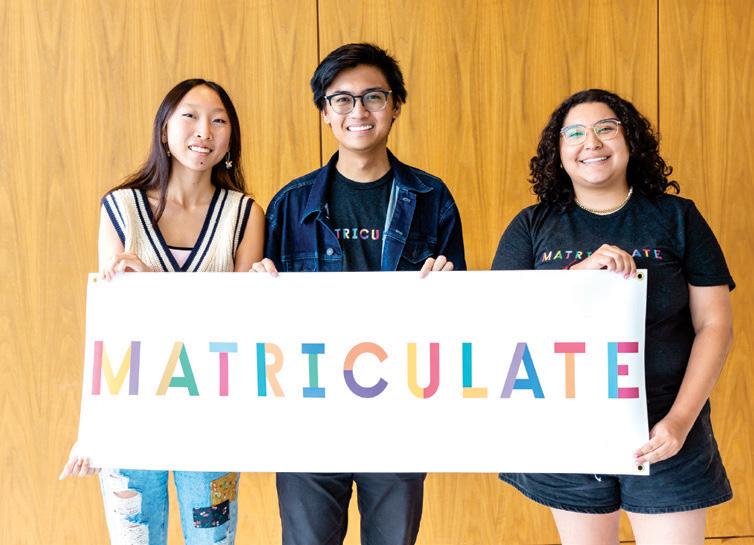
the most popular home state for Matriculate Advising Fellows.
Matriculate also partners with colleges and universities to support Advising Fellows on their campuses. Key partners include Stanford, Princeton, Notre Dame, and Johns Hopkins. Most of Matriculate’s Advising Fellows in California attend one of Matriculate’s three fellowship campuses in the state: Berkeley, UCLA, or Stanford. Not only do they serve as host sites for their college advisors, but college partners are also deeply involved in recruiting HSFs from underrepresented communities through webinars and resource guides. Matriculate is working with new college partners committed to meeting the full financial need of HSFs who enroll on their campuses.
Unlike so many challenges facing our communities, undermatching is solvable. Through Matriculate’s nearpeer advising model, high-achieving high school students from underrepresented communities are discovering new pathways to their future.

“As with many of our most dedicated supporters, my passion for Matriculate’s mission is deeply personal. I understand firsthand the challenges that many of our country’s brightest students face in navigating their way to top colleges. I am truly impressed by Matriculate’s ability to connect with over 3,000 high-achieving high school students each year, and I am proud of our impact. I look forward to expanding our reach, thanks to support from donors like you!”
– Gregory P. Spivy
Chair-Matriculate Board of Directors
Spivy Private Capital
Jonathan Ashtor, Esq.
Bank of America
Bloomberg Philanthropies
Jasanna Britton
Citadel
Matthew Cullinan
Emerson Collective
Miecha Forbes
Jed Hart
The Ichigo Foundation
Jack Kent Cooke Foundation
Jenesis Group
Madeline Kerner
Jim Larimore
Charley Moore
Jessica Ogilvie
Kim Collins Parizeau
Lynn Anderson Poole
Arthur Rock
Schusterman Foundation
Dane Skillrud
Gregory P. Spivy
Bryden Sweeney-Taylor
Lauran Tuck
In the US, only 21% of Latinx adults ages 25 and older had a bachelor’s degree or higher as of 2023, compared to 42% of their white peers.
The Many Ways to Give...
By Check:
PUENTE Learning Center
501 South Boyle Avenue Los Angeles, CA , 90033
*Donation Memo: The Giving List
By DAF or Stock Transfer:
Tax ID# 95-4242175
By Credit Card: www.puente.org/donate/
Contact: Matt Wells
Vice President of Advancement (323) 780-5312 matt@puente.org
PUENTE Learning Center puente.org
501 South Boyle Avenue Los Angeles, CA 90033 (323) 780-8900

Josue, a student who attended Mendez High School in the Boyle Heights neighborhood in Los Angeles, is confident that he’ll become the first in his family to graduate from college. That’s largely because the son of Mexican immigrants received help in applying to college and financial aid from PUENTE Learning Center’s stellar College and Career Program. Josue was awarded a PUENTE college scholarship, worked as a teacher’s assistant for the nonprofit’s summer camp, and is now a freshman at the University of California, Riverside.
PUENTE Learning Center’s innovative college access program made him feel welcome and “helped me achieve my goals step by step,” says Josue, who aspires to work in the field of mathematics. Josue is one of several thousand people served each year by PUENTE Learning Center, which provides holistic and meaningful learning opportunities to multiple generations of socioeconomically disadvantaged residents in the Greater Los Angeles area.
“It’s about connecting students and their families to necessary resources and, most importantly, helping them complete
their education so they can keep going up the ladder to attain their life goals – all to support their economic success, which everyone should be entitled to,” says Jerome Greening, the nonprofit’s chief executive officer.
The grassroots nonprofit was founded by a Catholic nun in 1985 to support below-grade level students at elementary schools in Boyle Heights. Sister Jennie Lechtenberg began tutoring students at neighborhood schools in the summer and eventually started teaching English classes to immigrant parents and grandparents. Four decades later, PUENTE Learning Center offers a highly-rated California state preschool program, a Los Angeles Unified School Districtauthorized K-5 charter school, its 10-year college and career readiness program, and a robust adult education program that includes a pathway to English proficiency, a high school diploma, and workforce readiness.
Through its integrated services, PUENTE’s staff also connects their clients to housing, food security, immigration, financial literacy, and parenting education to help curb any disruptions in student learning. Ninety-eight percent of PUENTE’s clientele is Latinx.
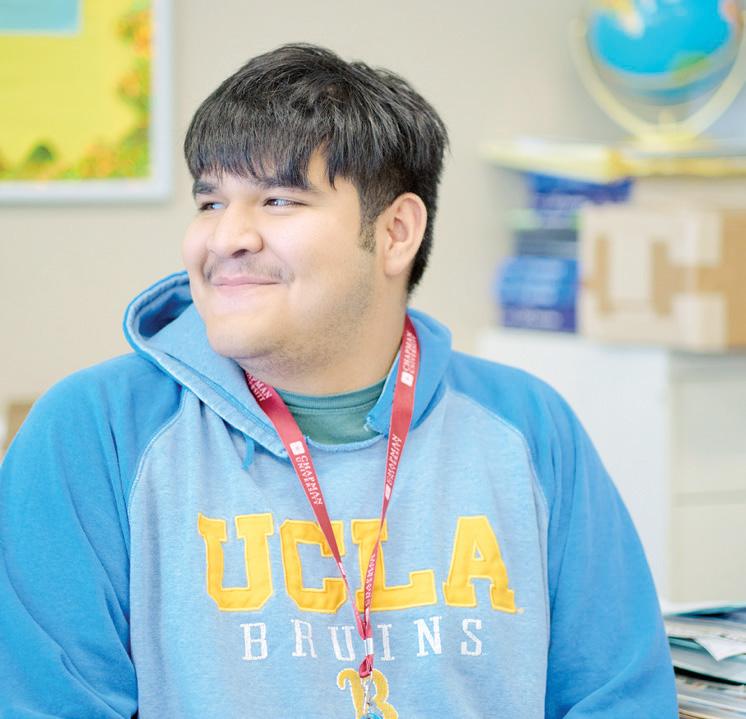
Learning Center’s College and Career Program supports socioeconomically disadvantaged Latinx students, like Josue, to succeed in college. The program has a remarkable track record, with 98 percent of post-secondary students persisting towards their degree.
Each $3,000 donation covers program costs, including scholarships, to help an L.A.-area college student with essential needs like food, textbooks, and transportation so they can stay in college and graduate, says Matt Wells, PUENTE Learning Center’s vice president of advancement. The total amount of money needed is $500,000 to fund the program through 2025.
“While non-PUENTE scholarships might offset their tuition, PUENTE scholarships offset their basic needs, which are key for low-income students to persist through college,” Wells says.
The College and Career Program, which partners with several schools in Boyle Heights and East L.A., has grown from serving a few dozen students seven years ago to serving more than 700 students today, Greening says. The numbers attest to their success: More than 535 students participated last year in multiple college access program opportunities, which boast a 99 percent acceptance rate and a 96 percent enrollment rate in postsecondary programs.
PUENTE’s career exploration workshops with USC Keck School of Medicine bring professionals in health care to talk to students about various career opportunities at its College and Career Center. The nonprofit also has a growing presence in high school classrooms where they offer college counseling, workshops, and college and scholarship application assistance during class time, says Matt Wells, PUENTE’s vice president of advancement. Once the students are enrolled in college, they are assigned to dedicated case managers who check in regularly and monitor their progress. Meanwhile, the program’s
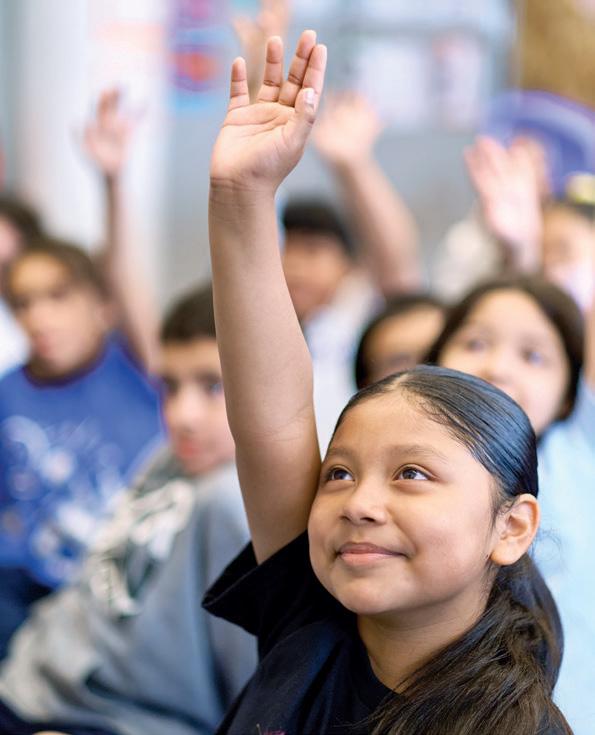
A PUENTE Charter Elementary School student is engaged and excited to answer her teacher's question during their lesson.
workforce readiness component helps students expand their skills and prepares them to enter the job market. In recent years, the gap in college degree completion between Latinx students and their white peers has been on the rise, according to the advocacy group Excelencia in Education. But PUENTE’s College and Career Program helps significantly close that gap.

“M y family and I are proud to support PUENTE Learning Center because we share PUENTE’s vision of a brighter future where high-quality education transforms lives. Regardless of your zip code, income, or ethnicity, everyone deserves an equal chance at success. PUENTE is a well-regarded nonprofit organization with a community-centered, results-driven approach. For almost 40 years, PUENTE Learning Center has built trust with its constituents, and I am grateful for their positive impact on Los Angeles.”
– Jocelyn Rosenwald PUENTE Learning Center Board Member

California Community Foundation
Carl and Roberta Deutsch Foundation
Chris and Melody Malachowsky
Eli and Edythe L. Broad Foundation
Helen and Will Webster Foundation
Johnny Carson Foundation
Los Angeles Lakers Youth Fund
The Orinoco Foundation
Ralph M. Parsons Foundation
The Riordan Foundation
Robert Tuttle and Maria
Hummer-Tuttle
Rose Hills Foundation
Snell & Wilmer
UnidosUS
U.S. Bank
USC – Good Neighbors Program

“RTS gives youth who have experienced foster care the promise that every young person deserves: that chance at graduating from college and a future that they choose. More than 80% of kids in foster care want to go to college, and RTS is there for them when they arrive at its doorstep.”
– Andrew Bridge Lawyer, Author, Former Foster Youth
By Check:
Ready to Succeed 1514 17th St. Ste. 201 Santa Monica, CA, 90404
*Donation Memo: The Giving List
By DAF or Stock Transfer:
Tax ID# 83-2282113
By Credit Card: readytosucceedla.org/donate/
Contact: Romi Lassally Co-Founder and CEO (310) 422-2923 romi@readytosucceedla.org
Ready to Succeed readytosucceedla.org 1514 17th St. Ste. 201
Santa Monica, CA, 90404 (424) 581-6296

RTS Volunteer Phoebe, RTS Co-Founder Romi, and Project Dorm Room Recipient Lily at UCLA Project Dorm Room 2023.
Holdyn Bray grew up in the foster care system without the basics many take for granted – sometimes she didn’t even have a bed. Like many foster youth, she faced steep challenges just getting to college. For these students, moving into a dorm often marks their first time living on their own, but many arrive with little more than a hoodie and a blanket.
Holdyn found help through Ready to Succeed’s program Project Dorm Room, which provides foster youth with must-have dorm supplies and a sense of community.
“Not having to worry about how I could afford items for my dorm room changed my freshman-year experience,” Holdyn says. “It was just one of the many small but meaningful weights they took off my shoulders.”
Ready to Succeed, founded in 2016, provides college-going foster youth students with the resources, relationships, and opportunities graduate college, launch successful careers and reach their full potential.
Each year, approximately 4,000 of California’s foster youth age out of foster care and many are left unequipped and unprepared to navigate the higher education system.
Project Dorm Room, launched in 2017, advances Ready to Succeed’s
mission of college and career success by helping foster youth start off with a solid foundation by providing them with everything they need to make their dorm room a welcoming home.
“Moving is hard enough, but moving into college without support is even harder,” says Tania Suster, Ready to Succeed board member and founder of Project Dorm Room. Suster created the program after realizing that many foster youth face this milestone alone, without the help of family to get settled. She mobilized friends, colleagues, and community members to ensure every foster youth entering UCLA would have the essentials they needed and a volunteer to help them
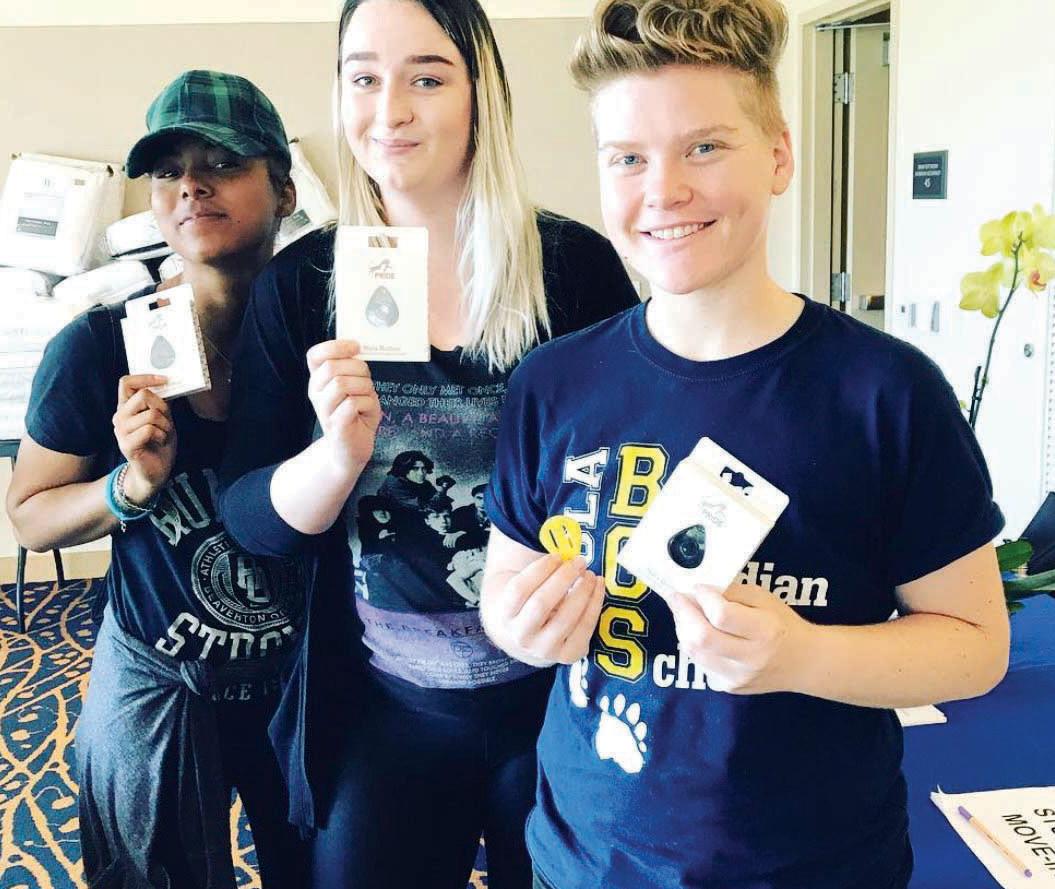

Ready to Succeed’s (RTS) Project Dorm Room began by supporting 75 students and has since equipped over 900 foster youth with the essentials needed for college dorm life. With more foster youth than they can serve, RTS aims to expand their reach and impact next year:
• $225,000 fully sponsors 300 students as they move into their new dorm rooms.
• $750 fully outfits one dorm room.
• $500 provides sleeping and personal items.
Foster youth have faced immense challenges growing up in the system – now, in college, they deserve the opportunity to thrive. Supporting Project Dorm Room ensures these students aren’t overlooked, giving them the foundation they need to succeed.
move in and make their beds. The program has since grown to serve over 300 foster youth per year attending colleges across Southern California and has expanded this year to Arizona State and University of Texas.
The program provides over 50 items of dorm room essentials to foster youth including bedding, toiletries, sheets, blankets, pillows, mattress pads, bath towels, laundry bags, hang-


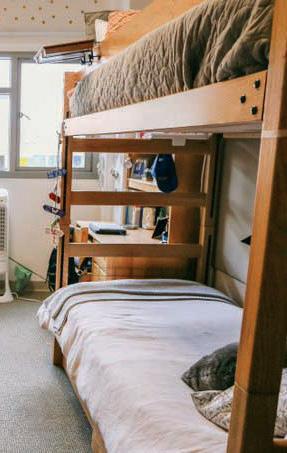
ers, power strips, lamps, shower caddies, school supplies and school swag. By removing barriers from the start, Project Dorm Room allows foster youth to feel prepared and supported and able to focus on their studies and fully engage in the college experience.
Patrick McCabe, Ready to Succeed co-founder and president, says Ready to Succeed scholars graduate at a rate 10 times greater than foster youth nationwide and are far more likely to secure subsequent full-time employment.
For Holdyn, Project Dorm Room was more than just receiving supplies; it was about discovering a supportive community waiting for her after the hard-won achievement of getting into a top-tier university.
“Foster youth are not used to asking for help. We have built a barrier to be ‘strong and resilient’ on our own,” Holdyn says. “Ready to Succeed provided me with a sense of community that I had never experienced. I felt seen for the first time.”
Only 4% of foster youth graduate from a fouryear university nationwide. But thanks to supporters like you, 85% of RTS Scholars graduate and launch successful careers within six months

Ralph M Parsons Family Foundation
The Chuck Lorre
Family Foundation
Sam Simon Charitable
Giving Foundation
Southern California Grantmakers
Nonprofit Sustainability Initiative
U.S Department of Education
Banchik Family Foundation
Arrillaga Foundation
Jess Cagle
Jarl Mohn
Steven Barnett
Todd Kessler
Elizabeth Friedman
Karen Kehela Sherwood
Tania Suster
Emmanual Benton
Jon Gimbel
Eddie Valcin
Deanne Yamamoto
Harriet Zaretsky
Karen Jones
Mark Mosch
Susan Carr


When emergency strikes and people are suffering, we need a swift, compassionate response.
as told to Vicki Horwits

Bonnie Davidoff and Janet Soffer are the cofounders of the Los Angeles Women’s Giving Circle, a philanthropic organization dedicated to supporting programs that benefit the development and well-being of young women in the Los Angeles area.
Bonnie Davidoff, with a background in print advertising sales, found herself seeking a meaningful way to contribute to her community as her children entered college. Her involvement in youth sports and desire to help those less advantaged laid the groundwork for her philanthropic journey.
Janet Soffer, having worked at the Museum of Tolerance for eight years, sought an uplifting project after caring for her father who was suffering with dementia. Her experience in education and passion for community engagement made her an ideal partner in this venture. They both sought a way to be instrumental in giving back to their community while also building a social community among a new group of like-minded

friends. Inspired by an article in the now defunct women’s magazine MORE about giving circles, together they decided to establish their own local giving circle and nearly two decades ago, the Los Angeles Women’s Giving Circle was born.
Giving circles have become more prominent throughout not just California but across the nation and even globally (in West Africa they’re called “Susu”). An Alliance magazine article about the history of giving circles traces the modern version of these circles back to the 1990s with about 50 recorded in 1995. Giving circles began to be popularized among women when working women rose through the ranks in record numbers amassing their own wealth and wanting to distribute it on their own terms. This philanthropic model tends to be place-based, highly-flexible, and democratic.
Today, there are roughly 4,000 giving circles in the U.S. with 370,000 members who, in the last seven years, have collectively given away $3.1 billion (as of 2023).
The Los Angeles Women’s Giving Circle has grown since its founding to include a diverse group of women from various backgrounds all committed to making a difference in their “backyard.” They focus on researching and funding programs that support young women and girls, filling a crucial gap in philanthropic giving. Through their efforts, they’ve not only made a significant impact on numerous local organizations but they have also fostered a strong sense of community and friendship among their members.
Q: What about your backgrounds led you to form the Giving Circle?
Bonnie: I remember my daughters were in college or about to go, and I knew I was going to be an empty nester. I wanted to do something meaningful, to contribute. I was on a hike with my friend Lenore Sokel, who handed me an article from MORE magazine about
happening in our city. I also didn’t want a homogeneous group of women. I wanted a variety of people coming from different walks of life, and that’s what our group represents.
Q: Your Los Angeles Women’s Giving Circle is dedicated to researching and funding programs that benefit the development and well-being of young women in the Los Angeles area. Why did you focus on directing your giving to young women?
Janet: We wanted to have a narrow focus, otherwise we’d be all over the map. Having sons, I didn’t really have access to what was going on for young girls, but I was a young girl once, and it just felt right. It also seemed right to the people we networked with. We’ve revisited our mission statement many times over the years because things don’t stay static. We’ve had to address questions like: What if an organization we

organizations. This rule was a vehicle to allow for a new crop of applicants. It also allows for more variety in the types of organizations we support. You’d like, as a giving circle, to help every organization that comes through your door. By having a rule that institutes a rotation, we feel we’re able to make a larger impact across more organizations.
Bonnie: In fact, being a new organization might be an advantage. With our giving circle, organizations can either choose to submit a written request or come in and meet our members in person and give us their request during one of our meetings. It’s another way we get to know what’s happening in our community, through the organizations that come speak to us. Between heart-wrenching missions and organizational leaders who are articulate and passionate about what they’re doing, it’s hard to say no to them.
Q: Based on your experiences, what do you think the biggest social issues facing Los Angeles are, and how can grassroots philanthropy best address those issues?
Janet: I think homelessness is a major issue.
Bonnie: I agree. Homeless women, in particular, are really underserved and suffer terribly on the streets. While our small organization might not make a big dent in the overall problem, the grants we do give to the organizations we work with are making an impact. That is the power of collective giving.
Janet: The topic of whether to give to an organization dealing with a crisis or one focused on intervention to prevent crises comes up every year. We have organizations that do both. Some try to break the cycle of homelessness, teen pregnancy, or educational gaps, while others deal with daily crises. It’s hard to know which is more effective or where our money will make a bigger difference. It’s impossible to know, so we do the best we can with the money we have.
Q: What’s the secret sauce to having a successful, long-lasting giving circle that doesn’t lose the interest of its patrons or fade out over time?
Janet: First, most of our members have come to us through word of mouth, which helps our organization stay together. Secondly, we put a big emphasis on consensus. We’re not like other organizations where a board does all the work and everyone else just pays
their money. We really talk about things as a group and listen to ideas from all members.
Bonnie: Our giving circle is interactive throughout the process of giving our grants. We research the nonprofits, invite them to make in-person presentations, do on-site visits, and discuss how we can best divide up the grants based on who has asked for what money. And all of that is done with accompanying group discussion. All of our members have a voice. Which also means the social aspect is important. We usually have a half-hour get together plus dinner at our meetings. Being connected to people we’re being philanthropic with helps us understand different viewpoints that are voiced. It broadens our community and creates a different level of camaraderie and interest in each other. And, in the end, it broadens how our giving circle acts philanthropically.
Q: How do you determine success for your giving circle?
Bonnie: One measure of success is our growth. We started with 10 people and have had a fair amount of growth and diversity in our membership. Also, we get a lot of positive feedback from the organizations we donate to. They appreciate our process, how we ask them to present, and that we follow up with visits.
Janet: We’ve also raised the profile of several grassroots organizations in the community. For example, there was an organization called RowLA that started with one person teaching girls from Culver City High School to row. We gave them a boat and equipment, and eventually, they grew to attract big donors like Annenberg. We consider that a success.
Q: Do you think it’s important to be aware of major social issues facing California, or should you let the organizations that come to you bring awareness?
Janet: I think it’s both. While our members, many of whom are lawyers, are very informed, it’s hard to stay abreast of every potential need in California. We all know the larger social issues facing the state but every year we get surprised by an organization that will come in and their mission will fill a glaring need that we simply hadn’t been aware of before. And when it comes down to it, every need for every part of the population is pressing.
Bonnie: Every year our members research to find new organizations. That entails reading, listening, and
“I think the reputation of giving circles has been raised and broadened. Ten years ago, people didn’t know what I was talking about when I mentioned giving circles. Now everybody knows what they are.”
talking about the leading issues facing California but We wrote the mission statement, incorporated,


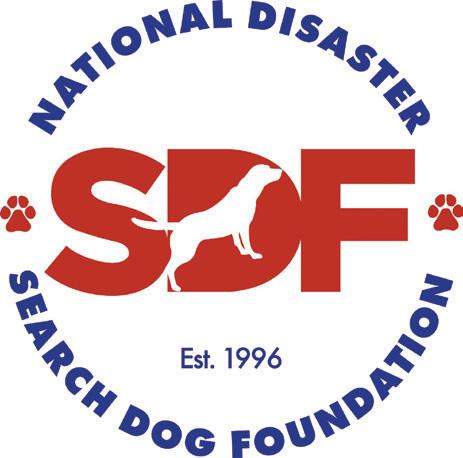
By Check:
National Disaster Search Dog Foundation
6800 Wheeler Canyon Road Santa Paula, CA 93060
*Donation Memo: The Giving List
By DAF or Stock Transfer: Tax ID# 77-0412509
By Credit Card: searchdogfoundation.org/donate
Contact: Rhett Mauck Chief Executive Officer (805) 646-1015 Rhett@SearchDogFoundation.org
National Disaster Search Dog Foundation
www.SearchDogFoundation.org
6800 Wheeler Canyon Road Santa Paula, CA 93060 (888) 4K9-HERO
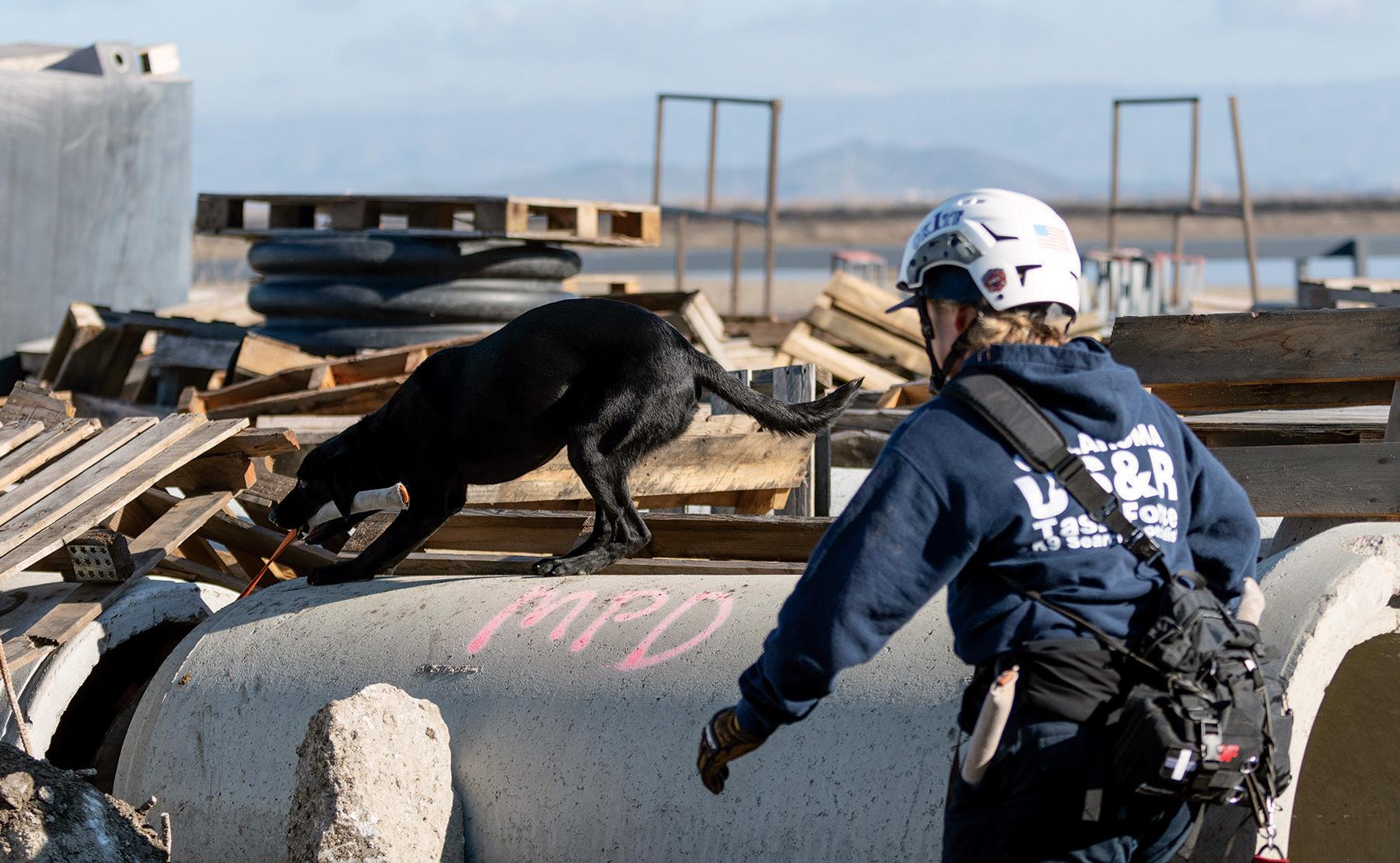
How many times has a family stared in slack-jawed wonder as the adorable new family dog tears around and around the yard like a caffeinated dervish, joyously destroying absolutely everything in sight? They may be looking at a future Disaster Search Dog in waiting. As National Disaster Search Dog Foundation’s (SDF) Wilma Melville has said (with her usual economy of language) – “These dogs need to work. When left alone in a suburban backyard, they destroy the place.” Melville knew that dogs in shelters were often remanded there by families for having exhibited the very character traits that will make them successful rescuers – if not calming, slipper-fetching companions.
In 1996, FEMA-Certified Canine Search Specialist Wilma Melville launched SDF to address once and for all the shortfall of rescue canines in the United States. The year before, she and her partner – a black Lab named Murphy – had spent a week poring over the smoldering rubble of the Alfred P. Murrah Federal Building bombing site. She was struck by how few rescue canines there were to search the site for survivors. In fact, only 15 such certified ca-
nine-human teams existed in the country at that time, all volunteers like herself.
Melville had an epiphany. Why not formalize and optimize canine recruitment and training, partner the dogs with working rescue personnel already well-versed in disaster response? She envisioned a positive feedback loop of rescue: the unwanted dogs rescued from shelters would themselves become trained rescuers. The idea had legs; four legs.
The National Disaster Search Dog Foundation is a 501(c)(3) nonprofit based in Santa Paula, California, which is also the location of the National Training Center – 145 sprawling acres of collapsed structures, large-area rubble searches, train and vehicle wrecks, and wilderness ravines; scenarios that can be reconfigured to keep the dogs’ rescue acuity sharp.
Melville’s brainstorm has changed the dynamic for canine-assisted rescue in disaster areas, domestically and globally. Do all recruited (rescued) dogs pass the training? Most do, not all. But SDF’s dogs are not a “rescue commodity.” They are the spirit of the place. Denise Sanders – Senior Director of Communications & Search
The frequency and strength of recent disasters are stark reminders that they can strike at the heart of any community. In the search for victims, a search dog’s remarkable nose and hard-earned skills mean the difference between days versus minutes, lost versus found, uncertainty versus hope. The National Disaster Search Dog Foundation (SDF) works diligently to ensure canine search teams across America can deploy at a moment’s notice when needed, which includes preparing the next generation of canine heroes.
From the day they arrive on campus to the day they are paired with first responders, SDF spends approximately $60,000 to train a search dog over 10 to 12 months.
SDF is raising $900,000 to train the next search dog graduates. Donors at $20,000 and above can become sponsors of a search dog in training, receiving updates on their progress and milestones throughout their career. Sponsor one or even a pack of canine heroes to be Part of the Search!
Team Operations at SDF – explains.
“It’s not just about the disaster search program,” Sanders says. “Once rescued, these dogs will never have to be rescued again. That is our lifetime care promise to any dog that enters our program.” As they move through the training process, the dogs need to navigate tight spaces, squeeze through small openings, walk backwards up a massive mound of rubble. Some dogs opt out, others can’t get enough.
“Some truly love it, and they just
dance across the rubble! And then there are others that seem to say, ‘Well, if you really want me to … and we’re not going to make them do it at all.” SDF is a rescue dog’s university, family, and best friend. Forever.
“We’ve significantly grown our network of career change options and adoptions,” Sanders says. “It’s about helping each and every dog. We want them to enjoy it. So we say, thank you for being willing, but maybe let’s try something you’ll actually love.”
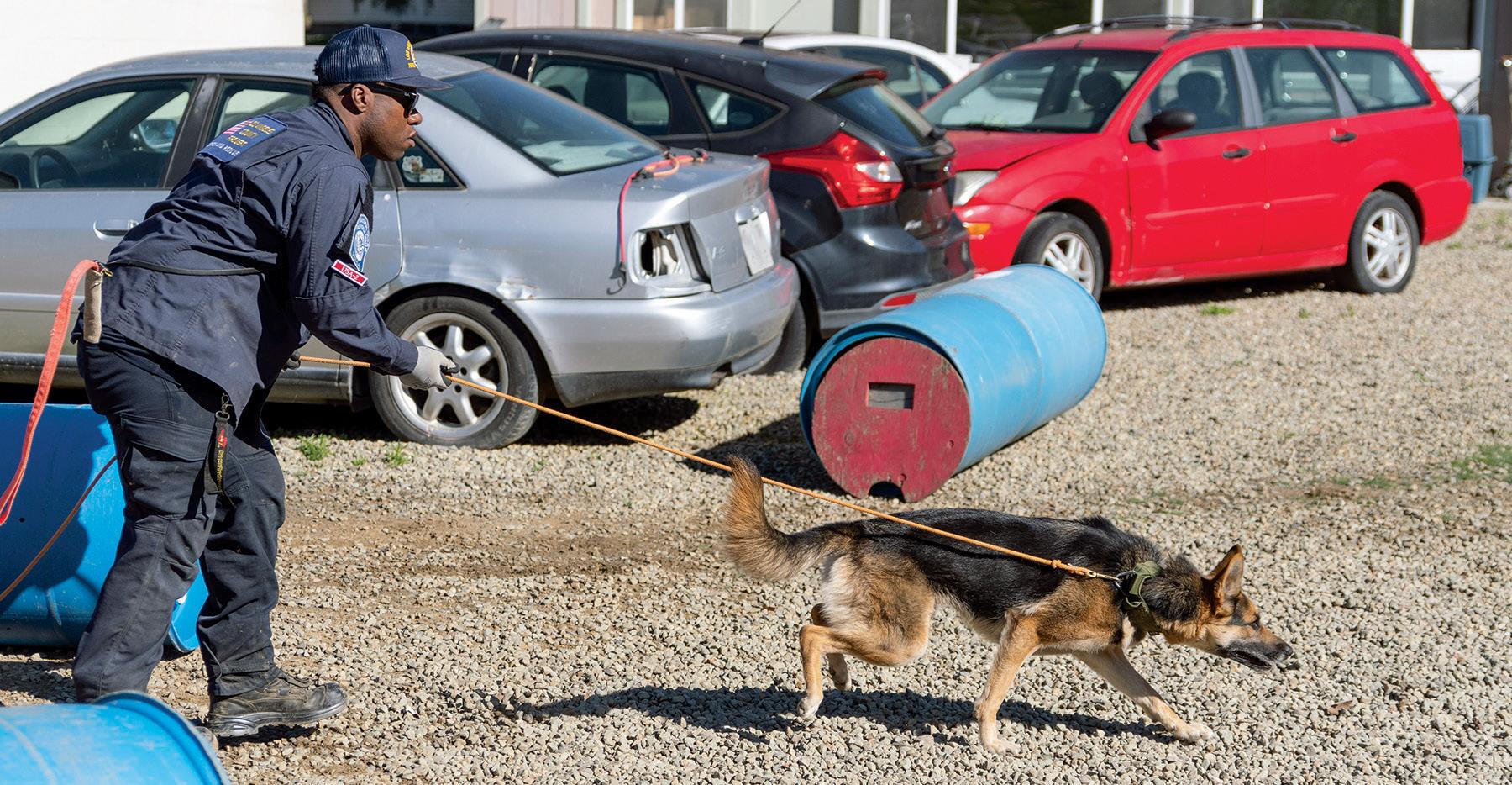
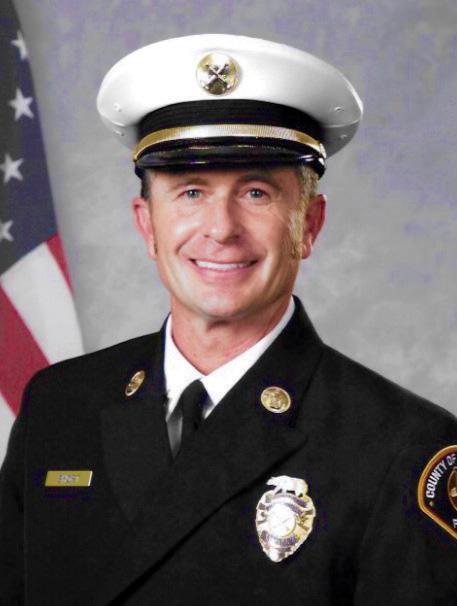
“Over the years, the Search Dog Foundation has forged numerous partnerships with canine disaster search teams that proudly serve the Los Angeles area. We deeply appreciate the presence of these remarkable canines in our ranks, standing as a steadfast resource we can rely on when summoned to action by the Los Angeles County Fire Department and California Task Force 2. Our task force holds the distinction of being one of only two in the nation with the capacity to deploy internationally, and the indispensable role played by our search dogs cannot be overstated. It is of utmost importance to highlight the support provided by the Search Dog Foundation, which generously supplies these canines as invaluable assets to our department and task force. This unwavering commitment ensures that we are perpetually ready and equipped to serve our community whenever the call for assistance rings out. Together, we stand united, ready to bring aid and hope in times of crisis.”
– Gregory Short
Battalion Chief, Los Angeles County Fire Department, Program Manager, California Task Force 2/USA-2
George Leis – Board Chair President and COO, Montecito Bank & Trust
Richard Butt – Board Vice-Chair Retired EVP, Executive Creative Director, VMLY&R
Mike J. Diani – Secretary President, Diani Building Corp.
Christine DeVries Management Consultant
Robert Harris, Battalion Chief, Los Angeles County Fire Dept.
Rhett Mauck, CEO, National Disaster Search Dog Foundation
Sydne Rennie, Attorney, Brownstein Hyatt Farber Schreck
Deborah Whiteley, Communications Consultant
Crystal Wyatt, Leadership in Board Governance and Creative & Sustainable Philanthropy


As an information society, we rely on those who dedicate themselves to exploring, seeking, examining, and understanding the data of the world – so they may relay consequential knowledge and guidance helping us lead the safest, healthiest, and most productive lives possible.
as
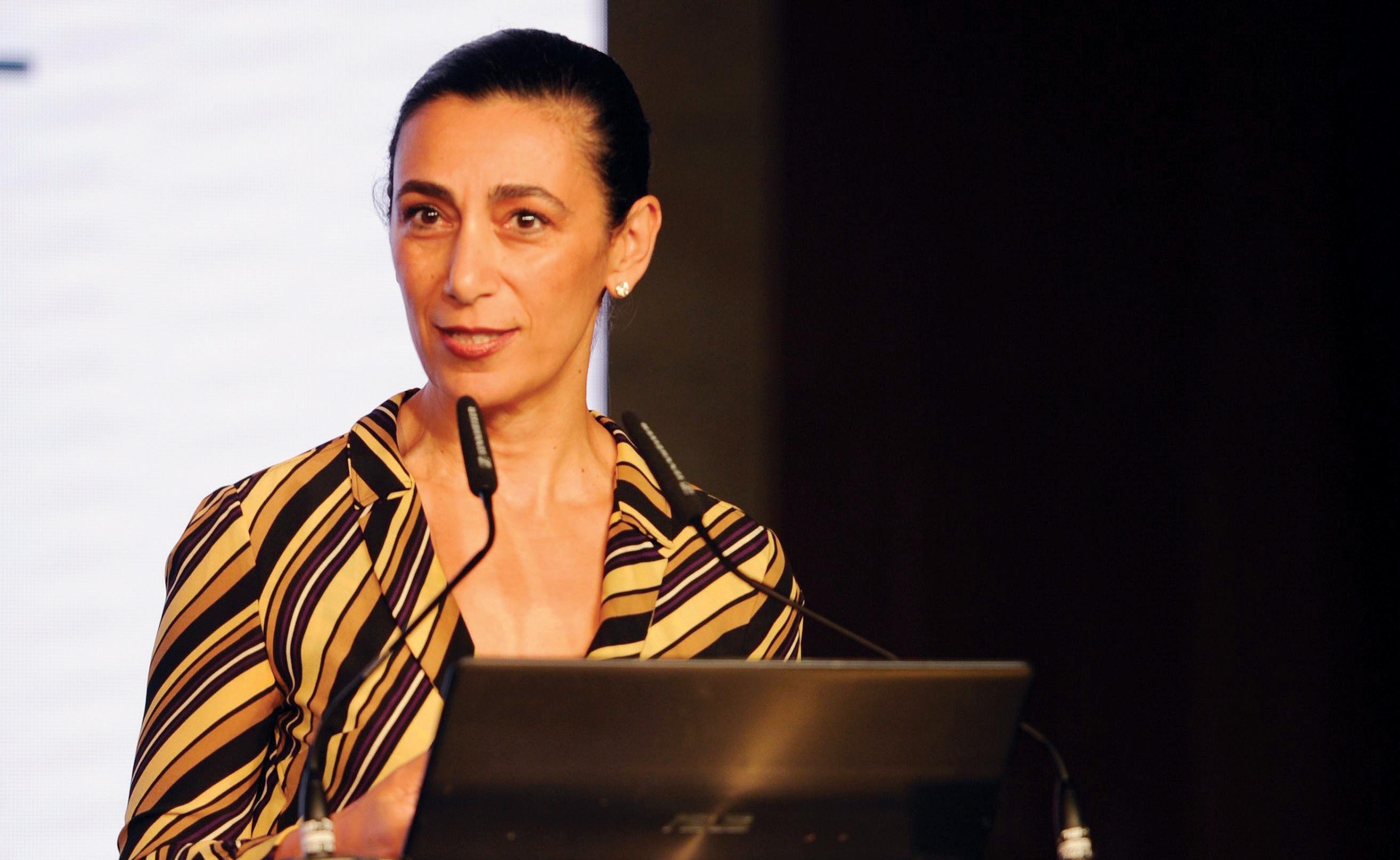
Dr. Sharon Nazarian is a prominent philanthropist, educator, and advocate whose multifaceted career spans academia, foreign policy, and community leadership. Born in Iran, she immigrated to the United States with her family due to the impending 1979 Iranian Revolution, settling in Los Angeles at the age of 10. Nazarian’s background as an Iranian-American Jewish immigrant has profoundly shaped her worldview and professional trajectory.
With a doctorate in Political Science and extensive experience in international relations, Nazarian has dedicated her life to education, diplomacy, and philanthropic endeavors. She played a pivotal role in establishing her family’s foundation, focusing on education as a catalyst for societal change. Her work in-
cludes founding the Center for Israel Studies at UCLA and conducting fact-finding missions to various countries to improve U.S. foreign policy engagement.
In 2017, following the hateful White Supremacist marches in Charlottesville, Nazarian redirected her efforts towards combating global antisemitism, joining the Anti-Defamation League (ADL) in an executive capacity. She is currently President of the Y&S Nazarian Family Foundation and she continues to be a vocal advocate for Jewish students on college campuses and works tirelessly to promote understanding and combat hate in all its forms. Nazarian’s unique perspective as an immigrant, academic, and philanthropist allows her to bridge diverse worlds and make significant impacts in education, community building, and the fight against discrimination.
Q: Your background is quite diverse, with influences from Iranian and Jewish cultures, as well as your experiences in academia and foreign policy. How have these elements combined to shape your current professional and philanthropic work?
Dr. Sharon Nazarian: My background has indeed been a significant factor in shaping who I am today. About a decade ago, I found myself operating in three distinct worlds: philanthropy, academia, and foreign policy. In philanthropy, I had established our family foundation with my parents and siblings. In academia, I was teaching as an adjunct professor and had founded the Center for Israel Studies at UCLA. And
where all four of his children had studied. He didn’t fully understand the difference between private and public institutions; he just knew he had an obligation to give back. That’s when I realized we needed to approach this strategically.
We did a deep dive into education, interviewing every family member to understand their interests and values. We created a proper strategic plan, moving from the idea of charity to true philanthropy. This meant not just writing checks, but having a vision, understanding what we were trying to achieve, and how we could move the needle

democracy, we as a minority can never be safe, as my family and I experienced in our country of birth.
The second focus is combating antisemitism, which I see as a leading indicator of societal problems. When antisemitism is on the rise, it means that society is headed in the wrong direction. I’m trying to bring awareness to this issue, not just within the Jewish community, but to all segments of society – climate activists, LGBTQ+ rights advocates, feminists, Latinos, Asian Americans. I’m saying that this is an assault on everything we hold dear as minorities and as important segments of our society.
We need to come together because the division and antagonism we’re experiencing in our country, often fueled by bad actors like Russia, China, and Iran, is not healthy for our society. We’re really headed in the wrong direction, and that’s where my focus is right now.
Q: You recently wrote an article about Jewish students returning to college campuses amidst rising antisemitism. Can you speak more about this issue?
A: Even before October 7, we were seeing concerning trends on college campuses. There was increasing activism isolating Jewish students, telling them they had to “check their Zionism at the door.” We saw faculty bringing these issues into classrooms where they weren’t relevant, and administrators not taking antisemitic incidents seriously.
October 7 essentially took all of that and scaled it to an unprecedented level. I was teaching a class on global trends in antisemitism at UCLA when it happened, and I saw firsthand how difficult it became for students to talk about Jewish victimhood alongside Palestinian victimhood. There was this binary thinking that both couldn’t be victims simultaneously.
What we witnessed last year on campuses was truly a watershed moment. Universities showed how far hate would be allowed to go, and many administrators were at best unprepared and at worst willing accomplices. It’s heartbreaking to see.
As a community, we’ve had to use every means necessary to address this, from funders pulling out donations (which I’m not a big fan of) to repurposing philanthropic dollars to support Jewish studies, Israel studies, and centers for the study of antisemitism. We need to stay engaged with these institutions and be very clear about how we want our philanthropic dollars invested.
Q: What do you believe is philanthropy’s role in addressing issues in higher education, media polarization, and the spread of misinformation?
A: I think philanthropy has a huge role to play, and in some ways, an outsized role. We have to understand the responsibility that comes with that. On one hand, we need to invest in those who are courageous enough to call out what’s happening, despite the social pressures they may face.
As philanthropists, we have a seat at the table. We are important stakeholders in what happens not only on university campuses but across our society. We have the privilege and responsibility to demand change from leaders who are not stepping up, who don’t understand this moment or cannot meet it adequately.
We also have the ability to invest in those parts of our campuses that are really in need of further understanding. For example, we need to better understand the role of technology and social media in dividing our society. We need to explore where legislation can play a role, despite our commitment to the First Amendment.
As donors and philanthropists, we have to use our dollars in a very targeted way. We have the most important resource – money – along with influence and access. With one phone call, we can reach any university president and potentially make a real difference. We have to use that responsibility judiciously, but also to propel different parts of our society forward, saying we need to do better because we’re headed in the wrong direction.
Q: Your foundation is instrumental in backing education as a catalyst for societal change. What do you see as the biggest impact philanthropy can have on promoting education?
A: The values my parents instilled in me are the tenets upon which we’ve built our philanthropic work: family, giving back, building bridges, investing in impactful parts of our community, and passing this gift to the next generation.
A perfect example of this is our investment in the performing arts center at Cal State Northridge, now named after my mother, the Soraya. This embodies who we are as a family. CSUN serves a diverse community of first-time university attendees, immigrants, and minority communities. By investing in this beautiful building, we’re telling that community that they


Mongabay’s Alejandro Prescott-Cornejo reporting on conservation in Rwanda.


By Check:
Mongabay Org Corp
1259 El Camino Real #150 Menlo Park, CA 94027
*Donation Memo: The Giving List
By DAF or Stock Transfer:
Tax ID# 45-3714703
By Credit Card: mongabay.com/donate

Rhett Ayers Butler describes himself as a lucky child. With collected airline miles from his father’s job and a travel agent for a mother, Butler had seen the wilds of Botswana, Ecuador, and Zimbabwe before he entered high school.
When he was 17, he crouched in a stream in the Malaysian rainforest of Sabah. Butler was wading through the water when he spotted a lone male orangutan, gliding through the trees above.
Butler savored his experiences in Malaysia, eager to return to the rainforest of Sabah. Several weeks after his trip, he learned that the rainforest was set to be cut down to feed a pulp plant. The animals lost their home.
Over the next decade, Butler grew the Mongabay website from a passion project to a leading news outlet for all issues at the intersection of people and nature. On a mission to inspire our communities to take action by providing in-depth coverage on topics most people would never have the chance to learn about, Mongabay has won many victories in the fields of conservation, education, and policy change.
1259 El Camino Real #150 Menlo Park, CA 94027 Contact: Dave Martin Director of Philanthropy (805) 402-3673 dave@mongabay.com
Mongabay mongabay.com
But his time in Sabah remained vivid in his mind. Butler vowed to create a resource about these precious ecosystems so more people would be informed about their importance. He wanted his resource to be educational, open to everyone, and full of pictures that showed the beauty and wonder he had been lucky enough to see firsthand.
And so the nonprofit Mongabay was born.
In 2009, Mongabay fought on behalf of Madagascar, using thoughtful, research-focused journalism to uncover the injustice of rosewood deforestation. As a hotspot for biodiversity, 80% of the species on Madagascar are seen nowhere else in the world – including a flower that has been used to cure pediatric leukemia. Despite being a priority for conservationists, a 2009 political crisis meant that the natural resources of Madagascar became vulnerable to trafficking. Illegal loggers began to tear down the rosewood forests, selling the timber to international furniture merchants. Wildlife and local people suffered.
Wedrove the elephant bird to extinction, nearly eradicated a tree with the potential to treat HIV, and now we watch as the Sumatran Rhino fades into history. Mongabay’s environmental journalism and education do more than inform – they change policy and, in doing so, save lives.
To bridge the gap between science and action, ecological data must be turned into actionable insights that drive changes in our policies, culture, and protection of the planet.
Two months ago, a groundbreaking satellite was launched, capable of assessing plant biodiversity from space. Yet despite these technological advances, much of the available ecological data remains unanalyzed and out of reach.
Mongabay is raising $10 million to launch the Mongabay Data Studio. With your generous support, Mongabay will train journalists to turn this critical data into actionable stories that can save ecosystems, species, and life-saving flora – before it’s too late.
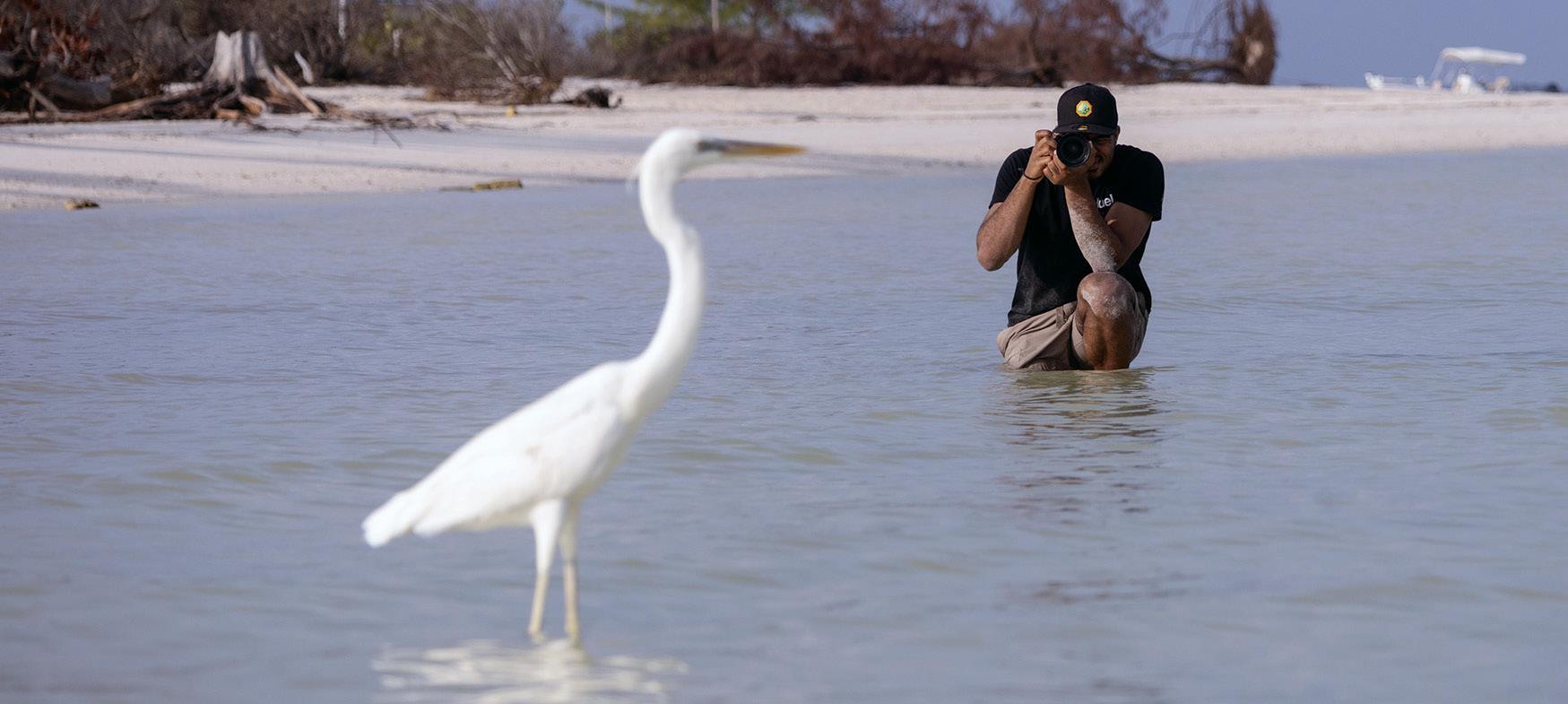
After Mongabay published an investigative report, the European shipping companies responsible for couriering the rosewood committed to stop carrying the timber. Subsequent pressure pushed Madagascar’s transitional government to place a ban on rosewood exports.
Today, Mongabay has multiplied their impact, growing roots in 30 countries, with more than 100 staff members and over 1,000 contributing
journalists around the world.
“A lack of information is one of the major problems we have in actually addressing these issues,” Butler explains. “It is easy to forget that change starts with one person, and it is easier than ever before for someone with an idea to spread it rapidly around the world. And that is the role of good journalism – to give people that spark to work together.”

“M ongabay has a global network of journalists who provide local observations and insights to advance understanding of environmental impacts on the ground. Through their storytelling, Mongabay journalists make complex concepts come alive, elevate the voices of local communities, and touch diverse audiences around the world. The stories are regularly picked up by conventional news outlets, expanding their reach and impact, and moving decision makers to action. We are thrilled to partner with Mongabay in our movement for a healthy climate.”
– Rod Womer & Barbara Karplus Founders of Woka Foundation
Acacia Conservation Fund
Arcus Foundation
Band Foundation
Children's Investment Fund Foundation
Climate and Land Use Alliance (CLUA)
Ford Foundation
Full Circle Foundation
Gordon and Betty Moore Foundation
Hans Wilsdorf Foundation
John F. Swift
Jon Ayers
Khanna Foundation
Laudes Foundation
MacArthur Foundation
Montpelier Foundation
Overbrook Foundation
Packard Foundation
Skoll Foundation
Tilia Fund
Walton Family Foundation

Sea Save’s efforts in driving comprehensive, global ocean conservation policies are essential to protecting marine ecosystems across all oceans, ensuring a healthy and sustainable future for our planet.
Online Giving: Credit Card, Paypal, GPay, Bank or Stock Transfer can be donated at Seasave.org/Donations
By Check:
Sea Save Foundation 20540 Pacific Coast Highway Malibu, CA 90265
*Donation Memo: The Giving List
Contact: Georgienne Bradley Director (310) 463-0777 Georgienne@SeaSave.org

Did you know that millions of sharks endure agonizing deaths each year – all for a bowl of soup? Shark fin soup, considered a delicacy in some cultures, drives the brutal practice of shark finning. Fishermen slice off the shark’s fins, often while the animal is still alive, before casting it back into the ocean to die a slow, painful death. This practice is not only inhumane but also unsustainable, threatening not just sharks but the entire marine ecosystem.
Two decades ago, Georgienne Bradley founded Sea Save Foundation (SSF) with a vision: to protect the health of our oceans, document the challenges they face and develop solutions, and empower people with knowledge and tools to safeguard marine life and create lasting change.
Bradley’s journey began in science. Originally on a path to become a doctor, Bradley’s pivotal moment came when she was offered the opportunity to work with the prestigious Cousteau
Society. It sparked her lifelong passion for oceans. Leaving medical school behind, Bradley founded SSF to tackle the growing threats to our oceans.
“We are very scrappy but formidable,” Bradley says of her all-volunteer, science-driven organization. They bring strength, vigor, and a deep well of knowledge as they work directly with decision-makers to enact policies that prevent problems before they start.
Sea Save Foundation’s impact has been significant. The organization was instrumental in the 2013 legislative proposal that made shark fin possession illegal in California and led a nationwide campaign, resulting in a 2022 federal ban on shark fin possession. By focusing their arguments on the unsustainable nature of shark finning and the economic consequences of collapsing fisheries, they convinced lawmakers across the country to take action.
Recognizing the power of influencing policy, Sea Save Foundation expanded their focus globally. “Oceans
Our oceans cover over 71% of the Earth’s surface, yet they receive less funding than nearly any other philanthropic endeavor. We know more about the farthest reaches of the galaxy than we do about the depths of our own seas.
To continue Sea Save’s vital work, including the weekly publication of the nonpartisan, science-based “Ocean Week in Review” and expand its reach to a wider audience, they need your support. Additionally, in 2025, Sea Save plans on attending the CITES conference in Geneva to advocate for the protection of endangered marine species from trade, and they will participate in the U.N.’s SDG #14 discussions to ensure progress towards meeting global ocean conservation goals by 2030.
But they can’t do this alone. To make these critical campaigns possible, they need to raise $275,000. Your support will enable them to advocate on a global scale and provide vital information to those working to protect our oceans. Together, we can turn the tide for our planet.
do not recognize political borders, so we must work on a global scale to create real change,” says Bradley. SSF now collaborates with the United Nations and has become a respected voice at major international forums such as the Convention on International Trade of Endangered Species (CITES). The organization has been at the forefront in securing protections for species like manta rays, hammerhead sharks, whale sharks, nautilus, and many more.
Sea Save’s influence goes beyond policy advocacy. The organization believes that informed citizens are
powerful agents of change. To that end, they publish the free “Ocean Week in Review” newsletter, offering concise summaries of the latest marine news, from policy shifts and species discoveries to environmental victories and ongoing challenges. This digest helps people stay informed and engaged, even in today’s fastpaced, noisy world.
Bradley says “The tides of change won’t wait, and neither can we. United, we can turn the tide in favor of our oceans, ensuring a future where marine life – and humanity – can thrive. It’s OUR sea to save. Join the pod.”


“As a major supporter of Sea Save Foundation for over a decade, I have seen the tangible global impact they’re making in safeguarding our oceans for future generations. My children and I look forward to receiving the Ocean Week in Review, which has become a valuable resource for keeping up with the latest science and ocean-related news.
As a physician, I am keenly aware that the health of our oceans is deeply intertwined with the health and longevity of human life. The growing presence of microplastics and mercury in the fish we consume is leading to increasingly serious health concerns. Addressing these issues is critical, and Sea Save is on the front lines of this fight.
In the nonprofit sector, creating real change with limited resources is never easy. Sea Save Foundation is a small but highly effective, results-driven organization, and I fully support their vital work.”
– Tom Lee, MD Professor of Emergency Medicine, David Geffen School of Medicine at
UCLA; Founder and Board Chair, Community Partners International
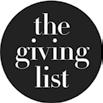
The Sea Save team celebrates a UN victory. Global cooperation is vital to protect ocean health, as domestic efforts can be undermined without international consensus.
...AND LEARN MORE ABOUT THE SEA SAVE FOUNDATION

The Women’s March Foundation is more than a movement; it’s a powerful force for change. By mobilizing grassroots activism, organizing historic marches, and advocating for policies that protect women’s rights, we create lasting impact. Your support fuels our fight to build a world where women thrive.
By
Check:
Women’s March Foundation 10573 W. Pico Blvd. Ste. 71 Los Angeles, CA 90064
*Donation Memo: The Giving List
By DAF or Stock Transfer: Tax ID# 81-4450467
By Credit Card: womensmarchfoundation.org/donate
Contact: Emiliana Guereca President (213) 340-6504 Emi@womensmarchfoundation.org
Women’s March Foundation www.womensmarchfoundation.org 10573 W. Pico Blvd. Ste. 71 Los Angeles, CA 90064 310-200-0124

It was January 20, 2017, after a divisive election and with threats against women’s rights, thousands of women, men, and children pulsed with energy as they began marching on Independence Avenue in Washington, D.C. They flooded the surrounding avenues, their voices rising in unison, their numbers greater than any other gathering for civil rights. The Women’s March had become more than a protest; it was a clarion call for equality, justice, and representation. Emiliana Guereca, the president and founder of the Women’s March Foundation, stood among the sea of faces, recognizing that this was just the beginning.
As the echoes of the chants faded, Guereca faced a stark reality: the fight for women’s rights was far from over. “People think, ‘Oh, you marched. That’s it. We’re going to be okay now.’ But there are so many more issues at hand,” she reflects. The march ignited a movement, but sustaining that momentum required more than annual gatherings – it demanded continuous advocacy and tangible action.
Determined to transform the surge of activism into lasting change, the Women’s March Foundation was
created to tackle critical issues like reproductive rights, equal pay, and childcare and to ensure that the conversations sparked in 2017 evolved into policies and protections. The Foundation strives to continue the movement’s work on a number of fronts – through initiatives, advocacy, and the support of women political candidates, and the dissemination of gender equity information.
Their Feminist Street Initiative sets out to reshape the very map of our cities by working to name streets after influential women – like Sojourner Truth and Ruth Bader Ginsburg. It’s an initiative designed to make women’s contributions visible in the fabric of everyday life. “If girls see themselves in leadership and power,” Guereca explains, “then we’ve done our job.”
Understanding the digital realm as a new frontier for informational activism, the Foundation launched the Digital Divas program. This network of over 300 volunteers combats misinformation and misogyny online, ensuring that truth and equality have a steadfast voice in social media. These digital warriors engage in fact-checking and promote accurate narratives,
The journey from the Women’s March in 2017 to today has been fueled by the passion and contributions of individuals who believe in equality. Now, the Women’s March Foundation invites you to be part of the next chapter. With your support, they aim to raise $1 million to secure the Women’s Building – a beacon for women’s rights and inclusion in the heart of Los Angeles. Every donation brings the Women’s March Foundation closer to a space where women can continue to mobilize, educate, and inspire. Whether it’s $10 or $1,000, your contribution makes a ripple that can lead to waves of change. Together, let’s build a future where equality isn’t just a goal but a reality.
recognizing that the battle for women’s rights also takes place on screens and in comment sections.
By hosting congressional coffees and educational seminars, the Foundation encourages women to run for office and supports them throughout their campaigns. “It takes a woman being asked at least seven times to decide to run for office,” Guereca notes. “If you’re not at the table, you’re most likely on the menu.” Their goal is not just to increase voter registration but to reshape the political landscape with leaders who champion gender justice.
Now, the Women’s March Foundation is embarking on its most ambitious project yet: establishing a Women’s Building in Los Angeles. This hub will serve as a permanent space for organizing, advocacy, and empowerment – a place where the next generation of female leaders can gather, learn, and launch initiatives that will shape the future.
“We’ve been sidelined and invisibilized in far too many areas of society,” Guereca declares. “We’re here to demand and ensure visibility for women and to forge powerful pathways for advocacy.”

“N o woman is free until ALL women are free! By supporting the Women’s March Foundation, you’re not just funding a movement—you’re investing in a future where every woman’s voice is heard, and every woman’s rights are protected. Together, we can turn our collective power into lasting change.”
– Carmen Schaye Volunteer /Donor
- Dedicated individuals who contribute small amounts but make a big impact.
COMMUNITY VOLUNTEERSThose who support through their time and modest financial contributions.
LOCAL LEADERS - Influential figures who champion our cause and encourage community giving.
- Followers who spread the word and contribute small but steady donations.
- Engaged individuals who regularly support our fundraising efforts with $17 average donations.
These supporters are the backbone of our movement, fueling our work with their unwavering commitment and generous contributions.


Looking after the well-being and health of our most vulnerable populations, from seniors to children, from those in local under-resourced neighborhoods to those in rural underdeveloped nations, these organizations put compassion and resources where they are desperately needed.

With a long and fulfilling career in investment banking and investment management under her belt, Miriam Muscarolas is an expert on leveraging philanthropic giving. She brought her invaluable experience to the Weingart Foundation after joining its board of directors in 2008.
An immigrant from Cuba and long-time Los Angeles resident, whose family moved to the United States when she was just a toddler, Muscarolas grew up in a tightly budgeted household leading her to strive to achieve financial independence. While still in high school, she found an opportunity to take a part-time job at Wells Fargo, setting the foundation for her path to receive an invitation to join Wells Fargo’s MBA training program,
and after stints with increasing responsibility at several major banks, joining Kayne Anderson Capital Advisors in 2001 and becoming a partner and senior managing director in 2006.
She took her talents to serve on the board of directors with the Weingart Foundation where she employed her expertise to the cause of leveraging the power of giving for the benefit of economic, racial, and social justice causes. In her capacities, she’s provided people with the same kind of opportunities she was given access to while still a student.
Muscarolas recently retired from the board of directors due to term limits after 16 years of service, but her ties to Weingart’s mission remain as strong as ever. Now a private investor and advisor, she’s also a member of the President’s Council for the NPR Foundation and currently serves on the board of directors for KCRW.
Q: Tell us about the Weingart Foundation and your philanthropic connection with them.
Miriam Muscarolas: The Weingart Foundation is one of the leading foundations in Los Angeles with over $850 million in investments and its giving is dedicated to Southern California. Since its founding over 70 years ago, the foundation has provided over $1 billion in grants to thousands of nonprofits across the region. When I joined, the giving focused on serving the underserved in the areas of health, education, and human services. Around 2014, the board began an assessment of the needs of the communities we served, and began to shift the focus to advancing racial, social, and economic justice in Southern California.
In 2016, the assessment journey was catalyzed by the foundation’s “Equity Commitment” which aimed to base all decisions on promoting fairness and opportunity. The board understood that traditional philanthropy was not sufficient; rather we had to use every tool at our disposal to create impact. We shifted from what had been a conventional portfolio to one that would aim to drive significant societal change while
also pursuing above-market returns. We pursued innovative investment strategies where every manager would be mapped to its ability to optimize impact, diversity, and generate alpha.
Q: In 2019, the Weingart Foundation established the John W. Mack Movement Building Fellowship Program, named for a civil rights activist and former board member. Mack himself is quoted as saying “we need more marathon runners for equality and more marathon runners for justice.” How is the program doing?
both career bound and college bound. Personally and through the foundation, we were able to make investments in skilled trades training offered by the Boys & Girls Club, L.A. Harbor, with Harbor Freight Tools for Schools as a major partner. The skilled trades training helps young people in high school and recent graduates train for high-quality, high-paying, in-demand jobs in the skilled trades such as carpentry, electrical, and plumbing. The students have the opportunity to earn while they learn, get certified, and receive referrals to job placements.
The ability to earn money while they learn distin-


College Match provides high-achieving, low-income high school students in L.A. County the tools and guidance to get into top-ranked colleges with significant financial aid and to graduate with little student debt. College Match students have a 95% graduation rate from 4-year colleges.
low-interest loans and loan guarantees. Helping nonprofits become more credit worthy as measured by traditional credit providers is a huge help. Additionally, investment portfolios can and should be evaluated to align with the funder’s mission. Advocacy and partnerships with other funders can also be very important.
It’s also worth mentioning that publicizing successes is an important part of the process. Communities should want to know that you’re working hard and making progress. Success inspires us to try and succeed again. These are not occasions for modesty. With that in mind learning from things that weren’t as successful, perhaps called “failures,” should to be evaluated with lessons learned and improving next time.
Q: Given the state of politicized and biased media coverage and the proliferation of misinformation, how do you feel the public media is handling their role of being the trusted sources of news and analysis?
A: Part of the misinformation is the idea that the news media can’t be trusted, or that it’s biased, or that we each are entitled to our own facts. So if that’s the belief system, it becomes pretty difficult to gain trust.
NPR reports with high integrity, high journalistic standards with multiple sources, and well-researched facts. Retractions should be rare, quick, and not just in small print. In many communities around the country, the only reliable news source is the public television and radio station. These communities are news deserts as many local sources have shut down.
NPR’s strategy of collaborative journalism, working closely with networks of over 200 local stations, is transformative. When a major event happens in a community, there are local stations on the ground who can be the eyes and ears of the fact-gathering and reporting.
It’s incumbent on the media to do a better job of presenting facts and helping the consumer differentiate between news and opinion. It’s also each of our own responsibility to become better consumers of information, more analytical listeners, and not listen exclusively to sources which only confirm our own opinions.
Q: What are the biggest challenges facing Los Angeles right now?
A: It’s clear that homelessness is a major issue in L.A. Mayor Bass is making progress, but the problem

“We all want a joyful life. Philanthropy can’t save the world single-handedly though. It has to be combined with effective public policy.”
is so large that it’s challenging to move the needle. At the heart of it is the lack of housing affordability in Los Angeles. There needs to be an appetite for us to
of George Floyd, but yet here was another video of a Black man being forcibly dragged from his car at the hands of clearly over-agitated police. Where


“T
he Health Summit truly was an extraordinary day, and all of us at Laura Geller Beauty are grateful to be a small part of this life-changing movement.”
– Laura Geller
Breast Cancer Survivor & Founder, Laura Geller Beauty
By Check: Cancer Schmancer Foundation 23823 Malibu Road Ste. 311 Malibu, CA 90265-4628
*Donation Memo: The Giving List
By DAF or Stock Transfer: Tax ID# 26-0489038
By Credit Card: cancerschmancer.org/donate
Contact:
Susan Holland Executive Director (818) 518-7365 susanh@cancerschmancer.org

In the late 1990s, actress Fran Drescher began a frightening health odyssey, looking for a cause of her gynecologic symptoms that no one seemed able to explain. Over two years she met with eight doctors, none of whom made an accurate diagnosis. Finally, in 2000, she was diagnosed with uterine cancer, a gynecologic disease that usually impacts women after menopause.
At the time, Drescher was the star of the popular network sitcom, The Nanny. She was also just 44, younger than the typical age range for the disease. Her cancer was Stage 1 when it was found and, after undergoing a hysterectomy, she’s been cancer-free ever since.
Yet for Drescher, that diagnosis wasn’t an end, it was a beginning. In 2002, she published the book Cancer Schmancer, which detailed her journey through the labyrinthine medical system. As she toured with the book, she began to hear the stories of countless other besieged and terrified women whose experiences mirrored her own. Drescher knew she had to do something about it. In 2007, she launched
the nonprofit Cancer Schmancer Movement (CSM), whose mission is straightforward and determined: fight cancer through early detection, prevention, and policy change.
“Let’s not get sick in the first place. How’s that for a cure?” says Drescher. What Drescher learned and what CSM operates knowing is that the U.S. healthcare system is a reactive one. CSM’s focus is turning it into a proactive one. Part of CSM’s mission is to help people become informed medical consumers and better partners with their physicians. Early detection relies on awareness and knowledge and CSM educates people about this via its powerful social channels and programs.
CSM also runs mobile cancer screening clinics in New York and offers matching funds to support a variety of organizations that operate lifesaving mobile screenings, bringing early detection opportunities directly to underprivileged and underinsured women and families.
The Cancer Schmancer Movement also advocates a forward-thinking, holistic, whole-body approach to
The Cancer Schmancer Movement has several tiers of giving to support. Its mobile screening matching programs include:
• Tier 1: $1,000 – provides 200 free glucose and blood pressure tests
• Tier 2: $5,000 – provides 1,000 free Pap smear tests, which screen for cervical cancer
• Tier 3: $10,000 – provides 500 free breast exams and mammograms, aimed at breast cancer detection
• Tier 4: $20,000 – provides 400 free bilingual patient navigators, who help with mobile screenings
wellness. Their many initiatives such as the Detox Your Home program guide young people and adults on how to identify and eliminate the causes of cancer and other diseases in their daily routines as a “preventative” lifestyle.
Their annual one-day Master Class Health & Wellness Summit “curates the most innovative and cutting-edge doctors from all fields of medicine to speak and share their latest findings and educate attendees,” says Drescher. “We also release it as an Edu-Series on our website for those who missed it the first time. People say attending our annual master class has changed their lives!”
“There are a lot of ways to keep yourself in optimum health, and no one’s really teaching you how to do that,” says Susan Holland, executive director of CSM. “That’s where we come
in. We’ve built educational curricula about prevention in a very deep way.”
Drescher is also a frequent visitor to Washington, D.C., where she has lobbied for a bill that would ban carcinogens in household products. She was instrumental in helping pass the Gynecologic Cancer Education and Awareness Act of 2005, which authorized the Secretary of Health and Human Services to initiate a national campaign to boost women’s awareness and knowledge of gynecological cancers.
“We are changing Americans from chronic sick-care to thriving healthcare the Cancer Schmancer way! Please lock elbows with me and join the Cancer Schmancer Movement so together we can do what needs to be done, so fewer of us will die prematurely,” says Drescher.
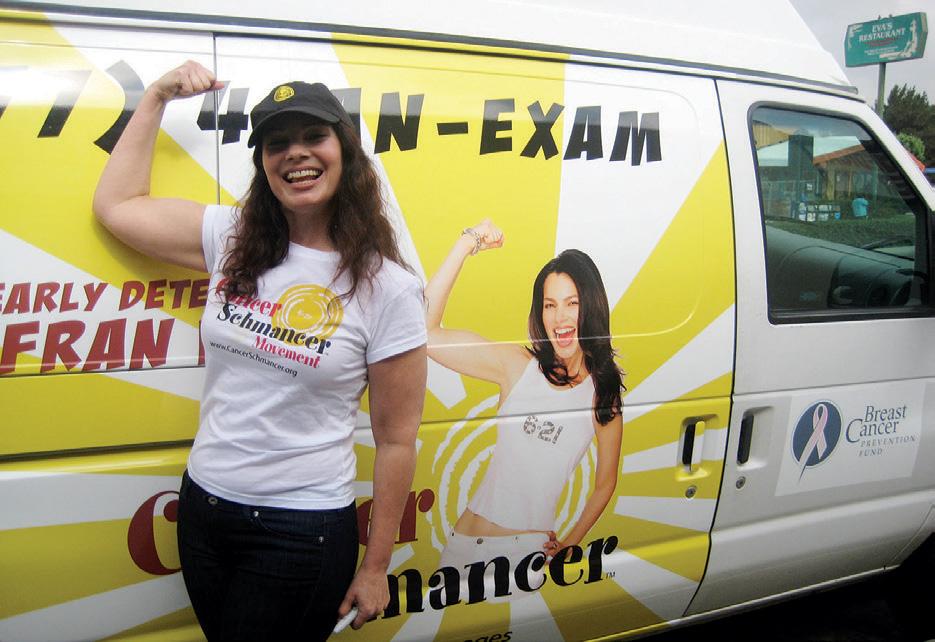


BOARD OF DIRECTORS
Fran Drescher
Reid Drescher
Elizabeth Munson
Lori Levine
BOARD OF MEDICAL ADVISORS
Dr. Daniel Amen
Dr. Dale Bredesen
Dr. Nalini Chilkov
Dr. Aly Cohen
Dr. Kristi Funk
Ken Cook
Dr. Gerry Curatola
Dr. Beth Karlan
Dr. Tom O'Bryan
Dr. Cary Presant
Dr. Antonio Jimenez
Dr. James Urbanic

“I became affiliated with GPER as a parent caregiver to a child su ering with eczema. As an academic psychologist I was not only looking for support, but for evidence-based information. I did not want more recommendations of some lotion to buy and try, instead I wanted to communicate with parents who were likeminded. GPER was exactly what I was looking for: a nonprofit that was not only advocating for better research but openly sharing valuable information with caregivers in need!”
– Angela Tiru Caregiver and GPER Board Member
By Check:
Global Parents for Eczema Research
1117 State Street
Santa Barbara, CA 93101
*Donation Memo: Global Parents for Eczema Research: The Giving List
By DAF or Stock Transfer: Tax ID# 85-3151222
By Credit Card: gper.org/donate
Contact: Korey Capozza Executive Director (805) 232-4479 korey@gper.org
Global Parents for Eczema Research
www.gper.org 1117 State Street
Santa Barbara, CA 93101 (805) 232-4479
When Korey Capozza’s son was born in 2008, he was healthy in every way. But nine months later, he began to develop a rash that got progressively worse. By the time he was two, it covered his body from head to toe. He couldn’t sleep. He couldn’t play or go to daycare. He was so itchy that he would scratch until his skin bled.
“The nights were long and the days an agony,” Capozza said. “We struggled to get the eczema under control with the treatments he was getting from his doctor.” They bounced from specialist to specialist, desperately looking for solutions, until finally they went out-of-state to a hospital with a specialized program for severe eczema.
This journey is typical of those who experience severe eczema. Unlike the more mild form of the disorder, it’s hard to control, involves the entire immune system, and can destroy a child’s quality of life.
Once her son found relief, Capozza, who holds a Master’s in Public Health from the University of California, Berkeley, created a nonprofit, called Global Parents for Eczema Research (GPER), to help other families like hers.

Eczema is more than just 'a baby rash' — it’s a serious condition that can lead to painful flareups and even hospitalizations. This brave little one is facing the challenges of severe eczema, a struggle many don’t see or understand.
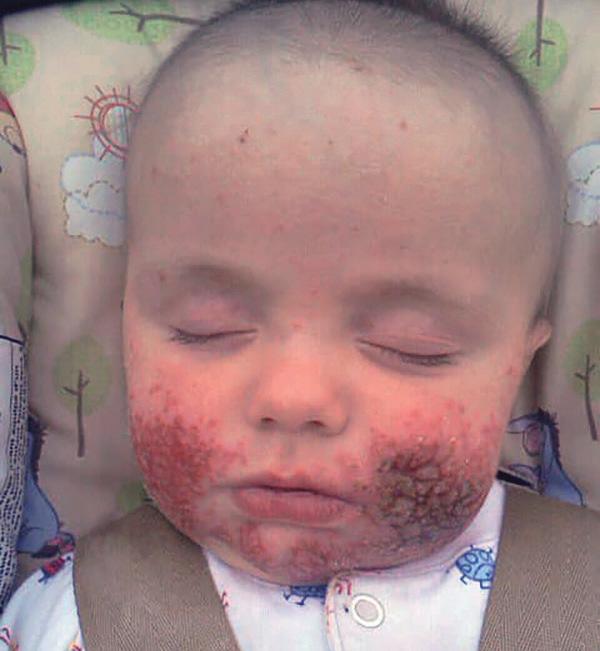
GPER navigates the maze of diagnoses and treatment, and advocates for research and policy changes to advance evidence-based care approaches.
Since its launch in 2015, GPER has grown in scope and members, but it remains a grassroots organization with just seven people working to support families besieged by severe eczema. Their Support for Eczema Caregivers (SEC) program is a “lifeline” for parents. Parent coaches work with other families in small groups to help them deal with the often overwhelming skin care routines and cope with the grief and anxiety that can come up.
The program now reaches over 2,000 families worldwide. GPER also o ers a free app for the program and a web-based hub for caregivers featuring a set of holistic resources, from meditations to tools related to cognitive behavioral therapy and stress reduction.
Their annual Big Ideas Contest invites patients and caregivers to submit their ideas for research with the chance to earn monetary prizes and potential research partnerships or funding for their ideas. The driving notion behind the program is
Parents for Eczema Research hopes to raise $100,000 this year to double their research program in 2025 and accelerate their progress towards a cure by 2030, which is the vision of their organization.
They are funding research in three specific areas which show the most promise in preventing eczema in babies:
• Interventions to improve the gut microbiome
• Strategies to improve the skin barrier
• Ways to avoid environmental exposures that increase the risk for eczema in children
Your donations will help fund research that gets us closer to a world where no child has to su er from childhood eczema.

that families have insights that could lead to better treatments or a cure but their knowledge is currently ignored.
Because making sense of therapy and treatment options is increasingly confusing for parents, GPER guides parents through treatment decisions with its online navigator developed using clinical trial data and is presented in a parent-friendly format. “Most parents don’t have the background –or the time – to read dense, scientific articles about eczema treatments.
“Our podcast and navigator programs do the heavy lifting for them by breaking down the research in an easy-to-understand way,” says Capozza.
From parents to researchers, clinicians, and experts, Global Parents for Eczema Research come together with one goal: improving lives for children with eczema. United by their passion and driven by science, they work to advance understanding, treatments, and support for families all over the world.
Capozza’s son is now 15 and thriving. With more treatments available for children, GPER is now focusing its research grants program on finding a cure for eczema and investing in science that will uncover the causes of the condition.
“We have to find answers because millions of children still su er from eczema – and more babies are born with it every day,” says Capozza. “My son was the inspiration to start GPER back in 2015, but now, it’s really about the other families,” she says. “So many of them are still in the thick of it, and as someone who has been there, I’m passionate about changing their trajectory.”
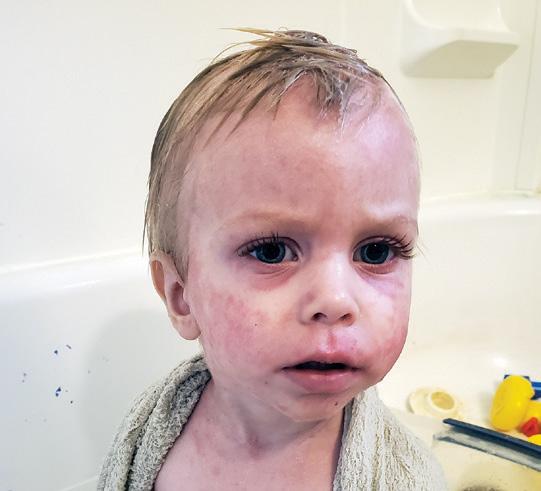
Parents use many tools and treatments, like soothing oatmeal baths, to help relieve the discomfort of eczema. At Global Parents for Eczema Research, they're on a mission to advance primary and secondary prevention strategies, so families can focus on thriving, not just managing symptoms.

BOARD MEMBERS:
Dr. Je Mcbride, Board President: Dermatologist, University of Oklahoma, USA
Santanna Hernandez, Board Secretary/Treasurer: Mother of four children with eczema and medical student, Canada
Dr. Ian Myles, Board Member: Head of the Epithelial Therapeutics Unit at the National Institute of Allergy and Infectious Diseases, NIH, USA
Dr. Peck Ong, Board Member: Pediatric Immunologist, University of Southern California and Children’s Hospital Los Angeles, USA
Angela Tiru, Board Member: Professor of Psychology and Eczema Parent, USA
CORPORATE SPONSORS:
Galderma
Incyte
Sanofi
Amgen
Kyowa Kirin
Regeneron
Lilly
Leo
Astria
Dermavant
Pfizer
Pierre Fabre
Smart and Final

Metta Sandiford-Artest, L.A. Laker legend, inspired everyone at the Gen Z Wellness Summit with his message of “staying true to oneself and the importance of taking care of one’s mental health.”
By Check: The UCLA Foundation P.O. Box 7145 Pasadena, CA 91109-9903
Donation Memo: UCLA Foundation Friends of the Semel Institute Fund #61200C - The Giving List
By DAF or Stock Transfer: Tax ID# 95-2250801
By Credit Card: engage.ucla.edu/give/460742
Contact: Wendy Kelman, MSW Executive Director (310) 825-3119
WKelman@mednet.ucla.edu
Friends of the Semel Institute for Neuroscience and Human Behavior www.friendsofsemelinstitute.org 760 Westwood Plaza C7-463 Los Angeles, CA 90095 (310) 825-3119

The study of the human mind and the myriad associated maladies that can arise from it is considered by many to be the last great frontier of modern medicine. The Semel Institute for Neuroscience and Human Behavior at UCLA is a worldrenowned multidisciplinary research institute that is blazing a trail at the forefront of that frontier.
Mental illness is so common in the U.S. that it affects more than one in five adults, approximately 57.8 million people, according to the National Institute of Mental Health. Chances are, if you aren’t affected yourself, someone in your family is. And that is exactly how Vicky Goodman came to found Friends of the Semel Institute. Approximately 30 years

Helena Hansen, MD, PhD, Interim Director of the Semel Institute, moderated a discussion with UCLA experts about the teen mental health crisis and what parents, families, and educators can do to support their kids.
ago, her daughter, then an Ivy League undergraduate, was diagnosed as bipolar. She was treated at UCLA, and ultimately went on to earn her PhD in psychology, get married, and lead a successful life.
Having successfully traversed the daunting road necessary to navigate her daughter’s mental illness, not least of which was battling the societal stigma, Goodman wanted to give back. “If we could help other families navigate this challenging process and not be completely blindsided, then that would be making a difference.” And so Friends of the Semel Institute was born.
The organization realizes Goodman’s ambition of giving back in many significant ways. The free “Open Mind Community Lecture and Film Series” brings together thought leaders in science and culture for programs about mental health issues, both virtually and in person. The Friends of Semel Research Scholar Program awards grants of $25,000 per year to early career investigators for their research in neuroscience and human behavior, leading to new treatments and research breakthroughs. Executive Director Wendy Kelman notes that “the grants keep the best and brightest in a field that often loses them for lack of grant funding, crucial to their continued success.” Like Goodman, Kelman knows first-hand
TheFriends of the Semel Institute for Neuroscience and Human Behavior at UCLA is dedicated to improving the lives of people with mental illness through research, educational programs, and advancing treatments.
• $1,000: Helps fund the Teen Advisory Council and its Gen Z Wellness Summit 2025, where over 600 teens have conversations about their unique mental health issues. Tools and solutions are provided so they can become emotionally sturdier and more resilient.
• $2,500: Supports the educational Open Mind Community Lecture and Film Series. 25-30 programs anually about mental health with thought leaders in culture and science are presented.
• $5,000 - $10,000: Helps support mental health research, treatment, and education.
• $25,000: Naming Grant. Supports the research of a UCLA early-career neuroscientist through the Friends Research Scholar Program. The grant may be named for you, your family, or anyone you would like to honor.
the devastating effects mental illness can cause: her own sister, diagnosed as bipolar, ultimately took her own life.
In response to the teen mental health crisis, The Friends founded a Teen Advisory Council, a diverse group of students from high schools throughout the Los Angeles area, dedicated to mental health education, reducing stigma, and advocating for the mental health of high school students. Their efforts culminate in a free, public Gen Z Wellness Summit.
Another initiative to address teen mental health is the Open Mind Film Festival for high school students that invites teens from throughout the U.S. to submit short original films related to mental health. In 2024, over 240 films were submitted, the top 10 films were screened at the festival and cash prizes were awarded.
Since its founding five decades ago, neuroscientists and clinicians at the

The Friends is working to transform the understanding and treatment of mental illnesses. 1 in 5 adults in the U.S. lives with a mental illness. Since 2021, more than 4 in 10 (42%) high school students felt persistently sad or hopeless and nearly one-third (29%) experienced poor mental health. More than 1 in 5 (22%) high school students seriously considered attempting suicide and 1 in 10 (10%) attempted suicide.

Semel Institute have been working diligently to identify the causes and consequences of disorders of the mind and brain. They have had great success, but there is so much more work to be done to help those whose lives are still greatly impacted.
Selena Gomez Rare Impact Fund
Deloitte
Unlikely Collaborators
The Wonderful Company
The Ornest Foundation
Friars Charitable Foundation
Madhappy


























